the R ecoRd
 BLESSED POPE JOHN PAUL II SOUVENIR EDITION
BLESSED POPE JOHN PAUL II SOUVENIR EDITION

Still with us
Last Sunday’s memorable beatification of Pope John Paul II was an historic moment, both in the life of the modern Church and on the global stage. As priest, Bishop and, for nearly 28 years of his life, the 264th Vicar of Christ, he had a profound, life-changing influence on those around him and millions around the world. But what remained at the core of his life was his love of God and of all human beings. The beatification was overwhelmingly about one thing, the intimate relationship with God that all are called to and which the Church calls sanctity. Beatification recognises he is now in heaven, and no-one doubts John Paul II is , in a real sense, closer to all of us than ever before...
JohnPaulIIbooks,resources Backcover
Hundreds around Perth celebrate
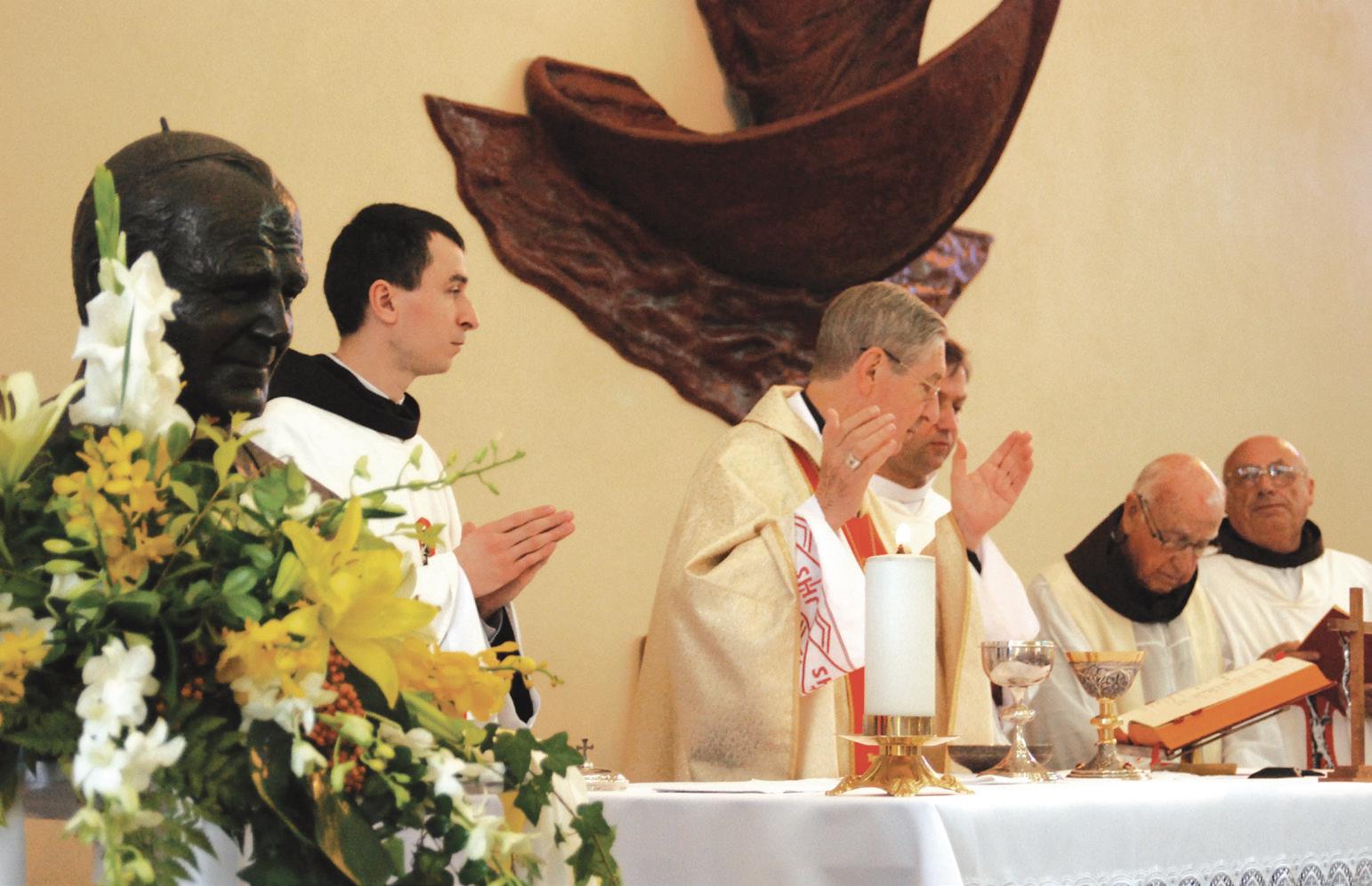
 By Anthony BArich
By Anthony BArich
HUNDREDS packed out to overflowing churches across the Archdiocese as a number of Masses were offered celebrating the beatification of the “indefatigable” Pope John Paul II on 1 May.
For the Polish-Australian Catholics who attended services around Perth and those around the world celebrating the Pope’s beatification, it was merely confirmation of what they already knew. Many lined up to
If
Polish Franciscan Frs Maciej Kaczmarczyk, Piotr Rzucinlo, Stanislaw Tomasiak and visiting 29 year old Fr Lukasz Kwiatkowski - who is heading to a Papua New Guinea mission where what is believed to be the world’s first church dedicated to John Paul II was built – concelebrated Mass at Our Lady Queen

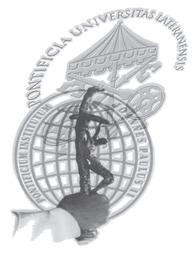

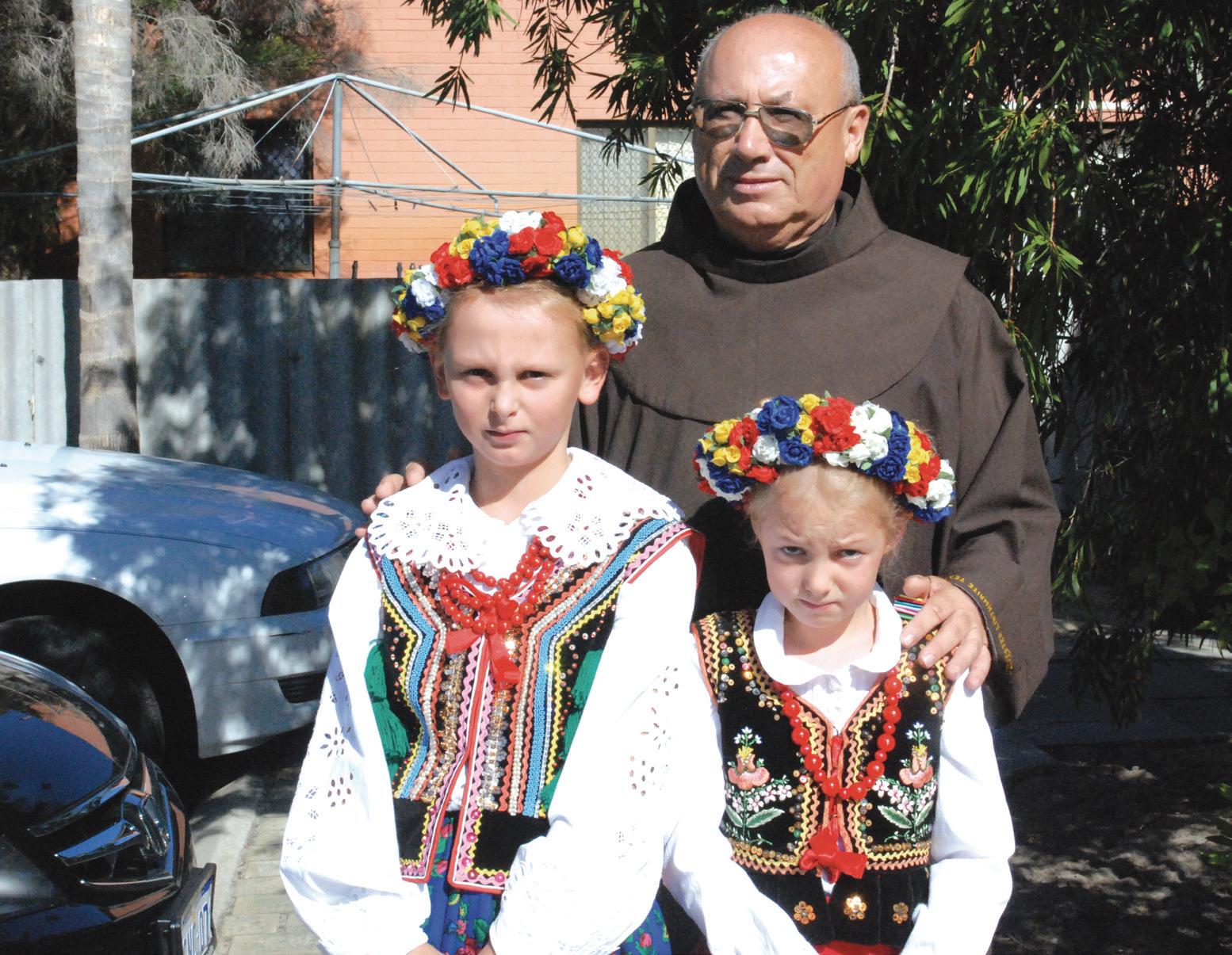
of Poland Chapel in Maylands for over 500 people at 11am. Australian Fr Michael Brown OFM also concelebrated.
Archbishop Hickey said the many other celebrations around Australia proved he was truly a Pope for the whole world.
The Maylands Mass was the first in a series of events throughout the Archdiocese marking the special day, with hundreds more attending Masses offered by the Archbishop at St Mary’s Cathedral at 11am and by Polish Salvatorians at St Lawrence’s Church in Balcatta in the afternoon.
A special Divine Mercy Mass was also offered in the Cathedral at 2pm, as the Pope initiated Divine Mercy Sunday – the second Sunday of Easter - in 2000, the Jubilee Year. The Divine Mercy Mass was concelebrated by St Charles’ Seminary Rector Mgr Kevin Long and Frs Paul Fox, Hugh Thomas CSsR, Andre Mary Feain FI and Marcellinus Meilak OFM. The service also included a Divine Mercy Chaplet, Benediction, two Rosaries and readings from Pope John Paul II and St Faustina Kowalska, the Polish nun whose visions of Christ telling her to propagate the message of Divine Mercy are the foundation of the devotion that has since spread through the Church.
North Beach-based Sister Joseph of the Holy Family of Nazareth, a Polish-founded Religious Order that the late Pope knew well, said John Paul II was “chosen from the beginning as someone to look up to”, especially in a country where Catholics suffered for their faith.
“We all believed he was very special and holy, even since he was a young man, so the beatification is confirmation of what we always knew,” she told The Record
John Paul II not only inspired the Polish nation to liberate itself from Communist shackles but spread devotion to Mary through
his own love for Our Lady and showed the world what it was to be a Christian, Archbishop Hickey said.
John Paul II was known not only by Catholics but by the whole world because of the many areas in which he was so active, including his teachings and writings on morality and on Jesus the Redeemer, which were always clear, concise and persuasive.
“He stood up to atheism, especially Communist domination in Europe and his home country. His victory over Communism was achieved through his powerful witness. He was indefatigable in his travels, his speeches, his pastoral work, reaching out to the poor and downtrodden.”
Sr Joseph, who hails from the Congregational house in Krakow where the late Pope was the Archbishop before his elevation to the papacy, said Catholics made every effort humanly possible to catch the limited train services to where he spoke when he returned to Poland as Pope, despite the persecution they suffered. People were pulling others through closing doors onto crowded trains just to get to the Shrine of Our Lady of Chestachowa, where he prayed and spoke during his historic visit in 1979 in only his second apostolic voyage, she said.
Her family travelled to Chestachowa annually to hear then-Cardinal Karol Wojtyła preach at the shrine of the Black Madonna – which is also the patron of the Maylands church on Eighth Avenue and of Poland.
They made the trip because her father, like many Poles, had a great affection for Cardinal Wojtyła and for Our Lady to whom he had consecrated their children after his wife died when Sr Joseph was nine.
Sr Joseph got to know John Paul II personally through her many meetings with him in Rome. He often visited her Order’s retreats when he was Cardinal.
have their photo taken with busts of the late Pope at Maylands and St Mary’s Cathedral made by Perth sculptor Gerry Darwin who also created the three-dimensional Stations of the Cross in the Cathedral.
Archbishop Barry Hickey offers Mass with Perth and visiting Franciscans at Our Lady Queen of Poland Chapel in Maylands to celebrate the beatification of Pope John Paul II, with a bust of the late Pontiff beside the altar.
Holy Family of Nazareth Sister Joseph with Maylands parishioners Isabella Brozek, 8 and Konrad Rucki, 8 after Archbishop Hickey offered Mass marking John Paul II’s beatification on 1 May at Our Lady Queen of Poland Chapel in Maylands.
Maylands parishioners Karolina, 9 and Justyna Dzieciol, 6, with Franciscan Fr Maciej Kaczmarczyk outside Our Lady Queen of Poland Chapel in Maylands on 1 May. PHOTOS : ANTHONY BARICH
For the beatification the Ocean Reef parish organised a prayer and power point presentation during Mass. Parish Priest Fr Darek Krzysztalowicz SDS, above, stands beside the shrine erected for the occasion while two parishioners kneel before it. A movie night with a film celebrating the life of Pope John Paul II was held on Sunday evening.
BLESSED POPE JOHN PAUL II SOUVENIR EDITION
PHOTO: TERRY WILSON
you’re inspired by the
of
John
II, why not consider studying
the John Paul II Institute in Melbourne. In
the Institute is
the following two-week intensives which focus on
II’s thought
relation
love: To find out more, visit www.jp2institute.org or call the Institute on (03) 9417 4349 photo by john casamento ARCHDIOCESE OF MELBOURNE John Paul II Institute for Marriage & Family 10 YEARS 2001 – 2011
Intensives at the JPII Institute Studying at the Institute can take the form of a Graduate Diploma, Master’s or PhD degree. Alternatively students can simply enrol for individual subjects (such as the above intensives) without pursuing a formal qualification. • The Theology of the Body 18th-29th July Dr Oana Gotia Visiting lecturer from the Pontifical Lateran University in Rome • Love, Freedom and Identity in the Thought of Karol Wojtyła 18th-30th July Rev Prof Jarosław Kupczak OP Visiting lecturer from the Pontifical University of John Paul II in Kraków, Poland
legacy
Pope
Paul
at
July,
offering
John Paul
in
to the person and human
Winter
Pope John Paul II beatification
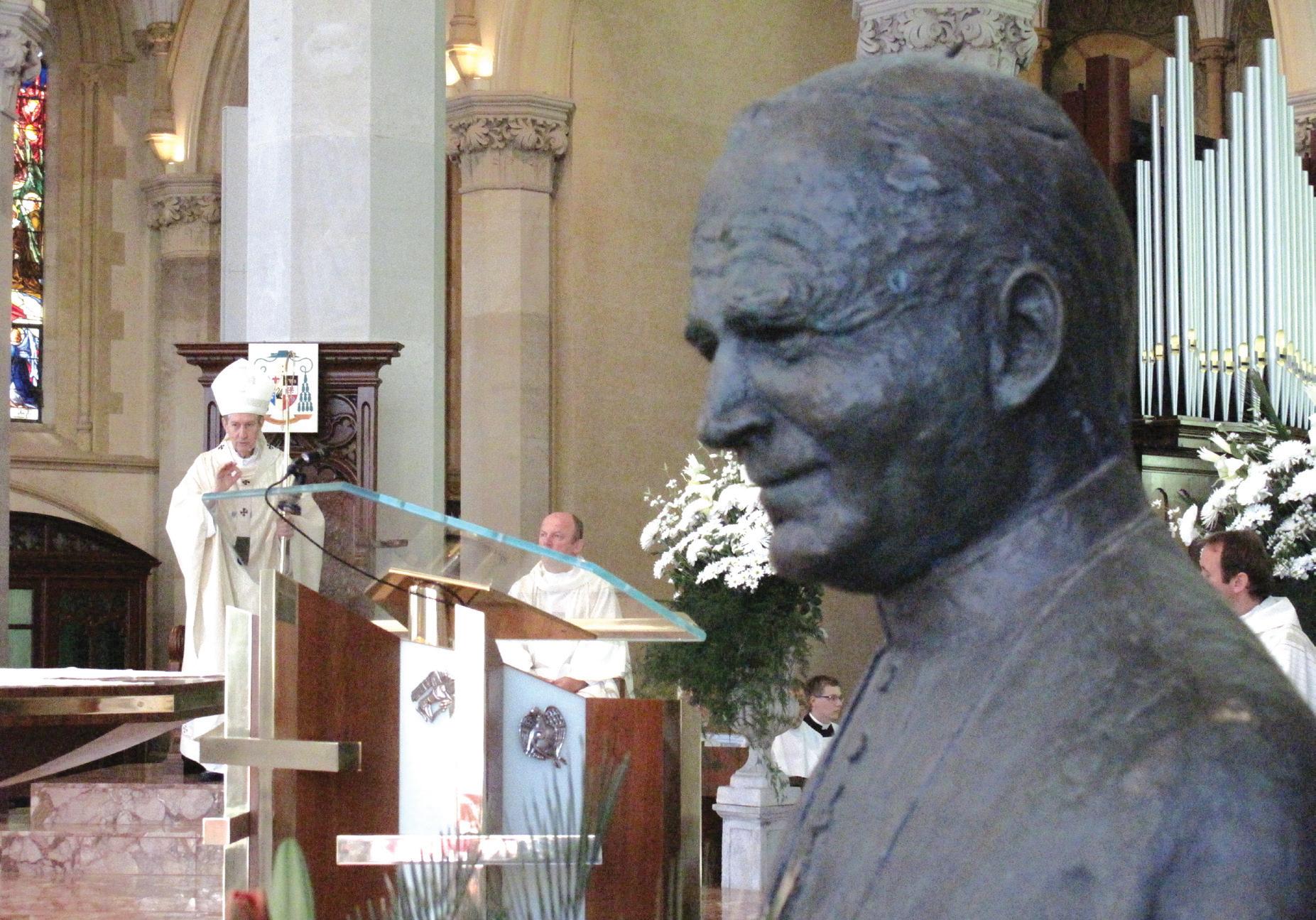

in brief...
‘Sex in modern times’ at Balcatta
THE “JPII Group” invites young people to an eightsession series of Into the Heart, a screening and discussion of the Theology of the Body. Every third Sunday of the month starting on 15 May, the group - named after the late John Paul II whose collection of talks on sexuality and humanity have become known as the Theology of the Body - will host the sessions at St Lawrence Parish, 394 Albert Street, Balcatta, from 7.15-9.30pm. Supper is included.
The JPII group was formed at Balcatta parish.
Bookings are essential. Email the JPII Group at jp2group@hotmail.com or phone the parish on 9344 7066.




Maranatha InstItute for adult faIth forMatIon
Maranatha is offering courses at Newman Sienna Centre 33 Williamstown Rd, DOUBLEVIEW
Commencement Date: Tuesday 10th May 2011
Term 2 Daytime Courses Timetable - 8 weeks cost $50.00
Tuesday (10th May – 28th Jun) 9.30am-12pm Creation Spirituality with Sr Shelley Barlow 1pm – 3.30pm Sainthood & Mary MacKillop – A Saint for all Australians with Dr Judith Woodward
Thursday (10th May – 28th Jun) 9.30am -12pm The Gospel & Letters of St. John with Sr Shelley Barlow
Friday (13th May – 1st July) 9.30am-12pm Parish Bereavement Support Ministry with Gerry Smith
Term 2 Evening Courses Timetable - 6 weeks cost $35.00
Mondays: (16th May – 20th Jun) 9.30am-12pm Beginning Theology (Module 2 Word of God) with Sr Philomena Burrell
Wednesdays: (18th May – 22nd Jun) 1pm – 3.30pm “The Stranger in our Midst” The Church’s outreach to migrants and refugees with Dr Judith Woodward
Units for Term 2 being run in the Morley Parish (Contact: (08) 9271 5253)
Tuesdays 10th May – 14th June, 7.00pm -9.00pm Introduction to the Bible with Sr Philomena Burrell. Cost: $30.00
Fridays 20th May – 10th June, 9.30am – 12.00pm Mary, Mother and Disciple with Jan O’Connor Cost: $20.00
For Enrolments & further Information
Phone: 9241 5221 Fax 9241 5225 Email: maranatha@ceo.wa.edu.au or Website: www.maranathacentre.org.au
The bust of Pope John Paul II by Perth sculptor Gerry Darwin, who also did the three-dimensional Stations of the Cross in St Mary’s Cathedral, sits on the elevated sanctuary in St Mary’s Cathedral during a special Mass Archbishop Barry Hickey offered on 1 May marking the beatification that day in Rome of the late Pontiff.
PHOTO: PETER ROSENGREN
Above, Polish Redemptoris Mater seminarian Grzegorz Rapcewicz with Fr Irek Czech SDS at Balcatta. Below, local youth Bridget Curran, Bronia Karniewicz, Joanna Lawson and Tom Gourlay watch the live beatification broadcast at Balcatta on 1 May.
PHOTOS: BRIDGET SPINKS
Polish Franciscan Fr Maciej Kaczmarczyk raises the Lectionary after proclaiming the Gospel in Polish during the 1 May Mass at Our Lady Queen of Poland Chapel in Maylands.
PHOTO: ANTHONY BARICH
Polish Salvatorian Fr Irek Czech incenses the Blessed Sacrament before leading a Divine Mercy Holy Hour at his parish, St Lawrence and Mary Immaculate in Balcatta, ahead of Pope John Paul II’s beatification on 1 May.
PHOTO: BRIDGET SPINKS
BLESSED POPE JOHN PAUL II SOUVENIR EDITION
For Pope John Paul II, spiritual journey marked path to beatification
BY JOHN T HAVIS Catholic News Service
VATICAN CITY - As Church officials keep emphasising, Pope John Paul II is being beatified not for his performance as Pope, but for how he lived the Christian virtues of faith, hope and love.
When the Vatican’s sainthood experts interviewed witnesses about the Polish Pontiff, the focus of their investigation was on holiness, not achievement.
What emerged was a spiritual portrait of Pope John Paul, one that reflected lifelong practices of prayer and devotion, a strong sense of his priestly vocation and a reliance on faith to guide his most important decisions.
More than leadership or managerial skills, these spiritual qualities were the key to his accomplishments - both before and after his election as Pope in 1978.
From an early age, Karol Wojtyla faced hardships that tested his trust in God. His mother died when he was 9, and three years later he lost his only brother to scarlet fever. His father died when he was 20, and friends said Wojtyla knelt for 12 hours in prayer and sorrow at his bedside.
His calling to the priesthood was not something that happened overnight. It took shape during the dramatic years of World War II after a wide variety of other experiences: Among other things, he had acted with a theatre group, split stone at a quarry, written poetry and supported a network that smuggled Jews to safety.
Wojtyla’s friends of that era always remembered his contemplative side and his habit of intense prayer. A daily Mass-goer, he cultivated a special devotion to Mary. In 1938, he began working toward a philosophy degree at the University of Krakow. A year later, the Nazi blitzkrieg of Poland left the country in ruins.
During the German occupation, Wojtyla began attending weekly meetings called the “living Rosary” led by Jan Tyranowski, a Catholic layman who soon became his spiritual mentor. Tyranowski introduced him to the 16th century Spanish Carmelite mystic, St John of the Cross, who would greatly influence the future Pope.
Wojtyla called Tyranowski an “apostle” and later wrote of him: “He showed us God much more immediately than any sermons or books; he proved to us that God could not only be studied, but also lived.”
At a spiritual crossroads in 1942, Wojtyla entered Krakow’s clandestine theological seminary.
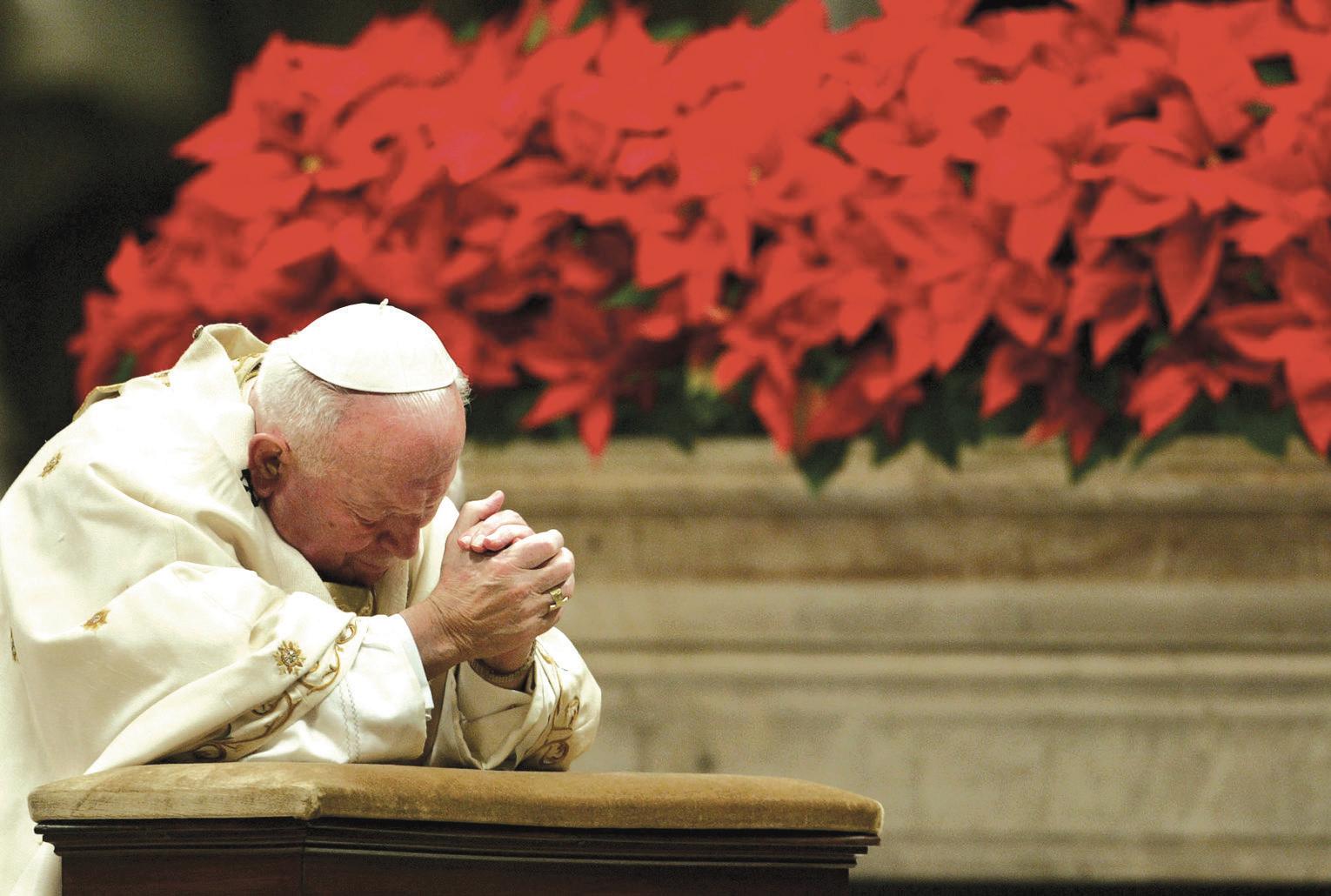
Faith, hope, love drove pontificate
In the Pope’s 1996 book, “Gift and Mystery,” he remembered his joy at being called to the priesthood, but his sadness at being cut off from acquaintances and other interests. He said he always felt a debt to friends who suffered “on the great altar of history” during World War II, while he pursued his underground seminary studies.
As a seminarian, he continued to be attracted to monastic contemplation. Twice during these years he petitioned to join the Discalced Carmelites but was said to have been turned away with the advice: “You are destined for greater things.”
He was ordained four years later, as Poland’s new communist regime was enacting restrictions on the Catholic Church. After two years of study in Rome, he returned to Poland in 1948 and worked as a young pastor. From the beginning, he focused much of his attention on young people, especially university students - the beginning of a lifelong pastoral interest. Students would join him on hiking and camping trips which always included prayer, outdoor Masses and discussions about the faith.
Fr Wojtyla earned a doctorate in moral theology and began teaching at Lublin University, at the same
time publishing articles and books on ethics and other subjects. In 1958, at age 38, he was named an Auxiliary Bishop of Poland, becoming the youngest Bishop in Poland’s history. He became Archbishop of Krakow in 1964 and played a key role in the Second Vatican Council, helping to draft texts on religious liberty and the Church in the modern world.
After Pope John Paul I was elected in the first conclave of 1978, Cardinal Karol Wojtyla said in a sermon in Poland that the papacy, “although it is a great office, is also a very great cross.” He said of the new Pope: “He took up the cross of contemporary man ... of all the tensions and dangers which arise from various injustices: the violation of human rights, the enslavement of nations, new forms of colonial exploitation ... wrongs which can be righted only in the spirit of Christ’s cross.”
A few weeks later, Pope John Paul I was dead, and the “cross” of the papacy fell to Cardinal Karol Wojtyla.
Early in his pontificate, on 13 May 1981 - the feast of Our Lady of Fatima - the Polish Pope experienced a brush with death that intensified his already strong devotion to Mary. Mehmet Ali Agca, a Turk
who had previously threatened the Pope, shot and seriously wounded the Pontiff in St Peter’s Square. The Pope’s life hung in the balance, and his recovery was slow. He credited Mary with saving him and later travelled to the Shrine of Our Lady of Fatima in Portugal where he placed a bullet fragment removed from his body in the crown of a statue of Mary.
Years later, the Pope published the “third secret” of Fatima, which described a period of suffering for the Church and the shooting of a Bishop in white - a figure the Pope believed was linked to the attempt on his life.
Pope John Paul’s private prayer life was intense, and visitors who attended his morning Mass described him as immersed in an almost mystical form of meditation. He prayed the liturgy of the hours, he withdrew for hours of silent contemplation and eucharistic adoration, and he said the Rosary often - eventually adding five new luminous mysteries to this traditional form of prayer.
The Pope also took penitential practices seriously. In a book published after his death, the postulator of his sainthood cause, Mgr Slawomir Oder, said Pope John Paul spent entire nights lying
with his arms outstretched on the bare floor, fasted before ordaining priests or Bishops and flagellated himself with a belt.
Throughout his life, Pope John Paul was a devotee of the Divine Mercy movement, which was founded in the early 1900s by a Polish nun from Krakow, Sister Faustina Kowalska. Her special devotion to the divine mercy of God was a theme the Pope himself took up in his 1980 encyclical Dives in Misericordia (“Rich in Mercy”).
The Pope beatified Sr Faustina in 1993 and canonised her in 2000, proclaiming the second Sunday of Easter as Mercy Sunday throughout the world. Pope John Paul’s death in 2005 came on the eve of Mercy Sunday, and his beatification on 1 May will be celebrated on Mercy Sunday.
Pope John Paul canonised 482 people, more than all his predecessors combined. Although the Vatican was sometimes humorously referred to as a “saint factory” under Pope John Paul, the Pope was making a very serious effort to underline what he called the “universal call to holiness” - the idea that all Christians, in all walks of life, are called to sanctity.
“There can never be enough saints,” he once remarked.
He was convinced that God sometimes speaks to the world through simple and uneducated people. St Faustina was one, and he also canonised St Padre Pio, the Italian mystic, and St Juan Diego, the Mexican peasant who had visions of Our Lady of Guadalupe.
The world knows Pope John Paul largely because of his travels to 129 countries. For him, they were spiritual journeys. As he told his top advisers in 1980: “These are trips of faith and of prayer, and they always have at their heart the meditation and proclamation of the word of God, the celebration of the Eucharist and the invocation of Mary.”
Pope John Paul never forgot that he was, above all, a priest. In his later years, he said repeatedly that what kept him going was not the power of the papacy but the spiritual strength that flowed from his priestly vocation.
He told some 300,000 young people in 1997: “With the passing of time, the most important and beautiful thing for me is that I have been a priest for more than 50 years, because every day I can celebrate Holy Mass!”
In his final years, the suffering brought on by Parkinson’s disease, arthritis and other afflictions became part of the Pope’s spiritual pilgrimage, demonstrating in an unusually public way his willingness to embrace the cross.
With his beatification, the Church is proposing not a model Pope but a model Christian, one who witnessed inner holiness in the real world, and who, through words and example, challenged people to believe, to hope and to love.
Pontiff’s impact will ‘continue for centuries’
BY JOHN T HAVIS Catholic News Service
VATICAN CITY - Pope John Paul II deeply influenced generations of Catholics who knew him in life, but his most enduring legacy - his teaching - is something that will continue to impact the Church for centuries, a US biographer of the late Pope said.
“It’s going to be several hundred years before the Church really takes on board the breadth and depth of this man’s explication of the Gospel, and in that sense we’re going to be thinking, and arguing, about John Paul II for hundreds of years,” said George Weigel, author of the papal biographies Witness to Hope
and The End and the Beginning Weigel said that six years after the Pope’s death his connection with young people continues to bear fruit in many ways: in priesthood vocations over the last decade, in women’s Religious Orders inspired by Pope John Paul and in renewal movements.
“I look at my own parish in suburban Washington and see young couples raising Catholic families, who all took some form of inspiration from John Paul II. And I suspect this is replicated all over the world,” he said in an interview on 27 April.
Weigel, who spoke four days before the beatification of Pope John Paul, said he had devoted some 15 years of his life to
researching his two major biographies of the Polish Pontiff. What impressed him, he said, was that the Pope was an “utterly normal human being” who made himself completely open to the work of the Holy Spirit.
In that sense, Weigel said, the holiness that’s being recognised at his beatification is something accessible to all Christians.
Throughout his life, he said, Pope John Paul was trying to figure out what God was doing in his life and in the world, and to respond accordingly.
“I think everything he did, as a literary man, as a philosopher, as a priest, a Bishop, a statesman, a Pope, grew out of his radical Christian discipleship,” he said.
“Very few of the billion Catholics in the world are going to have the range of talents that Karol Wojtyla had. Every baptised person has the opportunity to live a life of radical discipleship. And that’s our connection to him,” he said.
Weigel noted that being a saint is not about perfection.
“It’s about living one’s life with the intention to do the right thing and making decisions based on one’s best judgement, without fear or favour,” he said.
“No Pope gets everything right. John Paul II didn’t get everything right, he would be the first to admit it.”
Some have questioned Pope John Paul’s beatification, saying
he responded inadequately to priestly sex abuse cases that came to light late in his pontificate. Weigel said that criticism is off the mark.
“The way to think about John Paul II and the priesthood is to recognise that he was a great reformer of the priesthood,” Weigel said.
“The priesthood was in terrible shape in 1978 when he became Pope; it was in remarkably better shape 26 years later. That’s the context.
“The Pope, frankly like the rest of the Vatican, took too long in 2002 to find out what was really going on in the United States. But once he found out, he acted in a decisive way.”
Pope John Paul II prays during midnight Mass at St Peter’s Basilica at the Vatican early on 25 December. During his annual urbi et orbi address later in the day, the pontiff evoked the traditional Christmas message of peace on earth. PHOTO: CNS/ REUTERS
BLESSED POPE JOHN PAUL II SOUVENIR EDITION
Cardinals called for JPII sainthood inside Conclave
BY GIACOMO GALEAZZI
La Stampa/Worldcrunch
VATICAN CITY - “The beatification was asked for inside the conclave.”
The scoop arrived from an Italian news agency just four days before the solemn ceremony in which Benedict XVI became the first Pope in 11 centuries to proclaim “blessed” his immediate predecessor.
Cardinal Camillo Ruini, who was then the powerful head of the Italian Bishops Conference, revealed to the AGI news wire how members of the College of Cardinals had pushed for the acceleration of the beatification process for John Paul II even before his successor had been chosen.
Ruini recounted how a large group of Cardinals had signed a petition calling on the next Pope, still not yet elected, to waive the standing five-year minimum wait for the process of beatification to begin in the case of John Paul.
“Entering the conclave, a letter was given to me

signed by many Cardinals who joined in the popular request (heard after John Paul’s death) to begin the process for sainthood right away,” said Ruini, who also served at the time as Vicar of Rome. “The letter was given to me because the Cardinals didn’t know who would be elected in the conclave.”
Ruini recalled his own feelings in seeing how many people were lining up near


St Peter’s Square to give a last goodbye to John Paul, and the chanting for Santo Subito! (“Saint Right Away!”) “I understood how deep and widespread the feeling of the people. was For them, the Pope was already a saint.”
Ruini cites John Paul’s battle “against Communism to defend man,” along with his work on behalf of the poor, interreligious harmony and world peace.
Libyan Bishop calls on JPII miracle for peace
VATICAN CITY (CNS) - The top Church official in Libya said he was praying to Blessed John Paul II for peace and an end to civilian casualties in the North African country.
Bishop Giovanni Martinelli of Tripoli also questioned the morality of the NATO airstrikes against the residence of Libyan leader Moammar Gadhafi. The attack on 30 April reportedly killed one of Gadhafi’s sons and three of his grandchildren, but the Libyan leader was said to be unharmed.
“The bombs, as precise as the aim can be, lead to civilian victims. Bombs are immoral. I wonder also whether it is moral to kill a head of state. What right do we have to do so?” Bishop Martinelli told the Vatican missionary news agency Fides on 30 April.
He said several people had reported to him earlier that day several other bombings had caused civilian casualties.
“They hit Sirte, Zentani and Misurata. In this last place the fighting continues. I do not know who hit the civilians, but I know that the situation in Misurata is dramatic,” Bishop Martinelli said, adding that he hoped to be able to visit wounded civilians in the hospital.
“Even the statement on behalf of the coalition countries that bomb Libya, who want to protect civilians from being attacked, does not correspond to the truth, because these bombings cause victims among civilians who they claim to want to protect. It is necessary first of all to reach a cease-fire,” he said.
“We ask the intercession of John Paul II that can work miracles. I remember that it was this pope who opened diplomatic



relations with Libya in 1997, when this country was under international embargo,” the Bishop said.
“I am praying ceaselessly so that, through his intercession, a peaceful solution may be found to the crisis,” he said. He said one of Blessed John Paul’s teachings was that “war cannot bring peace.”


As we all know, kids will be kids and accidents happen. Our personal accident insurance covers children 24/7, wherever they may be – at home, school, even on the sports field. There is no excess and it can provide a buffer between medical expenses and health insurance rebates. For the full list of benefits, see the product disclosure statement available from us. * $32 per kid, per year inclusive of GST and statutory charges. Prices based on a policy with one insured person. This Insurance is underwritten by Allianz Australia Insurance Limited (Allianz) ABN 15 000 122 850 AFS Licence No. 234708 and is arranged by Catholic Church Insurances Limited ABN 76 000 005 210 AFSL 235415, 485 La Trobe Street, Melbourne VIC 3000, as a promoter for Allianz. A Product Disclosure Statement (PDS) for insurance products can be requested by calling 1300 655 003; or online from www.catholicinsurances.com.au. this insurance, Catholic Church Insurances will receive commission on these insurance products as a percentage of the premium paid for each policy. Ask us for more details before we provide you with any services on these products. Call 1300 655 003 or visit us at catholicinsurances.com.au * CCI0041
BLESSED POPE JOHN PAUL II SOUVENIR EDITION
Pope John Paul II appears from the central balcony of St Peter’s Basilica after his election on 16 October 1978. The Pope, who died on 2 April 2005, was beatified at the Vatican on 1 May. CNS
A rebel fighter guards the final checkpoint on the road from Bin Jawad toward Nawfiliyah, where forces loyal to Moammar Gadhafi have halted a rapid rebel advance in eastern Libya on 29 March. PHOTO: CNS/FINBARR O’REILLY, REUTERS
JPII relic vial of blood
VATICAN CITY (CNS) - A small vial of Pope John Paul II’s blood was the relic for the Mass for his beatification. The relic was presented to Pope Benedict XVI and exposed for veneration during the Mass in St Peter’s Square on 1 May.
After the Mass, it will be kept with other modern relics in the Apostolic Palace, the Vatican said.
The Vatican explained that four vials of blood were drawn from Pope John Paul during the final stage of his illness by his personal physician. The vials were sent to the Vatican-owned Bambino Gesu Hospital in Rome in case the ailing Pope needed a transfusion.
No transfusion was ever needed and, after the death of Pope John Paul on 2 April 2005, two of the vials went to the Pope’s personal secretary, Cardinal Stanislaw Dziwisz of Krakow, Poland, and the other two remained in the custody of the Daughters of Charity of St Vincent de Paul at the hospital, the Vatican said.
One of the vials of blood from the hospital was presented for veneration at the beatification Mass and placed in a “precious reliquary specially made” for the occasion, it said.
The second vial will remain at the hospital.
The Vatican said the blood in all four vials has not solidified because an anti-coagulant had been added at the time the blood was drawn.

Pope Benedict beatifies John Paul II
BY CINDY WOODEN Catholic News Service
VATICAN CITY - “John Paul II is blessed because of his faitha strong, generous and apostolic faith,” Pope Benedict XVI said on 1 May just minutes after formally beatifying his predecessor.
Italian police said that for the Mass more than one million people were gathered in and around the Vatican and in front of large video screens in several parts of the city.
Many in the crowd had personal stories about seeing Pope John Paul or even meeting him, and Pope Benedict ended his homily at the Mass sharing his own personal story.
“I would like to thank God for the gift of having worked for many years with Blessed Pope John Paul II,” he said.
As Prefect of the Congregation for the Doctrine of the Faith from 1982 until his election in 2005, Pope Benedict said he worked at the Pope’s side “and came to revere him.” “His example of prayer continually impressed and edified me: he remained deeply united to God even amid the many demands of his ministry,” the Pope said.
“Today his name is added to the host of those whom he proclaimed saints and blesseds during the almost 27 years of his pontificate,” the Pope said in his homily.
During his pontificate, Pope John Paul beatified 1,338 people and canonised 482 - more than all his predecessors combined. The beatification of Pope John Paul just six years and a month after his death in 2005 was the fastest beatification in some 500 years.
Pope Benedict said that even at the moment of his death people “perceived the fragrance of his sanctity and in any number of ways God’s people showed their veneration for him. For this reason, with all due respect for the Church’s canonical norms, I wanted his cause of beatification to move forward with reasonable haste.”
After the Mass, Pope Benedict went into St Peter’s Basilica and knelt in prayer for four minutes before Blessed John Paul’s casket, which was set in front of the main altar. After the Pope left, the concelebrating Cardinals filed up to the wooden casket, touching it lightly and kissing it.
Eventually, the Vatican opened the basilica to the general public

and planned to keep it open either until the faithful stopped coming to pay their respects or until preparations had to be made for the official Mass of thanksgiving for the beatification on 2 May.
Thousands of people spent a chilly, damp night camped out near the Vatican in an attempt to find a place in St Peter’s Square when the gates were scheduled to open at 5.30am for the 10am Mass. The crowds were so large that police began letting people in at 2am, according to news reports.
Alongside the altar in front of St Peter’s Basilica, priority seating was given to official delegations from more than 80 countries, the European Union and the Palestine Liberation Organisation. The United States was represented by Miguel Diaz, the ambassador to the Vatican, and by his predecessors, Francis Rooney and Jim
Nicholson. King Albert and Queen Paola of Belgium led the list of royalty present and 16 heads of state attended, including Polish President Bronislaw Komorowski and Robert Mugabe of Zimbabwe.
Valeria Buonpastore, who is from Charlotte, North Carolina, said Pope John Paul “transcended nationalities. He was universal, that’s what made him so great. He was loved by people of other nations, religions. A lot of my Protestant friends loved him, too,” she said.
Also in the Square was Sr Marie Clarice, a 30 year old member of the Little Servants of the Sacred Heart from Madagascar, who remembers when Pope John Paul came to Madagascar in 1989; she was only 7 or 8, and the image that has remained is of a person who cared about the weak and powerless. “I remember the way he

welcomed the poor. He embraced them, like this,” she said opening her arms in a wide hug.
Speaking briefly in Polish in his homily, Pope Benedict said of his predecessor: “By his witness of faith, love and apostolic courage, accompanied by great human charisma, this exemplary son of Poland helped believers throughout the world not to be afraid to be called Christian, to belong to the Church, to speak of the Gospel.
“In a word: he helped us not to fear the truth, because truth is the guarantee of liberty,” the Pope said.
Pope Benedict read the formula of beatification at the beginning of the liturgy after Cardinal Agostino Vallini, papal vicar for Rome, petitioned the Pope by saying, “I humbly ask Your Holiness to inscribe the venerable servant of God John Paul II, Pope, among the number of blesseds.” The Pope responded by saying that after consulting many Bishops and members of the faithful and after having the Congregation for Saints’ Causes study the matter, “the venerable servant of God, John Paul II, Pope, henceforth will be called blessed” and his feast will be 22 October, the anniversary of the inauguration of his pontificate in 1978.
The crowds burst into sustained applause, many people cried and brass players intoned a fanfare as soon as the Pope finished reading the proclamation.
Polish Sr Tobiana Sobodka, who ran Pope John Paul’s household, and French Sr Marie Simon-Pierre, whose cure from Parkinson’s dis-
ease was accepted as the miracle that paved the way for his beatification, carried a relic (see story above) to Pope Benedict and then to a stand near the altar.
Reading a brief biography of the late Pope, Cardinal Vallini said he “had lived through the tragic experience of two dictatorships” - Nazism and Communism - “survived an assassination attempt on 13 May 1981 and, in his later years, suffered grave physical hardship due to the progression of his illness. However, his overwhelming optimism, based on his trust in divine providence, drove him to constantly look to the horizons of hope.”
In his homily, Pope Benedict also spoke of Pope John Paul’s suffering and his battle with Parkinson’s disease which eventually crippled him.
“There was his witness in suffering: the Lord gradually stripped him of everything, yet he remained ever a ‘rock,’ as Christ desired. His profound humility, grounded in close union with Christ, enabled him to continue to lead the Church and to give the world a message which became all the more eloquent as his physical strength declined,” the Pope said.
Pope Benedict also reminded the crowd of how devoted Pope John Paul was to Mary and to following her example of complete faith. “Blessed are you, beloved Pope John Paul II, because you believed,” the Pope prayed at the end of his homily. “Continue, we implore you, to sustain from heav-
Pope Benedict XVI kisses a relic of Pope John Paul II as he celebrates the beatification Mass of his predecessor in St Peter’s Square at the Vatican on 1 May.
PHOTO: CNS/ L’OSSERVATORE ROMANO
An image of Blessed John Paul II hangs from the church in Wadowice, Poland, as people take part in an outdoor Mass marking the late Polish Pontiff’s beatification on 1 May.
BLESSED POPE JOHN PAUL II SOUVENIR EDITION
PHOTO: CNS/MICHAL LEPECKI, AGENCJA GAZETA VIA REUTERS

Ex-Madam seeks rehab villages for working girls
While Attorney General Christian Porter steadfastly campaigns to legalise the selling of young women, an ex-Madam’s submission delivers a searing portrayal of prostitution’s actual reality. Legalisation solves nothing, she says.
By Anthony BArich
FORMER Perth madam Linda Watson has urged WA Attorney General Christian Porter to establish a village-like complex that provides holistic rehabilitation to prostitutes rather than to create ‘entertainment zones’ as part of his reform of the industry.
Ms Watson, who founded Linda’s House of Hope in 1999 together with Archbishop Barry Hickey as an exit and means of rehabilitation for women involved in prostitution, said the introduction of “tolerated zones” will impose “damaging effects on many communities” throughout WA.
Her submission to the Attorney General drew on decades of experience in the business of prostitution and instanced numerous examples of the damage it does to the women Please turn to Page 2

Brides-a-plenty as Royal Wedding sparks a little creative genius in Glendalough

The wedding gowns were loaned for the occasion, with some dating back to the 1960s and coming from around the world, including Bhutan. Full story, photos - Page 8 PHOTO: SPECIAL
Melbourne event sustains, puts family front and centre in Church’s plan for the new evangelisation in Australia

A
national
gathering organised by the nation’s Bishops dramatically re-emphasised the central importance of the family unit
By Bridget SpinkS who attended the Share the Dream, Third National Gathering of Families, in Melbourne from 15-17 April
Hundreds of couples and families attended the Share the Dream Third National Gathering of Families at Xavier College in the Melbourne suburb of Kew.
Archbishop of Melbourne, Denis Hart, hosted the con-
ference with the support of the Australian Catholic Bishops’ Conference, while Matthew MacDonald from the Melbourne Archdiocese Life, Marriage and Family Office was responsible for coordinating it.
The Gathering included several formational and educational talks aimed at married couples on the indispensable role of marriage and family life, the ‘mission’ of the family and the sacramental nature of marriage.
More than 800 people participated in the gathering including several families - at least two had ten children - as well as many singles, engaged and married couples, grandparents and great-grandparents.
The longest married couple in the room had been married for 55 years; the most newly wed had tied the knot just 18 months earlier and one couple had flown in from Colorado.
Please turn to Pages 6-7

It’s not a dumb question. Visiting Jesuit to address the tough issues of personal tragedy and human suffering
Wednesday,4 May 2011 the P arish the N
N the W orld therecord com au the
ecoRd WESTERN AUSTRALIA’S AWARD-WINNING CATHOLIC NEWSPAPER SINCE 1874 $2.00
atio
R
Ladies in waiting: women make the final touches as they prepare to participate in a special bridal fashion show for a reception at the Little Sisters of the Poor Home for the Aged in Glendalough in honour of the happy event, the wedding of Prince William and Catherine Middleton on 29 April.
BRIDAL CORRESPONDENT BRIDGET SPINKS
Family encouraged in parenting job: Brisbane residents, Luiza and Italo Oñaderra, pictured here with their children (L-R), Gabriel, 5, Gianna, 3, Thomas, 8, and Maria, 1. PHOTO: FAMILY GATHERING CORRESPONDENT BRIDGET SPINKS
Linda Watson, left, founder of Linda’s House of Hope, an organisation funded by the Catholic Archdiocese of Perth, helps women rebuild their lives after leaving prostitution. Watson, pictured with former prostitute Linda Harrison, spent decades as a prostitute and brothel madam in Perth. PHOTO: CNS MARYANGELA LAYMAN
SEE PAGE 2 A fire... a flood... a tsunami... Where is God in any of this?
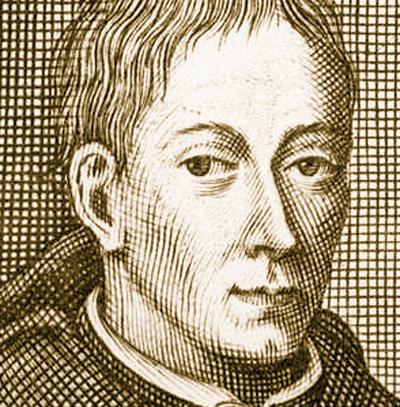
Continued from Page 1 and girls trapped in it. Mr Porter proposed reforms last November banning all forms of prostitution from residential areas with expanded police powers enabling them to shut down illegal brothels and has been enamoured of legalisation as a means of control. Owners, managers and prostitutes working in brothels would need to apply for licences.

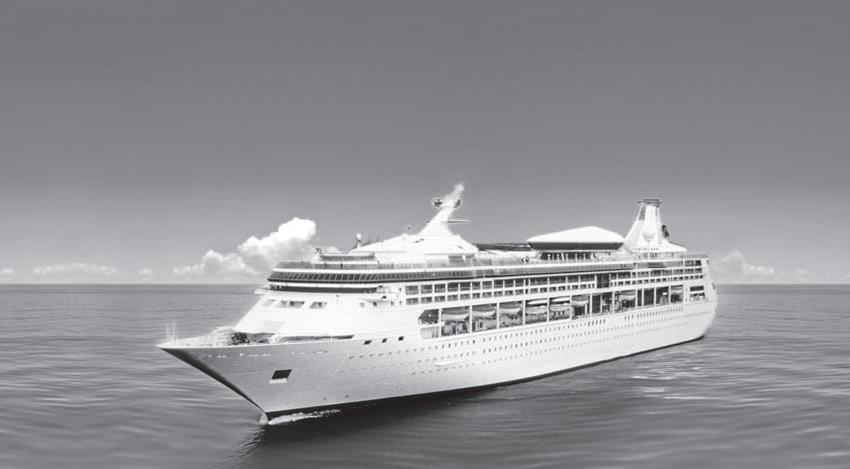

In a 12 April letter to Mr Porter, Ms Watson said she has seen damaged girls regularly “and nearly all of them desperately want to leave”, many asking for food and shelter. She has received threats from industry figures, as has the Archbishop, from well-known madams, she said.
When The Record asked Mr Porter at a community crime forum in Belmont last June whether his plans included support for prostitutes to exit the industry, he said “it’s certainly an area to which we have been giving consideration”.
Testifying to the industry’s toxic effect, Ms Watson said she has seen women with what she believes to be post-traumatic symptoms, mental health issues and eating disorders, drug-induced psychoses and alcohol abuse problems, anger issues that are sometimes violent and have violent partners or dysfunctional relationships.
Many girls have ended up in prison, she added.
While admitting there is “no easy fix”, she said it is “imperative to have a properly supervised exit programme”, which will take “serious money because people who leave the sex industry are deeply damaged and only have the clothes on their backs”.
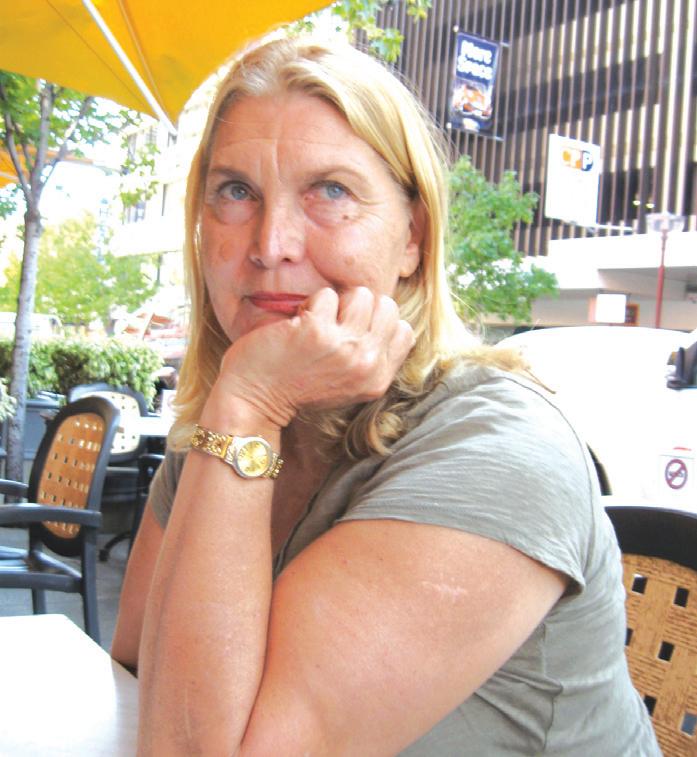
food and supplements, with in houseprogrammes teaching life skills, art, music, home making and cooking class.
“The girls love to attend these as most have few domestic or social skills and little understanding of personal hygiene,” she said.
“Some have simply forgotten or have never been taught fundamental life skills.”
Pastoral care is also paramount for their recovery as “all have been dispirited and lost hope”.
Many have come from some form of religious background and “it is helpful to reconnect them with their childhood spiritual foundation” as part of the holistic recovery, she said.
“Young children, boys and girls, are known to loiter around brothels to entice clients for sex”, while some engage in sexual acts in return for drugs, while Indigenous children have sex for glue near well-known brothels in Kalgoorlie and in Perth precincts.
“This has been known in the industry for years. Things have not changed,” she said.
Prostitute recruits are lured with the promise of large sums of money but end up having their identity stolen and are warned of the dangers of violent customers, she said.
She said there is an “Ugly Mugs Programme” that warns girls of characters to look out for who target prostitutes, while madams also fine girls for refusing drink, abusive and sometimes elderly men.
“I have seen first-hand how some girls actually come out vomiting after one of these encounters,” Ms Watson said.
House of Hope stretched to limit helping girls who want out
LINDA’S House of Hope founder
Editor
Journalists



Peter Rosengren office@therecord.com.au
Bridget Spinks baspinks@therecord.com.au
Mark Reidy mreidy@therecord.com.au
Anthony Barich abarich@therecord.com.au
Advertising/Production
Mat De Sousa production@therecord.com.au
Accounts
June Cowley accounts@therecord.com.au
Catherine
Ms Watson said that she supports the Salvation Army’s Harry Hunter Rehabilitation Centre as a model – a series of four-bedroom independent units for female clients for female drug and alcohol addicts who go “cold turkey” – complete abstinence from these things.
“Most girls I’ve seen who have successfully exited the industry have made it because of the cold turkey approach,” she said.
Ms Watson said a village or similar small housing complex is needed, staffed around the clock with medium to longterm accommodation for up to three years where services like doctors, counsellors and training programmes are provided onsite.
A detox programme is vital to such a venture as “the majority of exiting sex workers have substance abuse issues”, she said.
The project should include a holistic approach incorporating nutritious
Reuniting them with their family and integrating them back into society through gainful employment, as many who have attended her House of Hope have done, will give them hope for the future, Ms Watson added.
She described establishing restricted “entertainment zones” as “a risky experiment with the lives of women and children in our State” because there are many toxic elements inherent to the industry that such zones “cannot fix”.
She said drug dealers often pose as clients to introduce prostitute recruits to drugs, as drugged girls “can earn more money for madams”, and that drug dealers use brothels as targets for marketing their drugs for organised crime.
“Perverts roam the streets where private operators or brothels are located. Paedophiles seek children from prostituted mothers,” she said, and described some cases where paedophile clients like sex workers to dress up as children, wear nappies and have dummies in their mouth.
Linda Watson says its resources have been stretched to the limit this school holidays in helping women and children struggle free from prostitution.
The organisation is currently assisting between 80 and 100 people a week with food, clothing and emergency financial assistance.
“School holidays are a very busy time. As anyone with children would know, they eat you out of house and home,” Ms Watson told The Record
Leaving the world of prostitution means leaving a steady income stream behind.
“Most are only on a pension and there’s a lot of pressure. We want to keep doing our outreach. We’re trying hard to keep our doors open,” Ms Watson said.
For more information about Linda’s House of Hope call 0439 401 009 or 9358 1719. Tax deductible donations can be made to: Linda’s House of Hope, PO Box 5640, PERTH, St George’s Tce 6831.
God, suffering and meaning - public lecture
An estimated 1,100 people in Sydney turned out to hear a Jesuit who will speak in Perth on 19 May
THE Catholic Mission agency of the Archdiocese of Perth is inviting all to what promises to be a fascinating and thought provoking public lecture on 19 May.
Audience members will be free to ask questions of visiting speaker Fr Richard Leonard SJ, and it’s likely many will have a few on their minds after several months of natural disasters such as the Japanese tsunami and accompanying human tragedies occupying the full glare of media attention on a global scale.
suffering. Fr Leonard’s book, which will be available on the night, has won numerous positive reviews for its approach and argument.
In addition to his responsibilities as director of the Australian Catholic Film Office and Catholic Church Television Australia, Fr Leonard is a consultant to the Australian Catholic Bishops’ Media Committee and a film critic for all the major Catholic newspapers on the eastern seaboard.
Fr Leonard also lectures in cinema and theology at the United Faculty of Theology and the University of Melbourne.
Fr Leonard’s public lecture will be held at St Thomas More Church in Bateman on Thursday evening, 19 May from 7.30pm to 9pm.




The subject is so topical, around 1,100 people turned out to hear Fr Leonard SJ in a Sydney parish when he gave a talk on human tragedies and God last month.
His talk accompanies the publication of his latest book, Where the hell is God, which explores the difficult question that has always confronted religious belief of a God that is intimately concerned with the welfare of human beings and the reality of
Catholic Mission Director Francis Leong said, “As Catholics, we are called to be missionary, to be messengers of the Resurrection.
“This public lecture offers us an opportunity to invite those outside our parish and Church community to accompany you to listen to some words that may reinforce the solace and hope that this Easter season brings. With the help of the Holy Spirit,
who knows where this may lead.” While in Perth, Fr Leonard will also be giving a similar presentation for the professional development of Archdiocesan staff. For more information and to register interest in the public lecture, please RSVP the Catholic Mission office on 9422 7933 or via email at cm@perthcatholic.org.au.
200 St. George’s Terrace, Perth WA 6000 Tel: 9322 2914 Fax: 9322 2915 Michael Deering 9322 2914 A division of Interworld Travel Pty Ltd ABN 21 061 625 027 Lic. No 9TA 796 michael@flightworld.com.au www.flightworld.com.au Take to the waves in Style • CRUISING • FLIGHTS • TOURS • with a cruise from our extensive selection. SAINT OF THE WEEK Blessed Thomas Pickering c. 1620-1679 May 9 This English Benedictine lay brother was a martyr of the Popish Plot. He professed vows in France in 1660 and was sent to London in 1665 as procurator of a small community celebrating liturgies in the chapel of Queen Catherine of Braganza. Though other monks were banished, he was allowed to stay. Because of the fictitious plot, in which Titus Oates alleged that King Charles II would be assassinated and the French king would re-establish Catholicism in England, three Jesuits, Pickering and a layman were found guilty of conspiracy. Saints Crosiers
Classifieds/Panoramas/Subscriptions
Gallo Martinez
Record Bookshop Bibiana Kwaramba bookshop@therecord.com.au Proofreaders Chris Jaques Eugen Mattes Contributors Debbie Warrier John Heard Karen and Derek Boylen Anthony Paganoni CS Christopher West Catherine Parish Bronia Karniewicz Fr John Flader Guy Crouchback The Record PO Box 3075 Adelaide Terrace PERTH WA 6832 21 Victoria Square, Perth 6000 Tel: (08) 9220 5900 Fax: (08) 9325 4580 Website: www.therecord.com.au The Record is a weekly publication distributed throughout the parishes of the dioceses of Western Australia and by subscription. The Record is printed by Rural Press Printing Mandurah and distributed via Australia Post and CTI Couriers. The Parish. The Nation. The World. Find it in The Record. THE R ECORD Contacts THE R ECORD Contacts Rehabilitate prostitutes, not box them in: ex-madam
office@therecord.com.au
Linda Watson
4 May 2011, The Record Page 2
Australian Jesuit Fr Richard Leonard SJ, whose talk in Perth on 19 May on human suffering and where God is to be found in the face of tragedy promises to be thoughtprovoking.
THE PARISH















































































ANight when everyone is aStar




































4 May 2011, The Record Page 3 THE PARISH
TLW: defying the ideals of the world


 BY BRIDGET SPINKS
BY BRIDGET SPINKS
THE Duke and Duchess of Cambridge and Julia Gillard are “powerful witnesses” of the weight the world places on chastity, marriage and commitment, Perth Archbishop Barry Hickey said at the Perth True Love Waits movement’s 10-year anniversary gathering on 30 April at Sacred Heart Chapel, Highgate.
The ideals of TLW are very different from the ideals of the world, he said.
“They call on celibacy and preserving one’s integrity before marriage and having very high ideals about life and that marriage is all about commitment. They’re ideals we wish the whole world would share but we know they don’t. We have some powerful witnesses.
“The royal couple themselves have made a commitment we hope is sincere and lifelong, but we know that they were living together for many, many years. Not the best
witness. Our own Prime Minister does not give the best witness in this particular area either. But they’re prominent figures. Your neighbours might not give the best witness,” he said.
More than 30 members and supporters of the movement had gathered for the anniversary Mass, afternoon tea and presentations.
Current True Love Waits leader Thomas Seeber, and its former leaders who helped in the anniversary’s preparation, hoped that the event would spark a renewal in interest in the movement.
Among those present on 30 April were many of the old guard; initiators of the Perth branch of the movement in 2001 including brothers Stephen and Grant Gorddard who have both since entered St Charles’ Seminary and Teresa Tournay who has since married and gave birth to the couple’s second son Patrick on 2 May.
Teresa, who made the pledge in 2001, said she was involved with
the core team members for a few years, which organised monthly open sessions on topics to do with True Love Waits.
She said she had always wanted to wait until marriage anyway but making the pledge, after seeing a presentation on TLW at Antioch (parish youth group), made dating easier. “It made it easier not to have sex because I had made the pledge; it was a public decision to wait,” Teresa said.
She remembered a brochure –100 Things To Do Instead of Itwhich was useful in one previous relationship.
“It was fun, there were things like going for a walk or baking a cake,” she said.
There were also newer faces in attendance, supporting the movement on the cusp of a reboot.
Anthony Coyte, who made a significant contribution to the movement prior to Stephen Gorddard taking over, was unable to attend as he now works for the John Paul
Homeless bail up Barnett to get urgent answers
BY MARK REIDY
WA PREMIER Colin Barnett promised a group of angry homeless people that they would not be treated any differently to other WA citizens during the upcoming Commonwealth Heads of Government Meeting in October this year.
The small but vocal group gathered on the steps of Parliament House on 14 April to deliver a petition protesting the decision, announced several weeks ago by Police Minister Rob Johnson that homeless people be removed from most of Perth’s CBD during the three-day gathering, beginning 28 October.
Corey Wilkinson, 30, who has experienced lengthy stints of homelessness since the age of 16, said that he and several other people currently living on the streets had been outraged by the prospect of being “hidden away from world leaders” just to give the impression that there was not a homelessness problem in Perth.
“We have collected over 400 signatures in the last 24 hours, including many from those who are currently living on the streets, and have handed them to Opposition Leader Eric Ripper who will be presenting

them to Members of Parliament”.
Mr Barnett, who met the protesters on the steps before Question Time, promised that those who were homeless would not be “rounded up.” He also said security measures meant that certain areas would have to be sealed off and if anyone was removed, the government would seek the help of various city welfare agencies to provide assistance.
When Mr Wilkinson presented the petition to the Opposition Leader, minutes before the parliament’s afternoon session began, Mr Ripper said he was greatly concerned with the crisis of homeless-
ness. Mr Ripper said there were more than 55,000 people currently on the public housing waiting list and with the expected influx of workers in the next few years, he believed the situation would deteriorate further.
Ken, 46, who has lived intermittently on the streets for the past three years, said he was disgusted by the attitude shown by the Government.
“It is sad to be not only unwanted, but to be unacknowledged; to have our own representatives pretend that we don’t even exist leaves me with a feeling of emptiness and disgust”.
II Institute of Marriage and Family in Melbourne.
The Archbishop also preached on the laity’s role in participating in the mission of the church as articulated at the Second Vatican Council. He took the occasion to clarify the exact message of the Council.
He emphasised that the role of the laity in being part of the Church’s mission did not involve – contrary to what many people thought - “crowning the sanctuary, taking up many roles in the Liturgy” and “running the church”.
“Yes, that is part of the role of the people of God to participate in the Church’s Liturgy and in her organisation but that is not what the Second Vatican Council was talking about,” he said. “It was saying, ‘You, baptised people of Christ, the priests and the religious probably won’t be able to go out into the world and share the light of Christ the way you can. So, the primary role of the lay people is to take their
light out into the world and convert the world;’ not walk proud on the sanctuary - it didn’t use those words, but I said them,” he said.
The role of the priest is to minister to the Church – sacramentally and in the Word of God – and to live their Christian vocation, the Archbishop said.
The role of the layperson is to be a light of “right understanding” and “illumination” in the world, he said.
The ideals of True Love Waits, are “part of that light that the world needs to hear more and more because the darkness of the world is trying to extinguish that light,” he said.
He congratulated the TLW movement on their 10-year anniversary and urged those gathered, “not to let the poor witness out there be the one that the next generation takes on”.
“Let it be yours; the witness of a happy and holy, integral and chaste life and uphold the values of marriage,” he said.
Final call for WYD Madrid
Last chance for World Youth Day registrations
BY ANTHONY BARICH REGISTRATIONS for World
Youth Day (WYD) Madrid
2011 has been extended to 15 May to cope with the largest number of Australian pilgrims ever to attend the event outside Australia.
Several thousand Australian pilgrims, hundreds of priests and 23 Australian Bishops will join over two million young people from around the world to celebrate the 16-21 August event in the Spanish capital.
Philip Ryall, managing director of Harvest Pilgrimages, the official tour operator for the global youth event appointed by the Australian Catholic Bishops Conference, attributed the enthusiasm to still-fresh memories of WYD 2008 in Sydney.
“The memories of [WYD Sydney] are well and truly alive in the hearts of young people. For many, the journey must continue on to Madrid … as the week builds up to an epic Vigil sleep out and final Mass
with Pope Benedict XVI,” Mr Ryall said. “We have approached our key airline partners who are willing to allow latecomers another three week window to come on board to avoid missing out altogether. It really is a case of ‘final call’ for Madrid.”
While many tours have reached capacity, group organisers have been keen to make way for more young people to join in.
Canberra-Goulburn Archbishop Mark Coleridge will accompany young people from his diocese on the “Shores of Galilee Pilgrimage” in the Holy Land during the World Youth Day trip.
“For me, WYD is a real blessing, a chance to see the future of our Church in action,” the Archbishop said.
“We are going right to the source and we will be walking in the footsteps of Jesus.
“We already have lots of young people registered, and I really encourage young people of the diocese to consider joining us; you are all so welcome.”
Harvest Pilgrimages staff are currently finalising the travel arrangements of young people from parishes, schools, communities and movements across Australia.
Left, Teresa Tournay with husband Nathan and son Lochlan; Middle, Perth youth Hanna Lyra, Caroline Nevin, Adrian Brannigan and Vincent Restifo enjoy the fraternity after the Mass marking True Love Waits’ 10th anniversary; Right, TLW founder Grant Gorddard addresses the gathering at the Catholic Pastoral Centre at Highgate
PHOTOS: BRIDGET SPINKS.
WA Premier Colin Barnett answers questions from Corey Wilkinson.
THE PARISH 4 May 2011, The Record Page 4
God, friends and song help Stacee
Chorister at Holy Name Parish in Carlisle and St Mary’s Cathedral, Stacee Parkinson, 27, was thrown into the spotlight of the secular press after an alleged drug lab exploded in her next door neighbour’s unit on 20 March. Days after the event, Stacee opened up in an exclusive interview to The Record ’s Bridget Spinks to tell her side of the story.
STACEE Parkinson was singing for the 5pm Sunday Mass at St Mary’s Cathedral - unaware of the fuss happening at home - when police allege a drug lab exploded in the Homeswest unit next door to hers in Carlisle.
Her first thought was to find out if her own unit was ok when she found four missed calls and an SMS on her phone after Mass.
Her brother took her home that night to investigate for herself.
The unit next door was “blackened,” she said, “the roof, the walls, absolutely everything is black”.
But her own unit, which had been blessed as soon as she moved in four years ago, was unscathed.
Over the last three and a half years, Stacee, who suffers from mild cerebral palsy and blindness in her left eye, has complained on at least 20 occasions to the Department of Housing about the tenant next door.
“I just got told they were investigating it … They couldn’t tell me what was going on but they were investigating it, which I found quite hard to believe at the time,” she said.
Her complaints seemed to fall on deaf ears as the weeks turned into months. After three years with the same tenant still living next door, Stacee was losing sleep.
“I didn’t go ahead and contact Department of Housing in the first three to six months; I let him off the hook to give him a chance,” she said.
But when the loud music“everything from really hard, heavy metal to the boom boom bassy stuff” - kept her awake and started to become a regular occurrence,
she decided to take action. It was “absolutely pulsating” through her adjoining wall, she said.
There were times, Stacee said, when he would “be good and turn it down” and times when he would just turn it back up again.
“But it’s not only him, it’s his associates as well. And his associates would actually be physically abusive and would abuse me for coming over and asking them.”
The weekend of the explosion, Stacee was about to start a campaign to have the tenant evicted.
She had gathered four signatures from surrounding neighbours for a petition to have the tenant evicted.
She was planning on getting more signatures from relatives and friends to support her before the incident occurred.
“’You might not have to work, but I do,’” she said. Stacee said she suspected something was going to happen because on the Monday before the blast, they had an “all night bender”. But on the day of the incident, Stacee was out and there were no signs of imminent danger.
“I couldn’t actually smell anything before it went up. I suspected, but I couldn’t smell anything,” she said.
Five people were injured in the incident including the son of WA Police Commissioner, Karl O’Callaghan.
Stacee, the daughter of a retired police superintendent, came home that night and fell headlong into a media frenzy. The next day, she was answering questions from journalists in front of clicking cameras and hardly had any time to think.
Stacee said she is overwhelmed

by the support that she has received since the incident threw her into the spotlight. She was given a hairdresser voucher for a trim and blow dry, juices, been shouted lunch and even given concert tickets at St Mary’s Cathedral from friends and neighbours.
“Everyone’s just been so loving and supportive; it’s been overwhelming,” she said.
Frustration, anger, sadness, some happiness, stress and forgetfulness are all emotions that Stacee has experienced since the blast.
She’s been doing a lot of thinking too. Her faith in God is even stronger now and growing every day.
“I live for God; I work for God. As soon as I set foot into that Cathedral, I’m working for God,” she said, referring to singing in the Cathedral choir.
But it doesn’t stop there; Stacee said she lives for God all through the week too. “I see people on the street reaching out, asking. I notice I’m trying to help people a lot more, just reaching out. That’s what I’m
Cathedral to honour Mary with feast of Marian music
Cathedral hosts feast of Marian music for May
THE Cathedral of the Immaculate Conception of the Blessed Virgin Mary will host a feast of Marian music to honour its patroness on 15 May at 2pm.
The Cathedral’s Principal Cantor Daniel Mullaney will team up with Director of Cathedral Music and Principal Organist Jacinta Jakovcevic to present a unique programme of Marian vocal and organ music to highlight Our Lady’s month of May.
Titled Marian Meditation, the concert traces the life of Our Lady in music in a special presentation featuring favourites such as Schubert’s Ave Maria and Caccini’s Ave Maria - and even something to cater for opera buffs with Mascagni’s Sancta Maria from his famous opera Cavalleria Rusticana’. Adding variety to this ‘aural collage’ are excerpts from Paul Hindemith’s Das Marienleben (The Life of Mary): a rarely performed

work offering short, meditative glimpses into Our Lady’s life.
Hindemith (1895-1963) was one of the most influential composers of the 20th century. Written in 1923, this work is known for its powerful imagery, poignant expression and beauty of melodic outline. It features poetry of Bohemian poet Rainer Maria Rilke (1875-1926).
Also on the programme are Marian-inspired organ works by Vierne, Daquin and Messiaen performed on the Cathedral’s historic
Dodd organ. Experiencing these works in the much-acclaimed acoustic of St Mary’s Cathedral is a real aural feast and coupled with the Cathedral’s awe-inspiring surrounds make for an unique experience in the City of Perth, Ms Jakovcevic said. “An outstanding young singer, 20 year old Daniel is already well-known to Cathedral congregations and concert audiences with a vocal maturity well beyond his years,” she said. Daniel has been a member of the Cathedral Choir since the age of 11 and plays a prominent role at the Cathedral as its Principal Cantor - a position he has held since the age of 17.
The afternoon includes a complimentary Miss Maud afternoon tea served in the Parish Centre and adjoining courtyard.
Miss Maud is also offering a $10 off lunch or dinner on the day of the concert at its Pier Street restaurant on presentation of concert tickets. Bookings are essential.
Tickets $45 ($35 concession) available from BOCS (9484 1133 www.bocsticketing.com.au). Proceeds go toward the Cathedral Fundraising appeal.
for. I try and put others before myself. We can all be selfish but I’m trying my best to put others before myself,” she said.
For the last few years, Stacee said she would often stay out of the house to avoid the situation and lost motivation to keep the place clean.
“I feel that I can’t have visitors because of the stuff going on,” she said.
To cope, she put her faith in God and soldiered on.“I turned to my Church friends; I turned to all the good I can do for everyone; I have a very supportive family and of course I turned to God,” she said. Stacee works three days a week for LandCorp as an administration assistant and fills in the rest of her time volunteering. She sings at two parishes and at Catholic Youth Ministry’s Wednesday night holy hour when she can. She also volunteers with other Christian groups. Her singing, she said, keeps her going. “I believe that what God takes away, he gives back tenfold. He gave back a heart for God, a heart for others and a musical abil-
ity. That’s what He gave back to me.
“He can take away sight in my left eye, He can take away my coordination but He gives back tenfold.”
Stacee said she can now go home without fear. She doesn’t have to sleep with the fan on any more to block out the noise.
She has also entered herself into the Carousel Face of Fashion competition being run through Westfield shopping centre. She said she’s “finally out there”.
“Nothing stops me, not even a little bump in the road like this. I try my best. I like to encourage others with disabilities to not just sit there, because if I can do it, they can do it,” Stacee said.
“My words to everyone else are ‘I’ve got my life back now’.”
CONGRATULATIONS
to Fr Tim Deeter who celebrates his 30th anniversary of priestly ordination on Sunday, 8 May 2011. We thank and appreciate you. Your parishioners
Albany students help fire victims
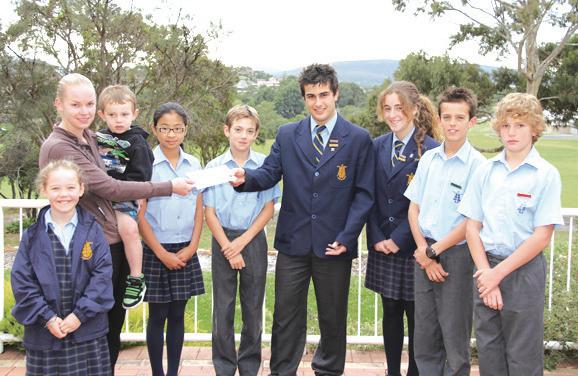
With a free dress day, sausage sizzle, fruit sticks, lolly jar guessing and slushies, the College
able to take part in the fundraising for this family and the College Leaders
able to present a cheque of over $1,200;
to the students for helping out the Gates-Pass family.
Carlisle resident Stacee Parkinson holds a burnt shirt found in the clean-up days after the alleged incident occurred next door.
PHOTO: BRIDGET SPINKS
SAINT Joseph’s College students, led by the Student Leaders, recently conducted a series of fundraising events for a College family.
Above, St Joseph’s College Head Boy, Daniel Bontempo, hands over a cheque to Leah Gates-Pass, whose family had their home and contents completely destroyed by a fire. The St Joseph’s College Student Leaders wanted to help the family, particularly the children, replacing toys and books.
community was
were
well done
Pictured left to right are Bree Gates-Pass, Leah Gates-Pass with Oliver, St Joseph College Student Leaders, Angela Dela Cruz, Myles Jackson, Head Boy Daniel Bontempo, Head Girl Emily Barnes, Jacob Oostdam and Isaac Lott.
Daniel Mullaney
4 May 2011, The Record Page 5
THE PARISH
The family: the beauty of human




The Share the Dream, Third National Gathering of Families called by the nation’s aspect of family life. Common to all was a strong philosophical belief in the
Bishop Jean Laffitte, a specialist in conjugal ethics and also Secretary of the Pontifical Council for Life, delivered the keynote address on the meaning and mystery of love
By Bridget SpinkS
The culture of marriage, the culture of love and the ‘culture of the family,’ a term used by Blessed Pope John Paul II, “go together,” the Secretary to the Pontifical Council for the Family Bishop Jean Laffitte said in the closing address at the Third National Family Gathering in Melbourne on 17 April.
The French-born prelate - who holds a Doctorate in Moral Theology and who served as the undersecretary of the Pontifical Council for the Family (PCF) and as the Vice-President of the Pontifical Academy for Life before being appointed Secretary of the PCF in 2009 - spoke on the philosophical and theological aspects of the nature of love, human and divine.
From personal experience, he mentioned as a point of “justice” his own experience of family and gave testimony to his own parents, because love for families is something he said he had received from them.
His parents had 12 children and, although now in heaven, he said, they have 36 grandchildren and 52 or 53 great-grandchildren.
Bishop Laffitte reflected on whether human love was genuinely a “good piece of news”.
The presence of so many families at the gathering was “proof” that human love was a “piece of good news”.
But the two requirements for this philosophical test concern the “discovery” at the natural level a person makes by means of his fundamental experience, ie that man discovers himself loved and a “revelation of a supernatural order”.
“Man discovers himself loved; it is the original experience of a child ... but it is also revealed through this unconditional love of his parents,” the Bishop said.
The divine revelation comes when the Pharisees

and the Disciples ask Jesus about the Law of Moses and obligation to the law in scripture, Mark 19: 3-13.
“In this sense, it is a very superficial question and demonstrates well that they have no idea at all that love might have a meaning; that there exists a beauty of love,” Bishop Laffitte said.
He said, Christ’s response reflects “a divine deliberation of the Creator that created the world and formed man as man and woman, an original plan of God”.
It is Christ who “unveils” God’s plan in Scripture, which, the Bishop said, is an “invitation to contemplate the beauty present within the same nature of love”.
“The response ‘At the beginning that from the them male and shall leave his his wife. And said, paraphrasing.
The two mysteries that is “inscribed love: a steadfast Church” - interpenetrate Bl Pope John in 1979 on human image of God tude as in the
Gathering underscores the
Continued from Page 1
Pope Benedict XVI had sent the Papal Nuncio to be present but chose to send his warm greetings to those gathering in Kew even more personally.
A few days earlier, as part of his Wednesday Audience on 13 April, the Holy Father recorded a special message which was replayed during the conference’s official welcome, introduced by Papal Nuncio Archbishop Giuseppe Lazzarotto.
The Pontiff said the gathering was an occasion to not only “witness to the bonds of affection within your individual families, but also to deepen them with the wider family of God, which is the Church, so that you become protagonists of a new humanity, a renewed culture of love and unity, of life and stability, giving glory to God our Father at all times.”
Keynote speakers included a Vatican official, Secretary of the Pontifical Council for the Family Bishop Jean Lafitte; a lecturer from the John Paul II Institute and Lutheran convert to Catholicism, Dr Adam Cooper, and Australian founders of marrige enrichment course ‘Celebrate Love’ and marriage preparation course ‘Embrace’, Byron and Francine Pirola.
Melinda Tankard Reist, the founder of Collective Shout - a grass roots campaign against the objectification
The Genesis
THE Share the Dream National Gathering of Families follows the example set by the World Meeting of Families which is held every three years.
When Kevin Andrews, Federal Member for Menzies and Shadow Minister for Families, Housing and Human Services, said he went to the second World Meeting of Families in Rio de Janeiro in 1997, he asked himself “why can’t this experience be replicated in Australia?”
Since then, the Melbourne Archdiocese hosted the first National Gathering of Families in 2000 called Dare to Dream followed by the second National Gathering of Families, “Living the Dream” in Sydney, 2004.
The next and Seventh World Meeting of Families will take place in Milan from 30 May to 2 June on the theme The Family: Work and Rest
and sexualistion of women and children in popular culture - also gave a presentation for which she received a standing ovation. In her talk,
Melinda demonstrated the graphic and obscene way popular culture is assaulting the family and children’s innocence.
The sexual assault on the culture is not just coming from ads, but from video games that suggest “it’s ok to have fantasies about your teacher”; the sale of pole dancing kits aimed at little girls and magazines such as Girlfriend and Dolly that provide practical advice on how to perform sexual acts despite their intended audience being underage.
“There’s no advice to call the police or their mother or to run away,” Melinda said.
Then she spoke about Collective Shout, the grassroots campaign she founded last year (www.collectiveshot.org).
She showed a number of ‘wins’ they have already had in the last year since launching. A number of sexy items have been removed from shelves and ads have been banned as a result of hers and others’ complaints.
More than 40 simultaneous workshops were on offer throughout the weekend including speakers and topics such as Jonathon Doyle on The Problem with Pornography - What Parents Need to Know; Helen and Leo Wursthorn on Difficult Conversations and What Matters Most and Warwick Marsh on the Seven Secrets to Success
4 May 2011, The Record
Page 6
Vista
Sharing the Dream: (l-r) Loretta Harradine, 10, Rebecca Materia, 12, Annaliese Zmegac, 11, Clarissa Smith, 11, Teresa Florio, 11 and Mary-Anne Canavan, 11.
Father of four, Italo Oñaderra from Chile, with his two daughters, Gianna, 3 and Maria,1 at the Third National Gathering of Families in Melbourne on 17 April.
The Landid family, (l-r) Mary, Ngudong, Pocjowk and Simon, originally from Sudan are now part of St Anthony’s Noble Park in Melbourne.
The Zmegec family: Parents Andrew and Karla with Annaliese, 11, Emily, 10, Nathan, 8, Joshua, 7, Zelie, 5 and Brandon, 3. PHOTOS: BRIDGET SPINKS
Bishop Laffitte addresses the Gathering. The culture of marriage, of love Vatican specialist in family issues told those attending the Gathering.
human love in a divine plan
nation’s Catholic Bishops and held in Melbourne in April saw hundreds attend to hear from a stellar line-up of speakers on every the fundamental importance of the family - for individuals and for society. Bridget Spinks reported on the event for The Record.
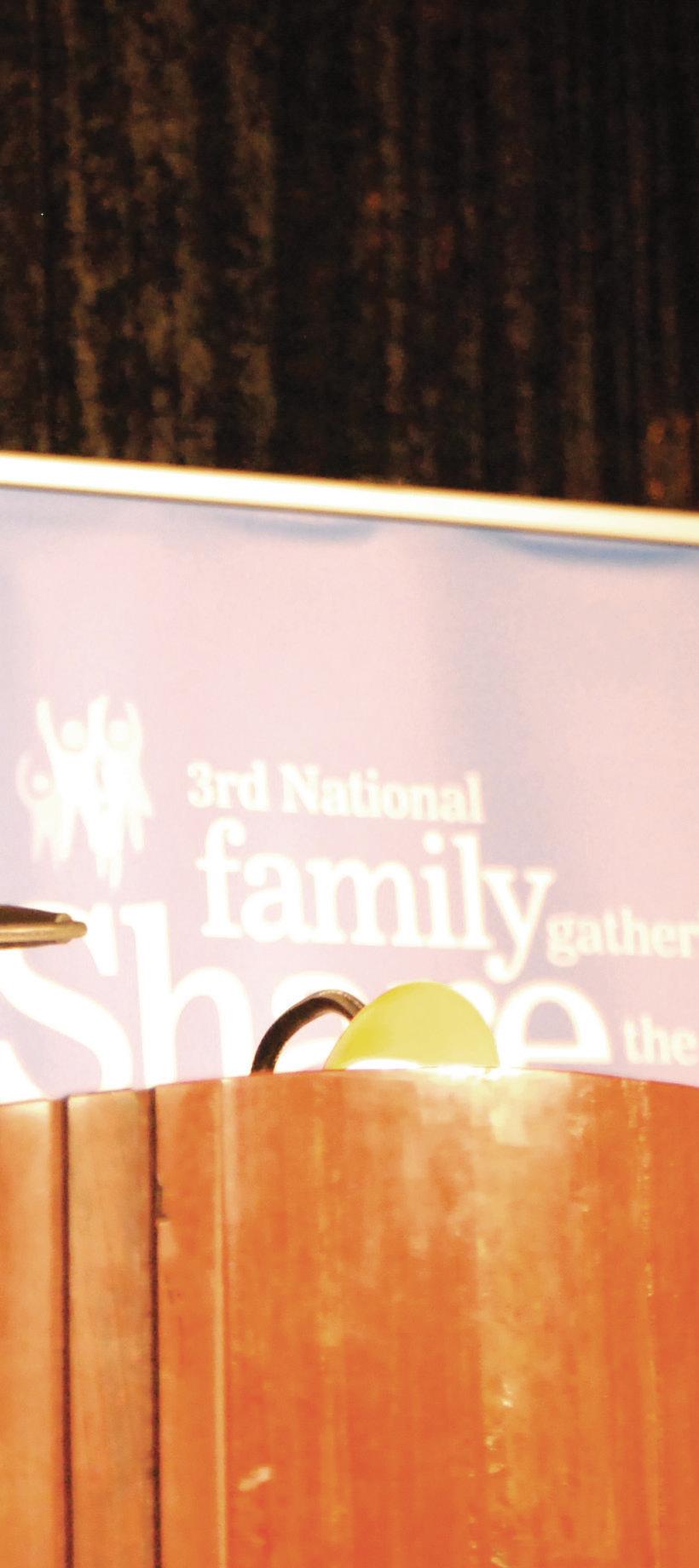
response of Jesus, if you remember, is such: beginning it was not so. Have you not read the beginning that the Creator made and female? For this reason, a man his father and mother and be joined to And the two shall become one flesh’,” he paraphrasing.
mysteries of love - the beauty of love “inscribed truly in creation” and “another steadfast love that unites Christ to His interpenetrate one another, he said.
John Paul II, in a Wednesday catechesis human love, wrote, “Man becomes the God not so much in the moment of solimoment of communion. Right “from
the beginning,” he is not only an image in which the solitude of a person who rules the world is reflected, but also, and essentially, an image of an inscrutable divine communion of persons”.
In this “extraordinary sentence,” Bishop Laffitte said, “we can relate our love, family love, marriage to this love, which exists in God in a divine communion of the divine persons in the Trinity.”
A relativistic vision of love does not permit one to perceive the natural beauty of love, he said.
But the Church sees herself obligated, in light of Revelation, to deepen more the implication of the truth of marriage and the family; the divine design for this community of life, the Bishop said.
What demands does the Church make on a man and woman who want to marry?
“The first is about mutual consent: the freedom of the person. And the reciprocity of the gift is an objective verification of love and certainly the condition for the happiness of the spouses,” he said.
The second demand is about the irrevocable character of the conjugal covenant, he said.
That marriage is indissoluble is not particular only to the Catholic Church, but rather it “belongs to the intrinsic nature, to the very essence of human love,” because love is a gift.
“It is true that the sacrament reinforces and consolidates indissolubility but it does not bring it into existence. It’s not an exterior addition but rather a permanent quality proper to a marriage validly contracted,” he said.
A third demand that the Church makes upon the spouses is that they are “open to life”, as within the Creator’s design this union is “oriented not only towards the personal good, the union of the love of the spouses but also to the service of life.”
After all, the transmission of life does not all depend always on the will of the spouses, he said but, borrowing terms used in the encyclical, Humanae Vitae, Bishop Laffitte said it is about the loving availability to present acts from which the possible consequence is the coming into existence of a new human being.
He clarified that the call to ‘be fruitful and multiply’ in the Biblical sense is not “a categorical imperative” but “primarily a benediction, a blessing, that when it is welcomed, opens the heart of the spouses to the joy of the gift of life and to the joy of participating in the act of the creation”.
“That’s why the spouses are called ‘pro-creators’ because only God creates,” he said. Bishop Laffitte
then turned his attention to forgiveness and its place in the nature of love.
What can forgiveness - pardon - add to the beauty of human love?
However beautiful the love of the spouses might be in our eyes, it “is always something a little altered,” the Bishop said, “damaged by the infirmity of sin,” a condition belonging to everyone.
“Sin is an objective disaffection from the original light of God; it does not only refer to an action that contradicts the will of the Creator, but also to the objective state we are in of the human condition that has lost the splendour of its beauty,” he said.
Because of this, all human love finds itself in need of constant purification, so that something of its first beauty might be restored in it, he said.
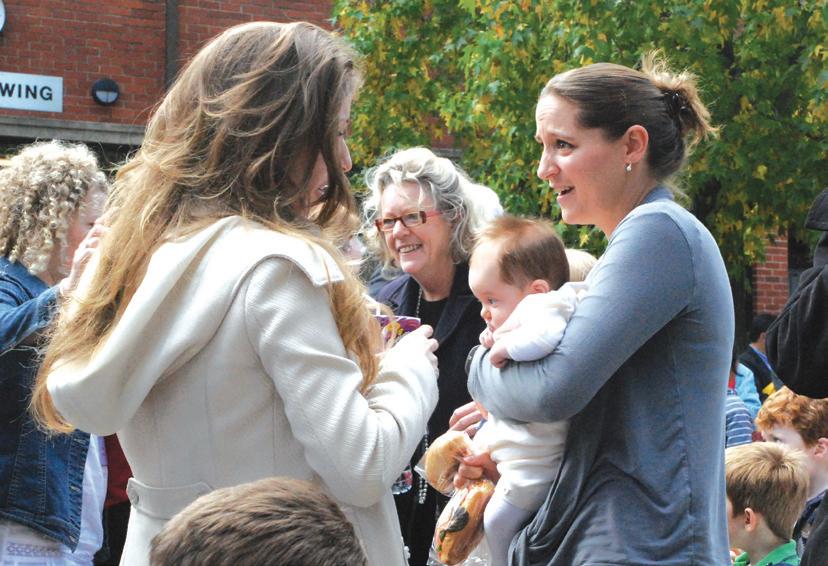
The mystery of this purification is found within forgiveness, he said.
Forgiveness is not only an act by which a grave offence is remitted but is also, he said, a “disposition of love that embraces weakness, the sins and the infirmities, the insufficiencies of the conjugal spouse”.
The word “pardon” comes from the Latin, per dono, where per describes something of perfection, of achievement, and dono means gift. “Per dono is dono which is, a perfect gift,” he said.
“Love’s capacity to offer eventual forgiveness attests to its authenticity and in so doing verifies its origin,” he said.
“A love that excludes pardon is by definition destined to end and die.” Christian marriage has -
as its particular vocation - to express a little of the mystery of the eternal union between Christ, the spouse, to His Church, he said.
“The capacity to signify and actualise the union of Christ and the Church belongs in nature to this community of life and of love between man and woman that is marriage,” he said.
“The relationship between the gift of Christ and the gift that spouses make of their life is not symbolic. The one and the other are two mysteries of love and of the transmission of life. The sacrifice of Christ in the Eucharist comes from a definitive victory over death.
“The irrevocable, indissoluble and indestructible covenant of Calvary has rendered human nature capable of such an irrevocable, indissoluble and indestructible union,” he said.
The love of Christ for His Church is by nature a love that pardons, he said. “The Eucharistic sacrifice is the place where this union between Christ and the Church is re-actualised,” he said.
Because of this, the love of the spouses must be “sacramentally invigorated” by this divine source in order to become a love that always is more capable of pardoning, of forgiving, he said.
When forgiveness takes place in marriage, it is an “expression of conjugal fidelity,” and “it actualises the initial alliance of the spouses,” Bishop Laffitte said.
“And when you say ‘I forgive you,’ it is exactly the same as saying ‘I make a covenant again with you’. It is an actualisation of the covenant. For this reason, pardon is inscribed within the logic of love because it is a gift,” he said.
Forgiveness, pardon, is rendered a perfect expression of love to the measure in which it expands the limits of it, he said.
The fact that we can say that God loved us means and includes the fact that we have been forgiven - this divine love is a forgiving love, he said.
God constantly remakes His covenant with us as couples, as a family and as a person, he said, primarily with His people and then with each one of His sons.
“When the spouses are brought to pardon each other, they bring about the sublime testimony that love is stronger than death and they carry within the assurance of eternal life,” he said.
Therein lies “our true hope for the future,” he said. n
the family as key mission of the Church
as a Father. Maltese-born Bishop Joseph Grech, former Bishop of Sandhurst, was included in the programme but died unexpectedly on 28 December last year after the recurrence of a blood disorder. To honour his memory, Diana Tomic from the Croatian Community said a few words of tribute.
Under Bishop Joe’s leadership of migrant communities, they felt loved and encouraged, Diana said.
“He taught us that as Catholics we have to be FAT - Faithful, Available and Teachable,” she said.
The keynote addresses were spliced by the testimonies of various married couples who gave personal witness to the ways they as a family had either been evangelised to or been able to evangelise to others through their marriage.
Each couple was unique, distinct.
There was a two-thirds majority of participants who had come from the Melbourne Archdiocese, such as Andrew and Karla Zmegec who are in the parish of Mt Evelyn. They brought their family of six children and said they loved the experience.
They came to learn and keep up to date with Church teaching, they said.
“Ignorance is a big stumbling block with these issues,” Andrew said.
But they also came for the social aspect of the weekend; for the chil-
dren to mix with other children and to see the witness of other families.
Luiza and Italo Oñaderra, a Brisbane couple with a family of four children under the age of nine, said they combined their trip to Melbourne to attend the conference with a family reunion with Italo’s Chilean family who live in Melbourne.
Luiza said they heard about the Gathering from a friend in the Emmanuel Community.
They said they would take away a lot of new information, especially about parenting, after attending the workshops.
“It’s making our job a little easier,” Luiza said of the conference, as they have discovered new resources on parenting and gained encouragement. “And it’s nice to meet likeminded people here,” she said.
Some of the material from the weekend will be part of a presentation Luiza and Italo will give at an upcoming monthly family gathering they are part of that meets every fourth Sunday.
The programme was supported by the presence of many priests and Religious and eight Bishops including Archbishop Denis Hart of Melbourne; Papal Nuncio, Archbishop Giuseppe Lazzarotto; Bishop Eugene Hurley of Darwin; Auxiliary Bishop Terry Brady;
Melbourne’s Vicar General and Auxiliary Bishop Leslie Tomlinson who attended the opening night. Bishop Anthony Fisher of Parramatta and Melbourne Auxiliary Bishop Peter Elliott were part of the programme on the second day of the conference.
Bishop Elliott is director of the John Paul II Institute for Marriage and Family Studies in Melboure, while Bishop Fisher, a Dominican, was organiser of World Youth Day 2008 in Sydney and is a leading bioethicist.
On the Gathering’s opening night, Bishop Eugene Hurley of Darwin and chair of the Australian Catholic Bishops Conference’s Commission for Pastoral Life, recalled meeting the Holy Father in Darwin during his trip to Australia for World Youth Day.
“When he asked me what I did as a Bishop, I replied ‘Families’ and he said, ‘Bishop, there is nothing more important for the Church than to be working with and for families.’”
The next day, Bishop Hurley said the Gathering highlighted “what a treasure” families were to the Church and to the world.
He said it was important “for us as Bishops to hear you” and, holding back tears, on behalf of the Australian Catholic Bishops Conference he said, “how deeply grateful” he was for
what the families offer the priests and Church in Australia. “What we need is more of this where we listen with our heart,” he said.
There were 230 children among the throng that gathered in Melbourne that weekend and there was a coordinated effort to cater for children above the age of two and young adults up to age 25.
While the main talks and workshops were on, the St Vincent de Paul Society’s youth members ran a programme to cater for children 3-6, 7-9 and 10-12 years of age.
The Youth Mission Team ran a programme for teenagers 13-15 year olds while the programme for young adults 16-25 year olds included a catechesis from Bishop Lafitte, time for Adoration and a presentation for the young men by Jonathon Doyle and for the young women by Dr Brigid McKenna. Communal prayer was also a key part of the weekend. Members of the Neo-Catechumenal Way led everyone in Vespers (Evening Prayer) on Friday night as well as Lauds (Morning Prayer) on Saturday and Sunday morning.
The Chapel was also open the whole time for Eucharistic Adoration and confessions were available on Saturday afternoon from 2-5pm.
Archbishop Denis Hart celebrated the Closing Mass for Palm Sunday
after which he announced that he would be recording a video greeting for the Pope’s birthday on 16 April.
“Dear Holy Father, we, your sons and daughters of Melbourne, Australia have gathered with great joy and hope for the National Family Gathering.
“Holy Father, we thank you for your teaching and guidance; we thank you for your personal holiness and we thank you for your beautiful message for the success of this Gathering.
“Our time together has been a time of reflection, joy and celebration. We have concluded this celebration with the Mass of Palm Sunday and we remember you, as you’re about to celebrate Palm Sunday in St Peter’s Square,” the Archbishop of Melbourne said.
“May Christ Our Lord and Saviour be with you always. We thank you, we love you and we are praying for you constantly with our love and doing all that we can do to build up your holy Church, God bless you Holy Father,” he said.
Everyone cheered.
Melbourne Archbishop Denis Hart told The Record that the Gathering was a tremendous encouragement. “It’s tremendous encouragement for all families but it helps us to know that family life in the Church is alive and well.”
4 May 2011, The Record
Page 7 Vista
love
and the family all go together, the PHOTOS: BRIDGET SPINKS
Friends catch up between talks.
The Parish
Little Sisters host wedding reception of fashions
Glendalough carers for aged and elderly turn Royal Wedding into a memorable day for resident family
By Bridget SpinkS
The marriage of Prince William and Miss Catherine Middleton brought the residents, staff and friends of the Little Sisters of the Poor together, as the Home of the Aged in Glendalough held their own Royal Wedding Reception on 29 April.
On behalf of the Little Sisters of the Poor, Yvonne Stone from the Diversional Therapy department, sent well wishes to the Queen for her son’s wedding and advised her of the plans afoot to mark the occasion at the Glendalough Home for the Aged.
Within the month, there was a reply in the mail from Buckingham Palace in gratitude from the Private Secretary and the Queen.
“The Queen has asked me to thank you for your congratulations and kind good wishes for the couple’s future happiness in their life together, and to convey to you, the residents and staff, her warm good wishes for the programme of celebrations on Friday, 29 April,” Sonia Bonici, Senior Correspondence Officer, wrote in the letter.
The day began with 9am Mass in the Chapel and all those attending the Wedding Celebration had to be seated by 11am in “Reception Centre” for the Bridal Fashion Show parade of precious wedding gowns generously donated by residents’ relatives, staff and friends.
As corsages were given to adorn all the ladies and buttonholes were given to the gentlemen, Nancy O’Sullivan warmed up the guests with a musical interlude of I’m Getting Married in the Morning Staff and friends of Glendalough had volunteered to model the flower girl, bridesmaid and wedding dresses from the 1960s to now.
As each young lady took a turn about the hall, Yvonne and Sr Angela detailed the history behind each dress, and described its fashion elements and beauty.
The first wedding gown, modelled by Caroline, was worn by Shirley Metcalf on her wedding day on 28 March 1959.
“Notice the petite waist and very full skirt with leupa lace nylon flowers sewn all over the skirt ending with a frill.” Each of the 22 dresses was described with such detail.
Felicity Caratti modelled the last wedding dress, which was her own. She was involved because her mother is the residents’ hairdresser.
“I’ve always helped out here and the elderly love it,” Felicity said. “I grew up here.”
Sitting among the audience was Subiaco-born Sheila Stade, 96, who was married to Eric Patrick Stade in 1934. She said the day brought back memories of the happiness she had before her husband went to war. They have one son, Allen, four beautiful grandchildren and eight great-grandchildren.
Sheila, who has been a resident for four years in Glendalough, said that they have everything there to make them happy.
“To be here is my home for the rest of my days; it’s been like leaving home to coming home,” she said.
Linda Wisolith, who is part of the Diversional Therapy team at Little Sisters and also modelled one of the dresses, said that the day was about “focusing on the specialness of the spirit of marriage”.
Months and weeks of careful planning went into the Glendalough


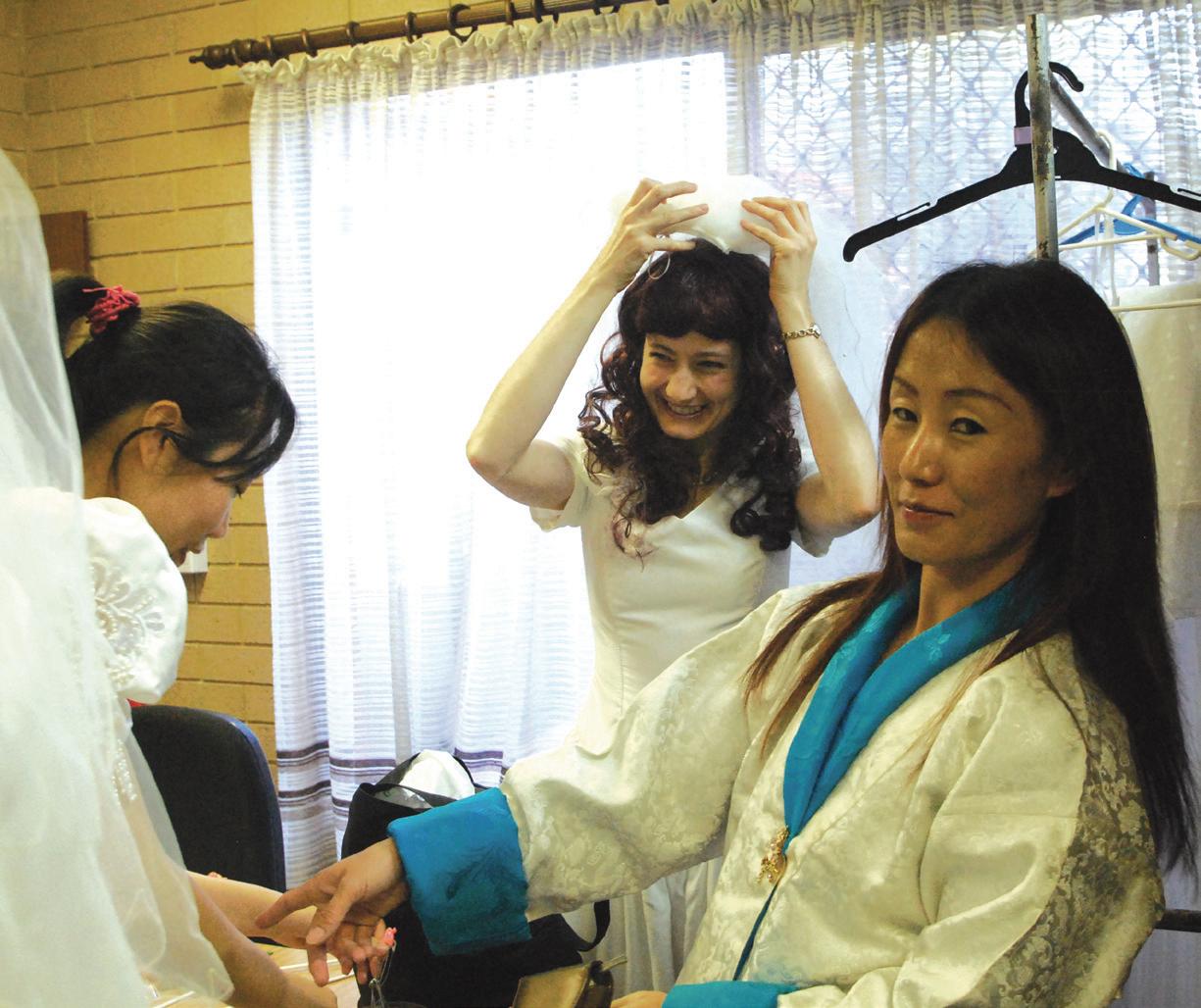
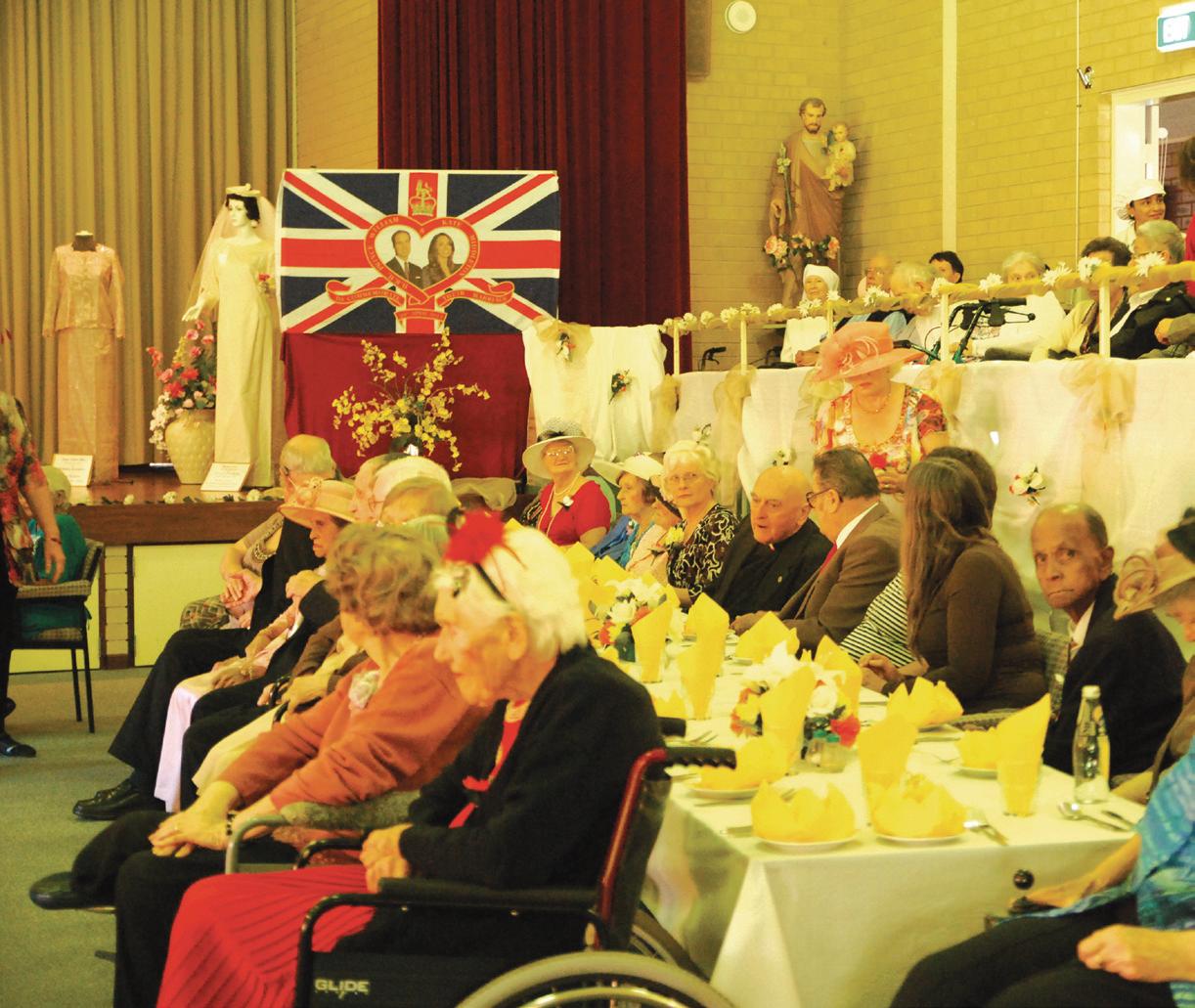
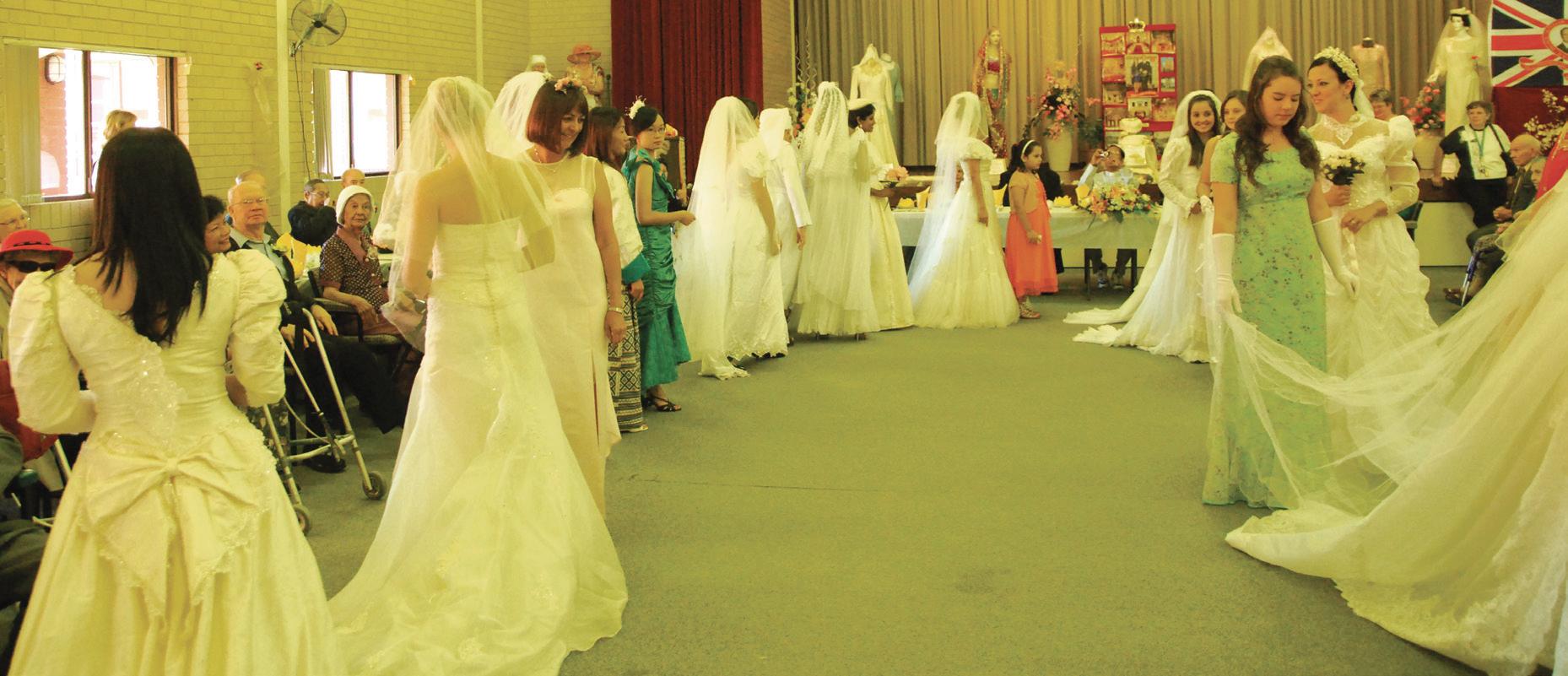
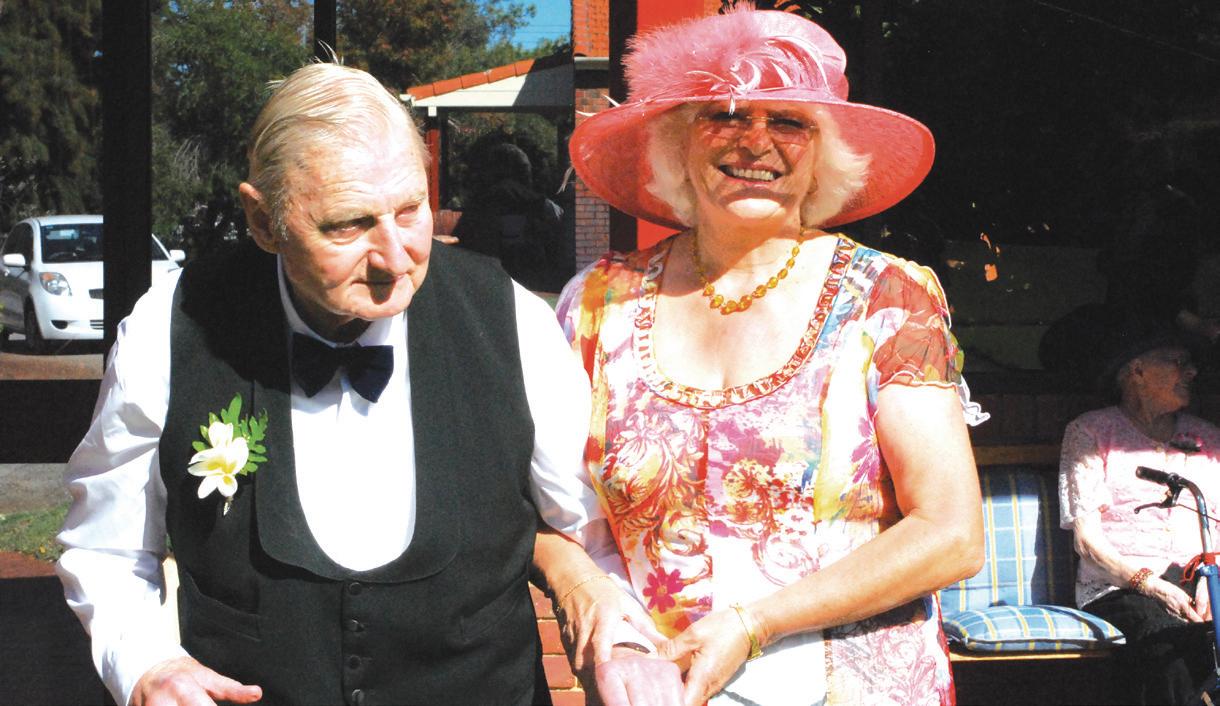
Wedding Day; the residents had each received invitations to attend the Wedding and a display of collected Wedding photos took pride of place in the Home’s Marian Centre foyer – the earliest photo was taken in 1926; the most recent, in 2010.
“It brings dignity to the residents,” Linda said of the display. “Because it reminds us that they were once youthful and in love; their meaningful lives and stories of the past are still very much part of who they are now.”
After the Fashion Show, Sr Angela LSP quoted some words on the art of marriage – a good one must be created.
“It is never being too old to hold hands – and remembering to say ‘I love you’ at least once a day,” Sr Angela quoted someone anonymously. Then the residents were served a Wedding Breakfast. There was a toast and the cutting of the cake and later, the Royal Wedding was to be broadcast on the big screen for the residents who could make it from 5pm.
Little Sister of the Poor, Sr Mary John, said the occasion tightened “the family spirit”.
Coincidentally, the royal couple will share the same wedding anniversary as the parents of the founder of the Little Sisters of the Poor, St Jeanne Jugan, who were united in marriage on the same day, 228

years ago.
Sr Angela, too, spoke of the family spirit – “Let us today form a circle of love that gathers our whole family as one” – as well as of the beauty of life.
“Residents, we care about you now in the evening of your lives, we care also about your past, about your future,” she said.
The parade, above, is a history in modern wedding fashion: the first wedding dress was worn in 1959, four were worn in the 1970s, three in the 1980s and five were worn in the 1990s. Salam, right, models a Juliette style gown with a round neckline and puffed sleeves, made of ivory silk worn by Dr Cathy Horton in 1984. Glendalough resident, John Bollard with Yvonne Stone, from the DT department get ready on the big day. PHOTOS: SPECIAL BRIDAL CORRESPONDENT BRIDGET SPINKS
4 May 2011, The Record Page 8
Felicity Caratti, above left, models her own bridal gown in the Glendalough Bridal Fashion parade on 29 April. Flower girls and a page boy, above right, wait patiently for proceedings to begin. Linda Wisolith, below left, adjusts her veil and models a dress worn by Jane Borg in 1997. Guests, below, wait for the parade.
Life,
Anna Krohn

God’s fiery and unifying grace in the heart of a woman
One of the blessings of Catholicism, as GK Chesterton among others has noted, is that it offers such a wide-screen vision upon the ironies of history, the paradoxes of culture, upon human foibles and upon God’s boundless mercy.
Often these dramatic elements fall together in suggestive and mysterious ways, which defeat our mundane assumptions.
Perhaps this week provides an example. Falling within a few days of each other are Pope John Paul II’s beatification, Easter Week, Divine Mercy Sunday, the Feast of the great St Catherine of Siena and, yes, THAT wedding.
Now at one level, the coinciding of the royal wedding and the beatification has spawned a whole swamp full of scornful twitters and tweets. Fervid anti-Catholics have denounced the gracious prayers of English Catholics for the royal couple and morose liberals have denounced the outpouring of royalist or papalist sentiment.
While millions have been drawn to the Royal Wedding and to the Pope’s Beatification, fewer people had noticed the role of St Catherine of Siena - Doctor of the Church, Patroness of Italy and co-patroness of Europe. While the world was watching the Wedding, I was with a group of hospitable Dominicans celebrating St Catherine’s day and musing on her place in both past and present world events.
What is going on, they asked, when a glamorous and highly secularised Anglican woman, who lived a typically secular life thus far, decides very consciously it seems, to plan her wedding on her patron saint’s feast day?
The first Catherine chopped off all her hair as a protest against a prestigious marriage and lived a

Every marriage is a royal event
life of austerity and chastity a universe away from Kate Middleton’s experience.
Was the Duchess of Cambridge only indulging in superficial cliparting of St Catherine into her wedding invitations, the press releases and the wedding homily?
Or is St Caterina Bernincasa, canonised so many years ago (1461), in some odd way really beginning another one of her courageous maternal missions into the heart of Europe’s leaders?
A community of Dominican Sisters in England for one are backing sanctity over cynicism. The Royal Wedding is an oppor-
tunity for them to highlight that all Christians can follow Jesus Christ in St Catherine’s footsteps in more than royal icing. One of their postulants has been “tweeting” about St Catherine, the Church’s teaching on marriage and convent life (@SrSadoraBloom England).
These Sisters have seen that St Catherine’s passionate spousal love for Christ, magnificently revealed in her Dialogues (one of the classics in the literature of the late middle ages) opens up a means for love in all Christians, consecrated and married, Sienese or British, commoner or royal.
As the Anglican Bishop of London also pointed out, any Christian marriage is both a royal event and one which opens a crack in our universe for genuine hope and aspiration. This is represented explicitly in the Byzantine tradition, where each couple is “crowned” as they represent sacramentally the spousal covenant of Christ and the Church.
Even in our trash culture – we recognise, vaguely, that a bride and groom stand as “restored” king and queen, a re-crowned Adam and Eve, standing at the dawn of the Christ’s new creation. Christopher Pearson (The Australian 30 April)
There is no contraceptive for the human
Last month, the Federal Government unveiled draft legislation to introduce plain packaging laws for cigarettes.
Health minister Nicola Roxon was unequivocal in her determination to put the final nail in the coffin of the tobacco industry.
Showing off the new compulsory olive green packaging with the vivid images of clogged arteries, cancerous gums and gangrene-infected feet, the minister declared, “We are going to ensure that in Australia there are no remaining avenues for tobacco companies to market and promote their products, particularly to young people. Gone are the days when people can pretend that cigarettes are glamorous.”
I have never smoked, have never had any desire to smoke and nothing frustrates me more than walking down the street and breathing in the secondhand smoke of the person puffing away in front of me, but this latest legislation push does cause me to wonder about the haphazard approach that federal policy takes to the health of its citizens.
What is most frustrating is the hypocritical approach given to other public health issues, in this instance the deceptive and falla-
Foolish
 By Bernard Toutounji
By Bernard Toutounji
cious ‘safe sex’ campaign that is sold to young people via various well designed and sexy governmental websites and videos.
The current, official, safe sex, Federal Government website tagline is “STIs are spreading fast, always use a condom”.
This is accompanied by a young, naked, attractive couple embracing one another.
The message is all about condoms stopping everything from HIV to Chlamydia to Gonorrhoea.
The site contains interactive games and activities to get across the condom message.
It even ran a national competi-
tion to design a ‘condom tin’ to make carrying condoms “as normal as carrying your mobile phone”. The problem is that the condom is not dealing with the issue, it is just skirting around it. And the issue which no government in the 21st century would be game enough to speak out about is sexual promiscuity.
In 2005, the government banned terms such as ‘light’, ‘mild’ and ‘extra mild’ on tobacco packaging as it gave the false impression that some cigarettes were less harmful than others.
Yet here we are in 2011, still telling young people that it is fine to toy with diseases such a HIV and Syphilis so long as they use a thin rubber sheath.
There was a major TV ad campaign run last year in which the entertaining and simplistic message was “Anyone can get Herpes” (anyone who is having promiscuous sex, that is).
Before that there was the highly visible campaign promoting the cervical cancer vaccine ‘Gardasil’ which was given out free by the Australian Government to any females aged 12 to 26.
The aspect that was not highly discussed in the popular media was
was right when he defended the Queen’s protection of the religious ceremonial of the wedding from the trite (and un-funny) antics of the ABC’s “the Chasers”.
Any mother would.
Even a passing knowledge of St Catherine of Siena’s personality and life might suggest an inspiration to a young woman who might suddenly realise the seriousness of Christian life and public duty.
Pope Benedict XVI noted in his audience late last year that St Catherine is not a private spiritual guru but a force to be reckoned with. “… people fascinated by the moral authority of this young woman with a most exalted lifestyle … they put themselves into Catherine’s service … and called her “mother”.
He pointed out that St Catherine had an ecstatic and exuberant love of Christ which inspired others to Christian love and justice.
Some of these people were the rulers of the Europe of her time - including Charles V, Louis the Great and the Pope himself.
She also put herself physically and spiritually into the firing line as a broker of peace and mercy - to prisoners, sick, those to be executed, between feuding factions and between disputants within a divided Church.
This is precisely why in his Motu Propio of October 1999, the newly beatified Pope John Paul II saw St Catherine’s remarkable mission not only to reform the face of Italy and the Church as a whole but also her tireless mission to convert the hearts of the nobles and monarchs of Europe and to unify all Christians. “... she insisted that they could not govern as if the realm was their ‘property’”: knowing that they must render to God an account of their exercise of power, they must instead uphold “holy and true justice” and become “fathers of the poor”.
To the King of Hungary, St Catherine urged that the “exercise of sovereignty was not to be separated from the exercise of charity, which is the soul both of one’s personal life and one’s political responsibility.”
How interesting, then, that the holy Catherine should be evoked by a potential king and queen in a Church which first divided itself in the events of a series of royal divorces and re-marriage.
heart
that cervical cancer comes about as a result of the human papilloma virus which is a sexually transmitted disease.
So, instead of speaking to 12 year olds about the value of who they are and what sex is, we injected them with a vaccine.
In these campaigns, we see something very different to what goes on in the war against tobacco.
The government is closing down all avenues left for the promotion and sale of tobacco products, yet in the ‘fight’ against deadly sexually transmitted infections the best they can say is, wear a condom and get an injection. What they are not saying is that a sexually promiscuous lifestyle is fraught with the risk of disease and heartache.
What is needed in the ‘safe sex’ campaign is an injection of truth. The safe sex message is all about information; it needs to be about formation.
What young person wants to put themselves at such a high risk of disease? Women who use the pill for four years or longer prior to their first full term pregnancy have a 52 per cent higher risk of cancer than those not on the pill.
That sort of risk is seemingly acceptable, yet last year Toyota
recalled 26,000 cars because 0.3 per cent of them experienced a slow brake fluid leak.
What about the fact that girls who are sexually active are more than three times likely to be depressed as girls who are abstinent prior to marriage? Teenage boys who are sexually active are more than twice as likely to struggle with depression and are more than eight times likely to attempt suicide.
Those who are sexually active prior to marriage have a significantly increased risk of divorce. For a man who marries as a virgin, his chance of divorce is 63 per cent lower than a non-virgin. For girls, it is 76 per cent lower when they marry as virgins.
Sadly, general Western society has fallen into the pit of relativism so we are impotent (excuse the pun) to stand up and actually say that promiscuous sex is not glamorous, that it is better to wait until marriage to be sexually active because there is a far higher chance of happiness on every level and a genuinely decreased risk of a diseased body and diseased emotions. After all, there is no condom for the heart.
b_toutounji@optusnet.com.au
the Universe and Everything
Francesco Vanni’s The Mystic Marriage of St Catherine of Siena (1602) depicts something our “trash culture” vaguely recognises - that a bride and groom stand as a ‘restored’ king and queen, a re-crowned Adam and Eve. It was apt, therefore, that St Catherine’s feast day fell on the same weekend as the Royal Wedding.
Wisdom
4 May 2011, The Record PERSPECTIVES Page 9
“a foolishness wiser than human wisdom” (1 Cor 1:25)
FRIDAY, 13 MAY
Annual Feast of Fatima
7pm at the Basilica of St Patrick’s, Fremantle. The Portuguese community will celebrate the Feast of Our Lady of Fatima, followed by a Procession and Benediction. All are welcome. Enq: Connie 94941495.
FRIDAY, 13 MAY TO SUNDAY, 15 MAY
A Reflective Weekend for Young Women
1pm at St John of God Retreat Centre, 47 Gloucester Cr, Shoalwater. “Living by discernment, not by what you see and feel.” Learn how to make fruitful decisions in life and to understand the difference between Decision Making and Discernment by applying the values and principles of the Gospel to daily life. Enq: Sr Ann 0409 60 2927 or Sr Kathy 1418 92 6590.
SATURDAY, 14 MAY
Catholic Women’s Brunch
9.30-11.30am at The Witch’s Cauldron, 89 Rokeby Rd, Subiaco. There is ample public parking in several nearby locations. RSVP by Saturday, 7 May. Enq: Kate 9386 1551 or catholicwomen.perth@gmail.com.
Divine Mercy Healing Mass
2.30pm at St Francis Xavier Church, Windsor St, East Perth. The main celebrant will be Fr Marcellinus Meilak, OFM. Reconciliation in English and Italian offered. Divine Mercy prayers followed by Veneration of First Class Relic of St Faustina and prayers for an end to abortion. Refreshments later. Enq: John 9457 7771.
Holy Mass and Adoration
8.30am at Our Lady of Mercy, 5 Patrick Ct, Girrawheen. St Padre Pio DVD followed by Exposition of the Blessed Sacrament, Rosary, Divine Mercy, silent adoration and Benediction. Holy Mass, using St Padre Pio Liturgy. Confessions available. Bring a plate for shared lunch. Tea and coffee provided. Enq: Des 6278 1540.
Carmelite Silver Jubilee of Profession
10am at the Carmelite Monastery, 100 Adelma Rd, Nedlands. A solemn concelebrated Mass for the Silver Jubilee of Sr Sesimani Teresa of the Sacred Heart will be offered. Bishop Sproxton will be the principal celebrant. All are most welcome to the Mass and morning tea afterwards.
SATURDAY, 14 MAY TO SUNDAY, 15 MAY
Catholic Faith Renewal Weekend Retreat
9am- 6pm (daily) at James Nestor Hall, Catholic Education Centre, 50 Ruislip St, West Leederville. “Living life to the fullest in Christ” by Fr Henriques. Admittance by registration only. Enq: Kathy 92950 913, Ann 0412 166 164 or Rita 9272 1765, catholicfaithrenewal@gmail.com.
SUNDAY, 15 MAY
May Sunday Sesh
6pm Mass, and Sunday Sesh 7.15pm at St Gerard Majella Parish, Ravenswood Dr and Majella Rd, Mirrabooka. The largest youth night in May! Open for youth of all ages (pref 15-35). The night includes games, formation and fun. More details on www.cym.com.au or call 9422 7912.
Religious Vocation Inquiry Day
9.30am at St Charles’ Seminary, 30 Meadow St, Guilford. Men aged 17 and over who wish to explore the possibility of a vocation to the diocesan priesthood. Begins with morning prayers with the Seminarians followed by Mass at 11.30am and the well-known ‘Seminary’s Fabulous Sunday lunch’ at 12.30. Enq: Helen 9279 1310.
The World Apostolate of Fatima
3pm at Our Lady of Assumption Church, 356 Grand Prom, Dianella. All welcome. Enq: 9339 2614.
FRIDAY, 20 MAY
Divine Mercy Prayer Group – 3rd Anniversary Celebration
2-5pm at St Jerome‘s Catholic Church, 36 Troode St, Munster. All are invited to the celebration. There will be Exposition of the Blessed Sacrament, Divine Mercy Chaplet, Mass by Fr Varghese Parackal VC and healing. Enq. Connie 9494 1495 or Edita 9418 3728.
MONDAY, 23 MAY
Monthly CYM World Youth Day 2011 Pilgrimage Meeting
7.30pm at Perth Catholic Pastoral Centre, 40A Mary St, Highgate. All pilgrims are invited to attend as we count down to Madrid, meet other pilgrims and get practical preparation tips for Madrid. For specific WYD tours’ registration, log onto www.wydtours.com/perth. Registration closes on 15 May!! For more info, log onto www.cym.
com.au and fill out expression of interest form, or Perth WYD Pilgrim Facebook for regular updates or phone 9422 7912.
WEDNESDAY, 25 MAY
‘An hour for Sheen’ Variety Concert
7.30pm at Gibney Hall, Trinity College, East Perth. Featuring St Joseph’s Chamber Choir; Yan Kee soprano; Daniel Mullaney baritone; June Glen poet and raconteur; John Meyer pianist. Part of the proceeds to two overseas missions and the supporting of the Cause of Servant of God Archbishop Fulton J Sheen. $27.50 inc supper. Pensioner and Senior discount. Credit card payment facilities available. Ample parking. Enq and tickets: Daniel 9291 8224, sheensociety@globaldial.com.
FRIDAY, 27 MAY
Medjugorje – Evening of Prayer
7pm at Our Lady’s Assumption Parish, 356 Grand Prom, Dianella. An evening of Prayer with Our Lady Queen of Peace including Adoration, Rosary, Benediction and concluding with Holy Mass. All welcome. DVD on Ivan’s visit to St Mary’s Cathedral in February (Ivan is alleged visionary from Medjugorje) available on evening or contact 9402 2480 or email medjugorje@y7mail.com.
FRIDAY, 27 MAY TO SUNDAY, 29 MAY
Rachel’s Vineyard Healing
Retreat for people suffering psychologically and spiritually due to a past abortion experience. Please include us in your prayers.
SATURDAY, 28 MAY
CYM Annual Ball
This year’s annual CYM Ball with the theme being ‘Recycle-ball’ will be stunning! Board the James Stirling, the largest vessel of Captain Cook Cruises and be prepared to be tempted by delicious buffet and then dance the night away. Ship departs at 7.30pm. Attire, semi formal. The recycle-ball theme promotes using classy secondhand outfits from op shops, borrowed or preloved. Cost: $70 (alcoholic drinks will be sold at the bar). For tickets call 9422 7912 or email admin@cym.com.au.
FRIDAY, 3 JUNE TO SUNDAY, 5 JUNE
Weekend Retreat for Teens – ‘Be Inflamed’
Come join Catholic Youth Ministry on an awesome retreat for teenagers aged 13-17 for a weekend of fun, activities, music and spiritual talks from fantastic speakers. Retreat cost is $60; registration forms can be downloaded from www.cym.com.au. Enq: admin@cym.com.au or 9422 7914.
WEDNESDAY, 5 OCTOBER TO THURSDAY, 20
OCTOBER
Pilgrimage to Rome, Lanciano, San Giovanni Rotondo and Medjurgorje. Bed and breakfast, evening meals, transfers, guide, flying Emirates $3,990. Enq: 9402 2480.
EVERY SUNDAY
Gate of Heaven Catholic Radio
Join the Franciscans of the Immaculate every Sunday from 7.30-9pm on Radio Fremantle 107.9FM for Catholic radio broadcast of EWTN and our own live shows. Enq: radio@ausmaria.com.
Pilgrim Mass - Shrine of the Virgin of the Revelation
2pm at Shrine, 36 Chittering Rd, Bullsbrook. Commencing with Rosary followed by Benediction. Reconciliation is available before every celebration. Anointing of the Sick administered during Mass every second Sunday of the month. Pilgrimage in honour of the Virgin of the Revelation, last Sunday of the month. Side entrance to the church and shrine open daily between 9am-5pm. Enq Sacri 9447 3292.
EVERY FIRST SUNDAY
Divine Mercy Chaplet and Healing Prayer
3pm at Santa Clara Church, 72 Palmerston St, Bentley. Includes Adoration and individual prayer for healing. Spiritual leader: Fr Francisco. All welcome. Enq: Fr Francisco 9458 2944.
EVERY SECOND SUNDAY
Healing Hour for the Sick
6pm at St Lawrence Parish, 392 Albert St, Balcatta. Begins with Mass, Exposition of the Blessed Sacrament and prayers. Enq: Fr Irek 9344 7066 or ww.stlawrence. org.au.
EVERY THIRD SUNDAY OF THE MONTH
Oblates of St Benedict
2pm at St Joseph’s Convent, York St, South Perth. Oblates are affiliated with the Benedictine Abbey of New Norcia. All welcome to study the rule of St Benedict and its relevance to the everyday life of today for lay people. Vespers and tea later. Enq: Secretary 9457 5758.
EVERY FOURTH SUNDAY OF THE MONTH
Holy Hour for Vocations to the Priesthood, Religious Life
2-3pm at Infant Jesus Parish, Wellington St, Morley. The hour includes Exposition of the Blessed Eucharist, silent prayer, Scripture and prayers of intercession. Come and pray that those discerning vocations to the priesthood or Religious life hear clearly God’s loving call to them.
EVERY MONDAY
Evening Adoration and Mass
7pm at St Thomas Parish, Claremont, Cnr Melville St and College Rd. Begins with Adoration, Reconciliation, Evening Prayer and Benediction. Followed by Mass and Night Prayer at 8pm. Enq: Kim 9384 0598, claremont@ perthcatholic.org.au.
LAST MONDAY OF EVERY MONTH
Christian Spirituality Presentation
7.30-9.15pm at the church hall behind St Swithan’s Anglican Church, 195 Lesmurdie Rd, Lesmurdie. Stephanie Woods presents The Desert Period of Christianity, 260 to 600AD. From this time period came the understanding of the monastic lifestyle and contemplative prayer. No cost. Enq Lynne 9293 3848.
EVERY TUESDAY
Novena and Benediction to Our Lady of the Miraculous Medal
6pm at the Pater Noster Church, Marmion and Evershed Sts, Myaree. Mass at 5.30pm. Enq: John 0408 952 194.
Spirituality and The Sunday Gospels
7-8pm at St Benedict’s school hall, Alness St, Applecross. The power of the Gospel message; How can we live meaningful and hope-filled lives? Presented by Norma Woodcock. Donation for The Centre for Catholic Spiritual Development & Prayer. Enq: 9487 1772 or www.normawoodcock.com.
Bible Teaching with a difference
7.30pm at St Joachim’s Parish hall, Shepparton Rd, Victoria Park. Exciting revelations with meaningful applications that will change your life. Novena to God the Father, followed by refreshments. Bring Bible, a notebook and a friend. Enq: Jan 9284 1662.
EVERY WEDNESDAY
Holy Spirit of Freedom Community
7.30pm at The Church of Christ, 111 Stirling St, Perth. We are delighted to welcome everyone to attend our Holy Spirit of Freedom Praise Meeting. Enq: 0423 907 869 or hsofperth@gmail.com.
Holy Hour at Catholic Youth Ministry
6pm at 40A Mary St, Highgate, Catholic Pastoral Centre.
5.30pm Mass followed by $5 fellowship supper. Enq: Stefania 9422 7912 or www.cym.com.au.
EVERY FIRST WEDNESDAY
Holy Hour prayer for Priests
7-8pm at Holy Spirit Parish, 2 Keaney Pl, City Beach. All welcome. Enq: Linda 9341 3079.
SECOND WEDNESDAY OF THE MONTH
Chaplets of the Divine Mercy
7.30pm at St Thomas More Church, Dean Rd, Bateman. Chaplet will be accompanied by Exposition followed by Benediction. Monthly event. All welcome. Enq: George 9310 9493 or 9325 2010 (w).
EVERY THURSDAY
Divine Mercy
11am at Sts John and Paul Church, Pinetree Gully Rd, Willetton. Pray the Rosary and Chaplet of Divine Mercy, and for the consecrated life, especially here in John Paul Parish. Conclude with veneration of the First Class Relic of St Faustina. Please do come and join us in prayer. Enq: John 9457 7771.
Fr Corapi’s Catechism of the Catholic Church 7.30pm at St Joseph Church, 20 Hamilton St, Bassendean - parish library. Enq: Catherine 9329 2691.
FIRST THURSDAY OF THE MONTH
Taize Prayer and Meditation
7.30-8.30pm at Our Lady of Grace Church, 3 Kitchener St, North Beach. Prayer and meditation using songs from the Taize phenomenon. In peace and candlelight, we make our pilgrimage. All are invited. Enq: Joan 9448 4457 or Office 9448 4888.
FIRST FRIDAY OF THE MONTH
Holy Hour for Vocations to the Priesthood and Religious Life
7pm at Little Sisters of the Poor Chapel, 2 Rawlins St, Glendalough. Mass, followed by Adoration with Fr Doug Harris. All welcome. Refreshments provided.
Catholic Faith Renewal Evening
7.30pm at Sts John and Paul’s Parish, Pinetree Gully Rd, Willetton. Songs of Praise, sharing by a priest followed by Thanksgiving Mass and light refreshments after Mass. All welcome to attend and bring your family and friends. Enq: Kathy 9295 0913, Ann: 0412 166 164 or catholicfaithrenewal@gmail.com.
Communion of Reparation All Night Vigils
7pm-1.30am at Corpus Christi Church, Lochee St, Mosman Park. Enq: Vicky 0400 282 357 and at St Gerard Majella Church, Ravenswood Dr and Majella Rd, Mirrabooka, Enq: Fr Giosue 9349 2315, John or Joy 9344 2609. The Vigils consist of two Masses, Adoration, Benediction, Prayers and Confession in reparation for the outrages committed against the United Hearts of Jesus and Mary. All welcome.
Healing and Anointing Mass
8.45am at Pater Noster, Myaree. Reconciliation, followed by Mass including Anointing of the Sick, Praise and Worship to St Peregrine and the Sacred Heart of Jesus. All welcome. Enq: Joy 9337 7189.
EVERY FIRST SATURDAY
Healing Mass
12.35pm at St Thomas, Claremont Parish, cnr Melville St and College Rd. Spiritual leader: Fr Waddell. Enq: Kim 9384 0598, claremont@perthcatholic.org.au.
EVERY FIRST FRIDAY
Healing Mass
7pm at St Peter’s Parish, Wood Street, Inglewood. Reconciliation, praise and worship, Eucharistic Adoration, Benediction, Anointing of the Sick, special blessings and fellowship after the Mass. Celebrants, Fr Dat (parish priest) and specially invited priests. All welcome. Enq: Priscilla 0433 45 7352, Catherine 0433 92 3083 and Mary-Ann 0409 67 2304.
FRIDAY, 8 TO WEDNESDAY, 21 SEPTEMBER
Cruise on the River Nile
14-Day package. Includes Tour/Sightseeing of Jordan and Egypt. Cost: $4,900 per person twin share (22 people). Accompanying priest: Fr Joe Carroll. Itinerary and Enq: Fadua 9459 3873 or 0404 893 877.
FRIDAY, 11 TO TUESDAY, 22 NOVEMBER
Pilgrim Tour To The Holy Land
Jordan, Israel and Egypt. Spiritual Director, Fr Sebastian Kalapurackal VC from St Aloysius Church, Shenton Park. Enq: Francis – Coordinator, 9459 3873 or 0404 893 877 or Skype ID: perthfamily.
EVERY DAY DURING THE MONTH OF MAY
Novena in Honour of Our Lady of Fatima 7-8.30pm at Holy Cross Church, Hamilton Hill. On Saturdays the novena will start at 6pm and on Sundays at 8am. All are welcome. Enq: Connie 94941495.
PILGRIMAGE TO PRAGUE, POLAND AND AUSTRIA
St Jude’s Parish, Langford is organising a 13-day pilgrimage departing 1 October. Pilgrimage will include visits to the Shrines of Divine Mercy, Infant Jesus, the Black Madonna, St Faustina, the birthplace of Pope John Paul II and the Museum at Auschwitz. Total cost per person $5,800. The Spiritual Director, Fr Terry Raj. Enq: Co-ordinator John Murphy 9457 7771, Matt 6460 6877 mattpicc1@gmail.com.
4 May 2011, The Record
Page 10
PANORAMA

LAWN MOWING
WRR LAWN MOWING & WEED SPRAYING Garden clean ups and rubbish removal. Get rid of bindii, jojo and other unsightly weeds. Based in Tuart Hill. Enq 9443 9243 or 0402 326 637.
OPPORTUNITIES
BUSINESS OPPORTUNITY
Work from Home - P/T or F/T, 02 8230 0290 or visit www.dreamlife1.com.
SETTLEMENTS
ARE YOU BUYING OR SELLING real estate or a business? Why not ask Excel Settlements for a quote for your settlement. We offer reasonable fees, excellent service and no hidden costs. Ring Excel on 9481 4499 for a quote. Check our web site on www.excelsettlements.com.au.
BOOK BINDING
NEW BOOK BINDING, General Book Repairs; Rebinding; New Ribbons; Old Leather Bindings Restored.Tydewi Bindery 0422 968 572.
ACCOMMODATION
HOLIDAY ACCOMMODATION ESPERANCE 3 bedroom house f/furnished Ph 09 9076 5083.

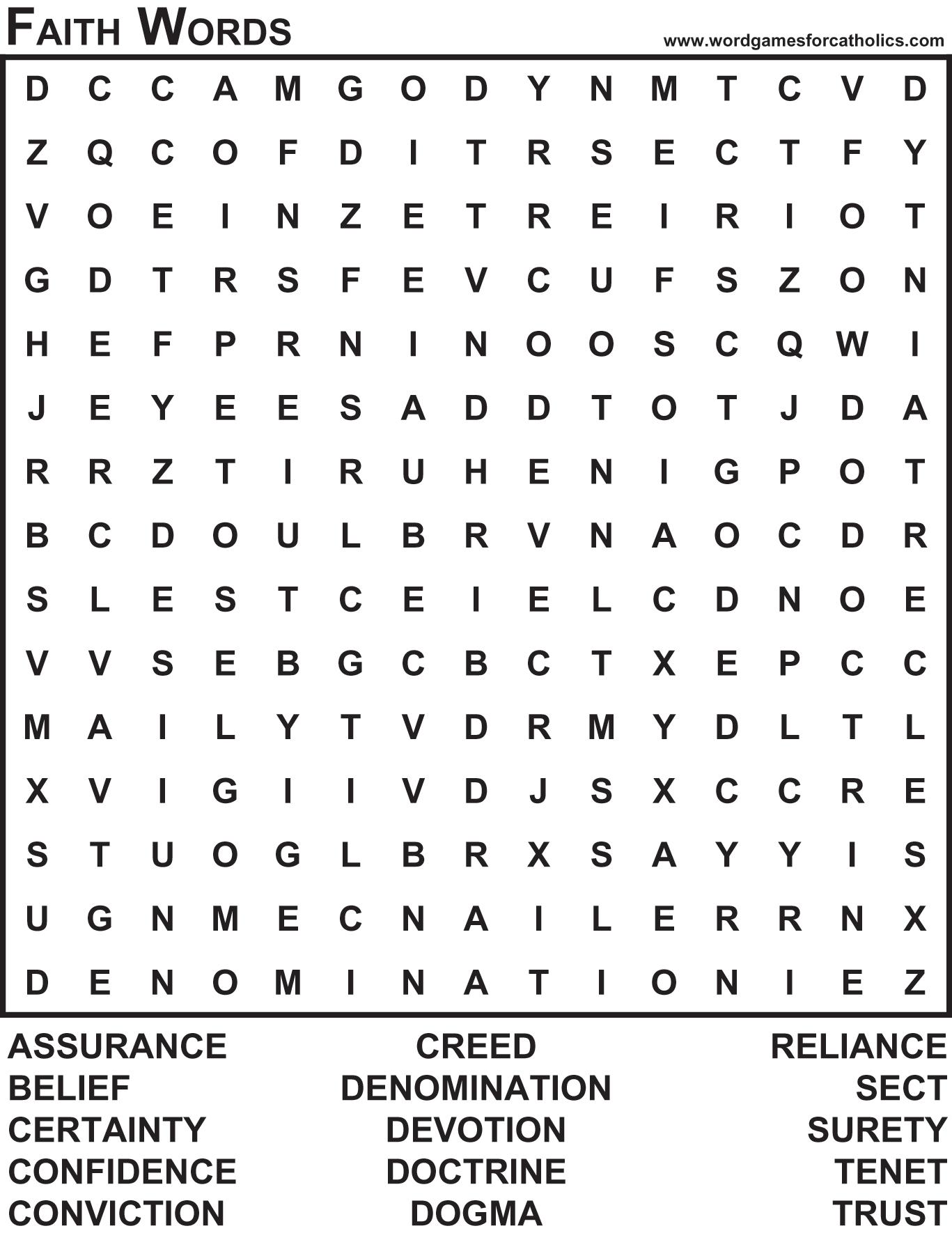
Deadline: 11am Monday
RELIGIOUS PRODUCTS
CATHOLICS CORNER Retailer of Catholic products specialising in gifts, cards and apparel for Baptism, Communion and Confirmation. Ph 9456 1777. Shop 12, 64-66 Bannister Rd, Canning Vale. Open Mon-Sat.
RICH HARVEST YOUR CHRISTIAN SHOP Looking for Bibles, CDs, books, cards, gifts, statues, Baptism/Communion apparel, religious vestments, etc? Visit us at 39 Hulme Ct (off McCoy St), Myaree, Ph 9329 9889 (after 10.30am Mon to Sat).
We are here to serve.
KINLAR VESTMENTS
Quality hand-made and decorated vestments: Albs, Stoles, Chasubles, Altar linen, banners, etc. 12 Favenc Way, Padbury. By appointment only. Ph Vicki on 9402 1318 or 0409 114 093.
OTTIMO
Convenient location for Bibles, books, cards CD/DVDs, candles, medals, statues and gifts at Shop 41, Station St Market, Subiaco. Fri-Sun 9-5pm.
DONATIONS
WE ARE SEEKING DONATIONS OF SCHOOL UNIFORMS for underprivileged schools in the Philippines. If you could assist, please contact Fr Robert Carrillo on 9456 5130. Thank you.
PILGRIMAGES
TRADE SERVICES
BRENDAN HANDYMAN SERVICES Home, building maintenance, repairs and renovations. NOR. Ph 0427 539 588.
PROPERTY MAINTENANCE. Your handyperson. No job too small. SOR. Jim 0413 309 821.
BRICK RE-POINTING Ph Nigel 9242 2952.
PERROTT PAINTING Pty Ltd
For all your residential, commercial painting requirements. Ph Tom Perrott 9444 1200.
PICASSO PAINTING Top service. Ph 0419 915 836, fax 9345 0505.
SALE
MOTOR HOME FOR SALE
2003 Mercedes Sprinter, 306 CDi. Low kilometres, VG condition. Many extras. Ready to go. Bargain at $48,000. Ph 9653 1794.
JOIN SISTER ISABEL BETTWY on a 13 day (includes travel time) pilgrimage to Poland in the Footsteps of St Faustina The 70th anniversary of the martyr death of St Maximilian Kolbe. Celebrate the 80th anniversary of Jesus appearing to Faustina Kowalska.
Attend the Mass and closing of the World Apostolic Congress on Divine Mercy in Lagiewniki.
Departing Perth on Wed, 28 Sep 2011
Cost: AU$4,900 per person twin share (minimum 18 people) + AU$ 800 single supplement. Francis Williams (tour coordinator).
T: 9459 3873 (after 4pm)
M: 0404 893 877 (all day) E: francis@perthfamily.com
Skype ID: perthfamily88
FURNITURE REMOVAL
ALL AREAS. Competitive Rates. Mike Murphy Ph 0416 226 434.
WALK WITH HIM
8 S 3RD SUNDAY OF EASTER
Wh Acts 2;14, 22-23 Raised to life
Ps 15:1-2, 5, 7-11 My soul is glad 1 pet 1:17-21 The blood of the lamb
Lk 24:13-35 breaking the bread
9 M Acts 6:8-15
PASTORAL
CARE COURSE FOR MINISTRY WITH THE MENTALLY ILL
For those wanting to know about mental illness, this 17 week course will run on Fridays, 8.45am to 3.30pm from 3 June to 23 Sep 2011. This course involves information sessions on schizophrenia, bipolar, suicide awareness, eating disorders etc plus group work and ward visits. Course donation of $100 is invited. Applications close 13 May. For more information, contact Bob Milne, Graylands Hospital, Pastoral Centre 9347 6685 (0413.32.5486 mob).
WANTED
ARE YOU INTERESTED IN
AUTISM SPECTRUM DISOR-
DER, have you worked with an individual with ASD or are you studying education and interested in social inclusion? This position, for six to eight hours/wk, is to co-ordinate the study and work schedule of a young man with ASD who will be studying at TAFE and working p/t. He is a high-functioning individual with a good sense of humour and a keen interest in Doctor Who Other tasks will be to help develop friendships, and work towards community independence. The client would benefit from a male role model, non-smoker, with a sense of fun and good organisational skills, living north of the river. Good salary and super for the right individual. If you are interested in finding out more, email Melissa on emmykelly@ bigpond.com.
FINANCIER WANTED
Small amount urgently required. Country couple. Ph: 0429 685 596
EASTER BLESSINGS
MICHAEL AND FRANCIS
JOHN AZAR
To my two precious darling sons wishing Almighty God’s love, peace and every blessing to you both at this Holy Easter Season and Divine Mercy, 1 May 2011. I am here for you both and I am thinking of you always, I will be praying for you on Mother’s Day as I do every day. I am longing to see you both and I wait with open arms to greet you and hold you as I did before when you were four and two years old. I love you with all my heart.
Your loving mother Janet
JESUS I TRUST IN YOU
11
12 Th Ss Nereus and Achilleus, martyrs (O)
Wh Acts 8:26-40 Do you understand?
Ps 65:8-9, 16-17, 20 Cry out with joy
Jn 6:44-51 All taught by God
13 F Our Lady of Fatima (O)
Wh Acts 9:1-20 Chosen instrument
Ps 116 Praise the Lord
Jn 116 6:52-59 Life-giving bread
Stephen’s wisdom Wh Ps 118:23-24, 26-27, 29-30 The way of truth Jn 6:22-29 Food that endures 10 Tu Acts 7:51-8:1 Stephen stoned Wh Ps 30:3-4, 6-8, 17, 21 Rock of refuge Jn 6:30-35 It was not Moses
Saul
destroyer
W Acts 8:1-8
the
Sing to
name Jn 6:35-40 The bread of life
Wh Ps 65:1-7
your
ACROSS 2 Holy images 5 Brother of John 8 Redemptorist community (abbr) 9 Number of sacraments, in Roman numerals 11 Catholic actor, Robert ___ 13 ___-Cana Conference 14 Plant in the story of the Fall 15 Book containing calendar of Masses 16 Commandment word 17 Book attributed to John 20 Texan Catholic university 22 What it did after Noah entered the ark 27 Bible sections 28 Wednesday that starts Lent 29 Liturgical leaf 30 Peter (with “The”) 32 Diocese of Honolulu necklace 33 “Love is not jealous, it does not put on ___” (1 Cor 13:4)
Holy day cusp 36 “Eternal ___ grant unto them”
Abraham was one 38 “When I became a man I put ___ childish things” (1 Cor 13:11) DOWN 1 Read at Mass 3 ___ Works of Mercy 4 Church section 5 An epistle 6 ___ culpa
Belief
Where Vatican City is 12 Catholic singing group, The ___ Sisters 18 Catholic custom of dropping into the Church to say a quick prayer 19 Shroud of ___ 21 Reformation character 23 Moved by God 24 Outer vestment worn by a deacon
White for a Pope, black for no Pope
Wife of Abram
Father of Jesse
I through XIII 34 Abbr for two OT books C R O S S W O R D W O R D S L E U T H LAST WEEK’S SOLUTION CLASSIFIEDS The Record. The Parish The Nation. The World 4 May 2011, The Record Page 11 CLASSIFIEDS
35
37
7
10
25
26
31
32

Our Lady and the Month of May





THE ESSENTIAL MARY HANDBOOK
A Redemptorist Pastoral Publication
RRP $27.95
A valuable treasury of the most important Catholic teachings about the Blessed Virgin Mary, The Essential Mary Handbook is an all-in-one resource for those who want a renewed appreciation of Mary’s fundamental role and significance in the Church today. This book defines Mary’s role in relationship to her son Jesus, as well as to God the Father and the Holy Spirit, and collects in one place information on her titles, her appearances, and her place in the liturgy.

There is a God
Antony Flew
RRP $27.95
In one of the biggest religion news stories of the new millennium, the Associated Press announced that Professor Antony Flew, the world’s leading atheist, now believes in God. Flew is a pioneer for modern atheism. His famous paper, Theology and Falsification, was first presented at a meeting of the Oxford Socratic Club chaired by C S Lewis and Flew earned his fame by arguing that one should presuppose atheism until evidence of a God surfaces. He now believes that such evidence exists, and There Is a God chronicles his journey from staunch atheist to believer. For the first time, this book will present a detailed and fascinating account of Flew’s riveting decision to revoke his previous beliefs and argue for the existence of God.



Questions and Answers about your Journey to God
Fr Benedict J Groeschel, CFR
RRP $25.95
If you could ask Fr Groeschel one question, what would it be? Should we have an established routine of daily prayer? How can we judge whether we are growing in the spiritual life? Are there danger signs to indicate we are moving in the wrong direction? What is the dark night of the soul? Can we be spiritual without being religious, without going to church? How has psychology influenced the modern view of the spiritual life? Discover the path God has intended for you with the guidance and support of Fr Groeschel himself.

Where the hell is God?
Richard Leonard, SJ
RRP $22.95
A powerful, experience-based help in making sense of tragedy and suffering.
There are libraries of books on theodicy, the branch of philosophy and theology that wrestles with how God can allow a world to exist within which there is suffering and pain. The problem with these libraries is that they contain books which are generally written by professionals for their peers. Where the Hell is God? combines the best of the professionals’ insights with the author’s own experience and insights to speculate on how believers can make sense of their Christian faith when experiencing tragedy and suffering.




THERosary





ILLUSTRATED
PAGE BY PAGE AND BEAD BY BEAD with Scriptural References
Edited and designed by Gigi Bush Taylor
RRP $17.95
Book features easy to flip pages and fits in your pocket.
Each page corresponds to each bead of the Rosary. Reflections on each mystery. Includes Luminous Mysteries.

Page 18 4 May 2011, The Record The Record Bookshop
Telephone: 9220 5901 Email: bookshop@therecord.com.au Address: 21 Victoria Square, Perth 6000 BIBIANA KWARAMBA Bookshop Manager

‘because of his faith’ Vigil reveals unknown facts about John Paul the Great
Pontiff confessed weekly, lost his temper twice, his beatification Vigil reveals
BY JESÚS COLINA
ROME (Zenit.org)
- The 200,000 participants in the 30 April vigil leading up to the beatification of Pope John Paul II discovered a few new things about the Polish Pope, thanks to the testimonies of some of his closest collaborators.
The encounter, held at Rome’s Circus Maximus, also featured the testimony of Sr Marie Simon-Pierre, Religious of the Congregation of the Little Sisters of Catholic Motherhood, regarding her miraculous cure from Parkinson’s that she attributes to the intercession of Pope John Paul II.
“John Paul II is looking upon us from heaven and smiling,” the Religious said at the vigil.
After detailing her illness and cure, the nun expressed her amazement that not only was she cured, but that she was able to be a part of the beatification of John Paul II, and give her testimony at the prayer vigil.
Joaquín Navarro-Valls, who was John Paul II’s spokesman for 21 years, explained that to understand the soon-to-be beatified Pontiff, one must first understand Divine Mercy.
The former spokesman revealed that John Paul II “confessed every week” because “he knew that we, human beings, cannot make ourselves beautiful and pure on our own. We need the help that comes from God through the sacraments.”
“For a Christian, to pray is a duty that is the result of a conviction: for him it was a need, he couldn’t live without prayer,” Navarro Valls added.
“To see him pray was to see a person who was in conversation with God.”
Navarro-Valls recalled that he would see John Paul II in his private

chapel, kneeling, with little pieces of paper that he would read, and then he would pray a long time.
These were texts of the numerous letters from people from all over the world who would write to him, and that he brought with him to the chapel.
Cardinal Stanislaw Dziwisz, the Archbishop of Krakow, who was John Paul II’s personal secretary for more than 40 years, spoke of the two loves of the Polish Pontiff: “God and mankind, and in particular the youth.”
He also revealed the two occasions he saw John Paul II “really angry,” but with “good reason.”
“In Agrigento, [Sicily], he raised his voice against the mafia, and we were all a little scared,” he said.
“And the other occasion was during the Angelus, before the Iraq War, when he said with force: no to war, war doesn’t resolve anything. I have seen war. I know what war is.”
“He sent a cardinal to Washington, [DC], and another to Baghdad, to say: do not seek to resolve these problems with war. And he was right. The war is still ongoing and it hasn’t resolved anything.”
At the end, Cardinal Dziwisz revealed that the greatest satisfaction of his life was seeing how peo-
ple all over the world accepted John Paul II.
He said that at the beginning of the pontificate, he was called “the Polish Pope,” but toward the end even non-Christians called him “Our Pope.” “And tomorrow,” the Cardinal added, “we will call him Blessed John Paul II.”
During the second part of the vigil, the mysteries John Paul II added to the Rosary - the luminous mysteries - were prayed, with a simultaneous video-connection to five Marian shrines: in Krakow, Tanzania, Lebanon, Mexico, and Fatima.
Each of the mysteries was tied to a prayer intention of importance to John Paul II: at the sanctuary of Lagiewniki in Krakow, Poland, the intention was for the youth; at the sanctuary of Kawekamo, Bugando, Tanzania, the intention was for the family; at the sanctuary of Our Lady of Guadalupe in Mexico City, Mexico, the intention was for hope and peace among nations; at the sanctuary of Fatima, the intention was for the Church.
The vigil ended at 10.30pm Rome time with the final prayer and apostolic blessing, which was led by Benedict XVI, who participated in the event through a satellite hook-up.
Perth Sister hits the world stage in Rome
 BY ANTHONY BARICH
BY ANTHONY BARICH
A YOUNG Australian nun who founded a religious congregation focused on the charism and spirituality of Pope John Paul II proclaimed the second reading at the 1 May beatification Mass for John Paul II in Rome.
Sr Bernadette Pike, 32, said she has been “blessed” to be able to attend the ceremony and do the reading after being contacted by the postulator’s office for the cause of the late Pontiff.
Sr Bernadette, born Clare Pike, completed a law degree at Murdoch University in Perth, Western Australia, before spending time in Religious Orders in Poland - John Paul II’s homeland - to train to be a Mother Superior of the Missionaries of the Gospel (MG). Perth Archbishop Barry Hickey, vice president of the Australian Catholic Bishops Conference, approved the MGs’ provisional statutes in 2007, when Sr Bernadette enrolled as a postulant. “Please pray that God helps me with my nerves in front of that huge crowd which includes the Pope,” Sr Bernadette posted on her Facebook page on 30 April.
The MGs are “contemplative-active missionaries” who, through “being a sincere gift of self”, according to Vatican II document Gaudium et Spes, strive to help others encounter Christ, recognise and bring to fruition their dignity and develop their relationships with God and others and help build community.
“We believe that through John Paul II, our Lord was teaching us a way of responding to the problems of modern society, that He is calling the whole Church through us, to consider a special way of ‘being with’ people and with God that opens, transforms and unites hearts to Christ,” Sr Bernadette told The Record
The idea for the MGs came to Sr Bernadette in 2004, and she immediately wrote to the then-Pope to share the good news, and told Archbishop Hickey, who responded that he believed the idea of the community was the will of God and “it is time.”
In 2005, the Archbishop confirmed that the community should encompass more than just Sisters, and extend to include “John Paul II priests and Brothers and lay men and women”. The umbrella name of Missionaries of the Gospel was later given to this larger group.
Sr Bernadette - who is currently doing additional studies at the Institute for the Psychological Sciences in Arlington, Virginia, a graduate school affiliated with the Legion of Christ - said that John Paul II “had a way of really listening to you, of making you feel like your experiences and thoughts were important”.
“He emphasised your dignity, and affirmed that you are important, simply because you are,” she told The Record
Pilgrims attend a vigil on the eve of the beatification of Pope John Paul II at the ancient Circus Maximus in Rome on 30 April.
PHOTO: CNS/PAUL HARING
A photo Fox News’ broadcast of Perth-born Sister Bernadette Pike, 32, reading the second reading at John Paul II’s 1 May beatification Mass in Rome. The photo was posted on her Facebook page.
BLESSED POPE JOHN PAUL II SOUVENIR EDITION
JPII inspires prolific, concise teachers
BY MARK ZIMMERMANN Catholic News Service
WASHINGTON - As a 37 year old priest, then-Fr Donald W Wuerl witnessed the election of Pope John Paul II in 1978, as reportedly the only non-Cardinal allowed into that conclave. He was priest-secretary to US Cardinal John Wright, who was then in frail health, and he assisted the churchman at the conclave.
That priest is now a Cardinal and the Archbishop of Washington. On 1 May, he was among the Cardinals from throughout the world who joined Pope Benedict XVI in concelebrating the beatification Mass for Pope John Paul II.
On 14 April, Cardinal Wuerl’s latest book, The Gift of Blessed John Paul II: A Celebration of His Enduring Legacy, was published by the Word Among Us Press. Known himself as a teacher of the faith, in his new book Cardinal Wuerl examines the teachings of Pope John Paul and applies them to everyday life.
“The gift of John Paul was not just his words, but his message, his life, his witness,” Cardinal Wuerl told the Catholic Standard, Washington’s Archdiocesan newspaper. “He never stopped being a man of faith, and he never stopped being what God called him to be, a man of God, as a priest, later as a Bishop and eventually as the Pope.”
In 1978, then-Fr Wuerl watched as the newly elected Pope appeared on the balcony above St Peter’s Square, and later as Pope John Paul gave his first homily and said the words, “Open wide the doors for Christ.”
In the introduction to his new book, Cardinal Wuerl recalls that moment and its impact: “The image was a dramatic one - the doors being broken off their hinges to make way for Christ into our hearts and into our world.”
Cardinal Wuerl also describes how the new Pope’s words “Be not afraid!” became a rallying cry, as he encouraged people to find hope and meaning in their lives through Christ.
Those phrases became a touchstone for the papacy. Pope John Paul’s first encyclical letter the next year, Redemptor Hominis (“The Redeemer of Man”), began
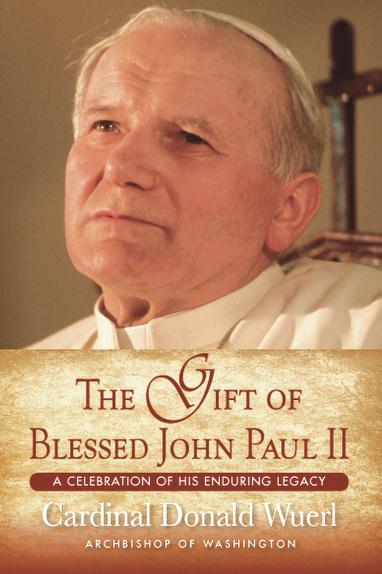
with the phrase: “The redeemer of man, Jesus Christ, is the centre of the universe and of history.”
Cardinal Wuerl noted that Pope John Paul brought this message to the world at a time of much confusion and doubt.
“He stepped onto the world stage and onto the platform of St Peter’s Basilica to remind the whole world that we don’t have to be afraid, there is truth, that God loves us, that Jesus is the way. And then for two and one-half decades, he went all over the world repeating that life-giving proclamation, ‘Be not afraid, the risen Christ is with us.’”
Before coming to Washington, the Cardinal was an Auxiliary Bishop of Seattle. He was ordained to the episcopacy in 1986 by Pope John Paul at St Peter’s Basilica in Rome. The new Bishop received from the Pope his personal mitre, one he had worn on a pastoral visit to Holland.
For Bishop Wuerl, that mitre remained “a powerful bond” with the Pope. The Bishop was then named to lead his home siocese of Pittsburgh in 1988, and was appointed as Washington’s Archbishop in 2006, the year after Pope John Paul’s death. In fall of 2010, Pope Benedict elevated Cardinal Wuerl to the College of Cardinals.
In 2003, then-Bishop Wuerl returned to Rome to concelebrate Pope John Paul’s Mass marking the 25th anniversary of his pontificate. “We all knew his health was failing, and I wanted to have one more chance to celebrate Mass with him,” Cardinal Wuerl said.

During his years as a Bishop, Cardinal Wuerl wrote articles and gave talks about Pope John Paul II’s encyclicals and apostolic exhortations soon after they were issued. Known for his work on behalf of Catholic education, the Cardinal wrote The Teaching of Christ and The Catholic Way, both best-selling catechisms for adults, and he co-wrote the new Doubleday book The Mass: The Glory, the Mystery, the Tradition Cardinal Wuerl also participated in two of the Synods of Bishops that formed the basis of Pope John Paul’s apostolic exhortations on the formation of priests and the Church in America.
Soon after the sainthood cause for Pope John Paul was launched, Cardinal Wuerl began reworking his articles and talks about the Pope’s writings, with the view of writing a book that would provide “a systematic presentation of his teaching.” In the book, Cardinal Wuerl notes how Pope John Paul, whose travels took him around the world to address millions of people, had the special ability to
make each man and woman in the audience feel as if he had spoken directly to them. In a similar way, the Cardinal hopes that the readers of The Gift of Blessed John Paul II, will “find something in the book that speaks to them.”
Pope John Paul’s 14 encyclicals and his seven apostolic exhortations that followed Synods of Bishops touched on “almost every aspect of human experience and the life of the Church,” said Cardinal Wuerl. “Those documents alone earn him the title ‘Great.’ There is no pontificate in the history of the Church that has produced the corpus of teaching that is the work of Pope John Paul II.” “What comes across more than anything else” in the Pope’s writings “is his pastoral heart ... He’s a pastor of souls,” the Cardinal said. He added that writing his book reminded him of his affection for Pope John Paul, whose “life, ministry and teaching I was privileged to witness firsthand as a priest and Bishop. In a way, this book is really a work of love.”
Late Pope’s holiness was clear even in private
VATICAN CITY (CNS)
- Two laypeople who saw Pope John Paul II in his most private moments not only support his beatification, but are absolutely convinced he’s a saint.
Arturo Mari, whose 53 years as a Vatican photographer included the entire pontificate of Pope John Paul, said, “He was a saint in life.” Working at the Vatican under six Popes, Mari knows “the Church rightly has its rhythm” for formally recognising someone as a saint, but there is not a doubt in his mind that that’s what Pope John Paul is.
Speaking to reporters on 29 April at Rome’s Pontifical Holy Cross University, Mari said that if forced to choose a favourite photo among the millions of shots he took of the late Pope, he would have to pick the picture of Pope John Paul embracing the crucifix in his private chapel on Good Friday in 2005, just eight days before he died.
“At a certain point, the Pope did something very beautiful: he placed the cross against his forehead and kissed the Christ and drew it to his heart,” Mari said.
“He used such strength to hold the cross that in the photo you see how red his fingernails are from squeezing it.”
Also speaking at Holy Cross University was Rita Megliorin, the chief nurse in the intensive care unit at Rome’s Gemelli Hospital when Pope John Paul was treated there early in 2005.
“More than John Paul the Great, he was John Paul the Simple, which was why he was able to communicate with everyone,” Megliorin said.
Nurse recalls Pontiff’s last moments on earth
Nurse says John Paul II took on the Cross of everyone who suffers
BY MARIAELENA F INESSI
ROME (Zenit.org) - “They called me in the late morning. I hurried because I was afraid that I would not arrive in time. Instead, he was waiting for me. ‘Good morning, Holiness, it’s sunny today,’ I said to him immediately because it was what he liked to hear when he was in the hospital.”
This is how Rita Megliorin, former head nurse of the recovery ward at Rome’s Gemelli Polyclinic, remembers the morning of 2 April when she was called to the papal apartment, to the sickbed of John Paul II, as he was dying.
Megliorin made her remarks on Friday to reporters at Rome’s University of the Holy Cross.
“I didn’t think that he would recognise me. He looked at me. It
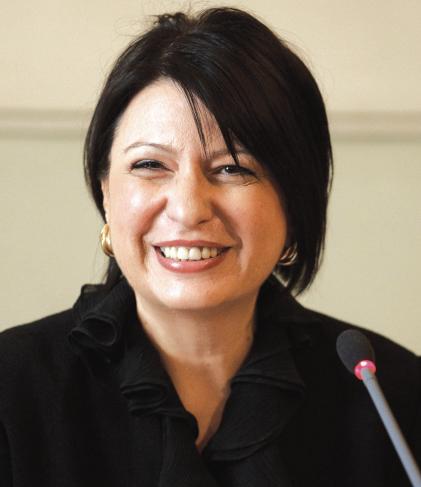
wasn’t that inquiring look that he used to have when he wanted to know immediately how his health was. It was a sweet gaze, which touched me,” she recounted.
“I felt the need to put my head on his hand, I allowed myself the luxury of receiving his last caress, laying his powerless hand on my face while he fixed his eyes upon the picture of the suffering Christ
that hung on the wall in front of his bed.”
Hearing the increasing volume of the singing, prayers, and acclamations of the young people in St Peter’s Square the nurse asked the Pope’s secretary, Cardinal Stanislaw Dziwisz, if the noise didn’t bother the Pope. “But he, taking me to the window, said: ‘Rita, those are the children who have come to greet the father.’”
Megliorin first met the Pope at Gemelli in January 2005. Coming to work one day, and not thinking about the Pope being there, she said that she was told to make haste to the 10th floor because there was “an important patient. Think of a place where there is no space and where there is no time, and think only of a lot of light.” This is what it was like being with John Paul II.
“During those months, every morning I came into the room to find him already awake because he had already been praying since 3. I would open the blinds and say ‘Good morning, Holiness, it’s sunny today.’ He would turn to me
and bless me. I would kneel and he would touch my face.”
This was the ritual that started the Holy Father’s days.
“Beyond that, I was an inflexible nurse and he was an inflexible patient. He wanted to be updated on everything, the sickness, its gravity. If he didn’t understand, he would give me a look that suggested a request for a better explanation.
“He never ceased to study man’s problems. I remember the books on genetics, for example, that he consulted and studied attentively, even in the condition that he was in. Every day he told us [that] ‘every problem has a solution.’
“And, like every father, he had a love for the weakest. For example, at WYD in Rome at Tor Vergata, he greeted the kids who were in the back, thinking that they weren’t able to see much. In the hospital, too, he occupied himself with unimportant people and not with the great professors; he asked about their families, if they had children at home.
“The Pope endured what were perhaps the most difficult moments
at the Polyclinic,” she observed, but added that “helping the sick is a gift, at least for those who believe in God. But it is a singular experience for non-believers too.”
Asked whether any particular film about the life of the Pope corresponded to what really went on in his dying moments, she responded with the question of whether anyone in the room had held a dying parent in their arms.
“I can’t answer,” she said reluctantly. “Whoever hasn’t experienced it can’t understand.”
Another reporter asked whether death was a relief. “Death is never a relief,” she replied. “As a nurse, I can only say that there is a limit to care beyond which it becomes heroic.”
John Paul II, “in the last moment of his life,” Megliorin concluded, “took up his cross, taking on not just his own [cross] but that of all those who suffer.
“He did it with the joy that is born of the hope of believing in a better tomorrow. In fact, I think that for him it was already the hope in a better today.”
BLESSED POPE JOHN PAUL SOUVENIR EDITION
Rita Megliorin
Franciscan nuns from Bologna, Italy, walk past a giant image of Pope John Paul II in St Peter’s Square at the Vatican on 28 April. Pope John Paul was beatified on 1 May at the Vatican. Left, the book by Cardinal Donald Wuerl inspired by John Paul II.
PHOTO: CNS/PAUL HARING
JPII Institute: building on John Paul II’s legacy in Australia

 BY ANTHONY COYTE AND GERARD O’SHEA
BY ANTHONY COYTE AND GERARD O’SHEA
Blessed Pope John Paul II was a man who, quite literally, changed the world. His influence on world events in the 1980s, especially the collapse of Communism in Eastern Europe, is widely acknowledged today.
He was the one who, in those early years of his pontificate, lit the flame that ignited the Polish people’s resistance to the totalitarian regime that had suppressed their identity and their freedom for decades.
Pope John Paul II encouraged them to stand firm in their Christian heritage and to let the values derived from that heritage transform the society in which they lived.
Yet there was also another way in which he changed the world and in which his legacy continues to do so. One theme that captured Karol Wojtyla’s heart long before his election as Pope was the dignity and greatness of human love.
In his book Crossing the Threshold of Hope (see advertisement on back page of liftout), John Paul II said that as a young priest he “learned to love human love”. His work as a young priest and university professor led him to form close friendships with many young married couples.
Through such friendships, he developed a great appreciation for the beauty of married love and had a desire to help married couples live their vocation to the full.
From these early experiences, Karol Wojtyla developed a lifelong pastoral and academic interest in marriage and family, resulting in the publication of many books on this topic. Among his early works were the 1960 play The Jeweller’s Shop, centred on the lives of three married couples, and the philosophical work Love and Responsibility, also published in 1960, which presented a groundbreaking analysis of the different dimensions of human love. Yet it wasn’t until Wojtyla was elected to
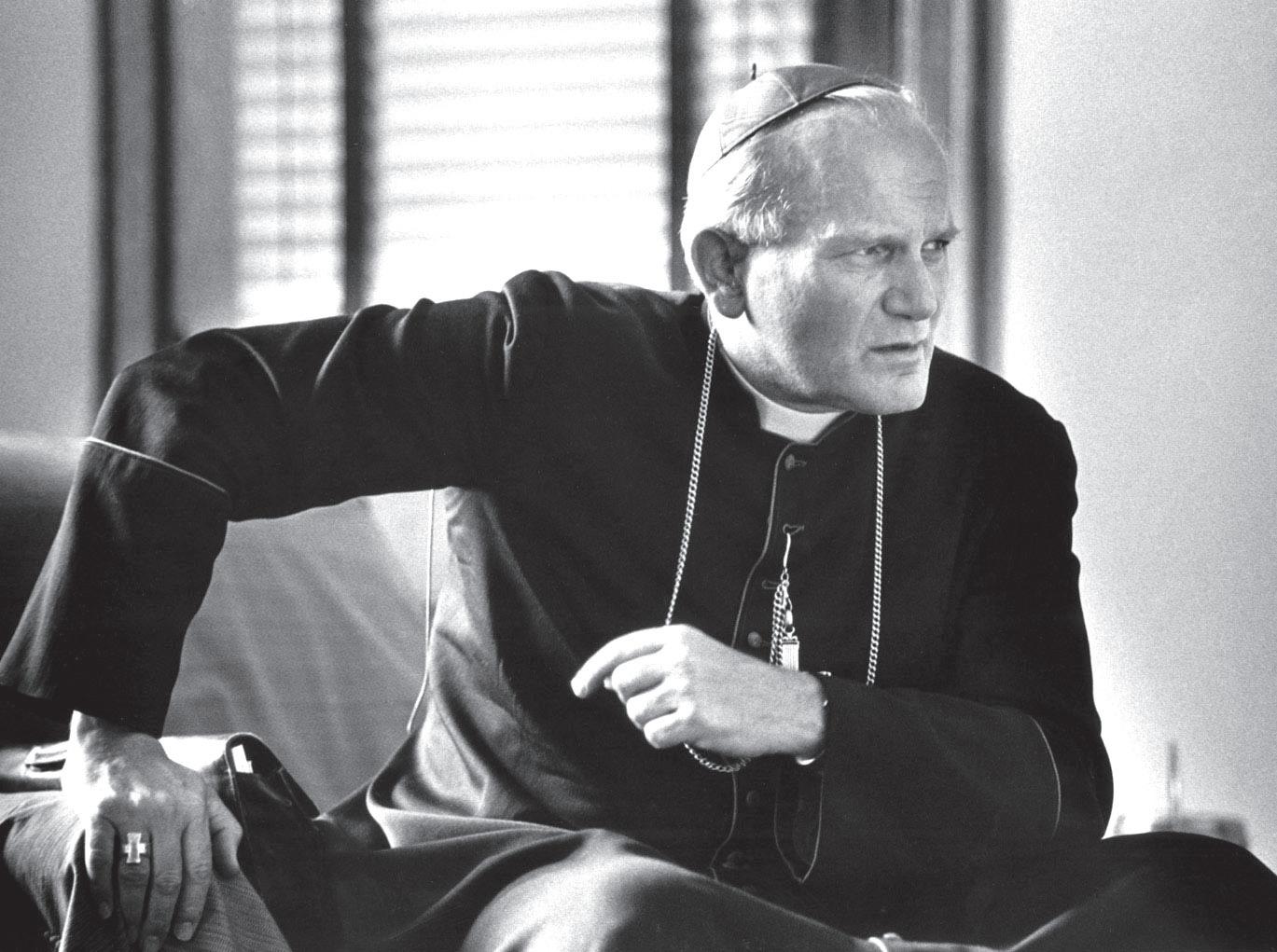
Pope’s war on culture lives on in Australia
the papacy in 1978 that people in the Church began to discover what profound reflections on marriage and family this Polish prelate had to offer.
Over the 27 years of his papacy, marriage and family was a major theme in many of his key writings as Pope, such as Familiaris Consortio (1981), Letter to Families (1994), Evangelium Vitae (1995) and the now well-known Theology of the Body general audience addresses, delivered between 1979 and 1984. (Marriage and family was also the theme of his homily when he celebrated Mass at Belmont Park racecourse in Perth on 30 November 1986.)
What must be asked is why this topic occupied such a central place in John Paul II’s writing and preaching. Was it just a personal
interest? Why did he feel the need to continually return to the topic?
Perhaps John Paul II could see that the emerging battle for the Church in the Western world be one that is focused on marriage and the family. In today’s increasingly secular culture, it is not difficult to find confirmation of this. Most of the criticism directed to the Church today concerns marriage, family, sexuality and life matters. From another perspective, one only needs to open a newspaper on any given day to see that marriage and family breakdown leads to many other problems in society, such as depression, substance abuse and violence. For as John Paul II wrote on so many occasions, the family is the fundamental cell of society. When this fundamental cell is threatened or damaged, the
negative consequences will be farreaching
On 13 May 1981, the world was shocked by an event unprecedented in modern times: an attempt had been made to assassinate the Pope and his life was hanging in the balance. Much of what was written about the assassination attempt at the time (and subsequently) has failed to mention something of great significance. What else was special about this day? Many would be aware that it was the anniversary of the appearance of the Blessed Virgin Mary at Fatima in 1917. In terms of the legacy of John Paul II to the Church, however, it was the day that he had set aside for the foundation of the John Paul II Institute of Marriage and Family.
John Paul II was not satisfied
that simply writing about issues of marriage and family would be sufficient. He was determined to set up a high level and ongoing academic institution to ensure that these matters would be contested in the realm of ideas. What became known as the John Paul II Institute of Marriage and Family was set up as an entity within the Pontifical Lateran University. The choice of the Lateran was significant; most Pontifical universities are under the direction of Religious Orders or other Catholic organisations, but the Lateran University is responsible directly to the Pope –it is his own university.
It was the wish of Pope John Paul II that these Institutes should spread to every continent in order to address local concerns directly. Little by little, sessions of the Institute spread around the world from their central base in Rome: in Washington DC, Mexico City; Savador Bahia (Brazil); Changanacherry (India); Cotonou (Benin). The last of these continents, Oceania, was added in 2001 when the Australian session opened in Melbourne.
The beatification of John Paul II is of great significance to these Institutes throughout the world, including our own Australian session. The Melbourne Institute has been represented at the ceremony by its dean, Associate Professor Tracey Rowland. Shortly afterwards, Professor Rowland will be joined by other Melbourne Institute staff – Director Bishop Peter Elliott and lecturers Dr Adam Cooper and Dr Gerard O’Shea who will gather in Rome for a conference of all sessions of the John Paul II Institute. The highlight of the conference will be a private audience and allocution from Pope Benedict XVI in the Sistine Chapel.
The Melbourne JPII Institute has already had a dramatic impact on the intellectual arguments about marriage and family issues in this country. Over 100 graduates with higher level degrees have been trained and are working in significant roles throughout the country, in the Pacific Islands and New Zealand, in East and South East and even in Canada and the US.
Closer to home, there are already half a dozen young graduates from Perth – Owen Vyner, Lydia Fernandez, Natalie Thomas, Jing Ping Wong, Grant Gorddard and Anthony Coyte.
For the Institute in Melbourne, John Paul II’s beatification is a great source of encouragement as it strives to build upon John Paul II’s legacy and form a culture of life and love here in Australia.
Not all Popes are automatically saints
VATICAN CITY (CNS)Considering the fact that they are elected to lead people in prayer, mission and good works, surprisingly few Popes have been beatified or canonised, especially in the last 500 years.
From St Peter to Pope Benedict XVI, there have been 265 Popes; 72 of them are saints, and Pope John Paul II’s beatification brings to 11 the number of Popes known as blessed. With all those holy Popes - including the first 35 Bishops of Rome - it would seem that the beatification of Pope John Paul could not set any records or be a first of any kind.
Yet his is the quickest beatification since 1588 when the modern sainthood process, regulated by the Vatican, began. Many of the “blessed” Popes were beatified on significant anniversaries of their death like Blessed Victor III, who died in 1087 and was beatified in
1887, or Blessed Urban V, who died in 1370 and was beatified in 1870. Pope John Paul was set to receive the recognition six years and 29 days after his death. His process was shorter than the beatification process for Mother Teresa of Calcutta by about two weeks.
Both causes benefited from a papal exemption from the Vatican rule that five years must pass between a person’s death and the opening of his or her sainthood cause. Pope John Paul set the precedent by waiving the fiveyear waiting period for Blessed Teresa’s cause; Pope Benedict set aside the waiting period for Pope John Paul’s cause.
In newspapers, on television and on blogs leading up to the 1 May ceremony, the short time lapse between Pope John Paul’s death and his beatification became a topic of debate. The
“pro” side generally argued that the late Pope’s holiness was so clear to so many people that the Vatican had to respond to the sensus fidelium, the sense of the faithful. The “con” side tended to argue that an acclamation of holiness needs to stand the test of time and six years just isn’t enough. In the causes of both Mother Teresa and Pope John Paul, the Vatican said the waiting period was the only part of the normal process that was skipped. Eyewitnesses - including those with doubts - were interviewed, writings were studied, a massive biography was prepared and the Vatican looked for miracles to confirm that both were in heaven and able to intervene on behalf of the faithful.
Interestingly enough, though, both causes benefited from some streamlining of the sainthood process ordered by Pope John
Paul in 1983. Instead of two miracles for beatification and two more for canonisation, he reduced the number of miracles needed to one for each step.
The 1 May beatification also marked the first time in almost 1,000 years that a Pope beatified his immediate predecessor, according to Giovanni Maria Vian, a Church historian and the editor of the Vatican newspaper, L’Osservatore Romano
Pope Leo IX, who died in 1054, and Pope Gregory VII, who died in 1085, were recognised as saints immediately upon their deaths, he said. Unlike the entries for later saintly Popes in the Vatican’s yearbook, the Annuario Pontificio, the listings for those two Popes do not contain specific canonisation dates. However, some sources say Pope Leo wasn’t formally canonised until 1082 and Pope Gregory wasn’t confirmed a saint
until 1728. In what passes for quick at the Vatican, St Celestine V was canonised only 19 years after he died, but two Popes had served between his death and his recognition as a saint by Pope Clement V in 1313, Vian wrote. The earliest Popes were martyred for their faith, which the Catholic Church takes as a clear sign of holiness.
But once the persecution of the Church ended and the papacy gradually gained political influence and, then, actual temporal power, the clusters of Pope’s names with the title “Saint” before them gets thinner and thinner.
In 2000, Pope John Paul beatified Popes Pius IX (who died in 1878) and John XXIII (who died in 1963). The sainthood causes for Blessed John’s two successors, Popes Paul VI and John Paul I, is continuing, as is the cause for Pope Pius XII, who died in 1958.
BLESSED POPE JOHN PAUL SOUVENIR EDITION
Cardinal Karol Wojtyla responds to questions during an interview at The Catholic University of America in Washington on 29 July, 1976. During his visit, the future Pope John Paul II celebrated Mass with Cardinal William W Baum of Washington and presented a lecture concerning the nature of freedom to faculty and students in the department of psychology. His legacy of challenging prevailing attitudes towards humanity, particularly sexuality, lives on in the John Paul II Institute of Marriage and Family Studies in Melbourne.
PHOTO: CNS/MAR VIN T JONES
Beatification? Canonisation? What are they?
Holy confusion? Beatification, canonisation are different
By Cindy Wooden Catholic News Service
VATICAN CITY - The slight differences between a beatification and a canonisation are easy to miss, especially when one Pope beatifies another Pope.
Just three weeks before Pope Benedict XVI was to beatify Pope John Paul II, the Congregation for Divine Worship and the Sacraments issued a decree designed, in part, to maintain the distinction.
The decree dealt with one of the three main differences: the number and location of dioceses that can hold annual public liturgical celebrations in the holy person’s honour.
The other two differences are less noticeable and they deal with who ceremonially requests the Pope to act and the level of papal authority involved in the proclamation.
During a beatification ceremony, the Bishop of the diocese where the person dies asks that the candidate be declared blessed; at a canonisation, the prefect of the Congregation for Saints’ Causes speaks in the name of the whole
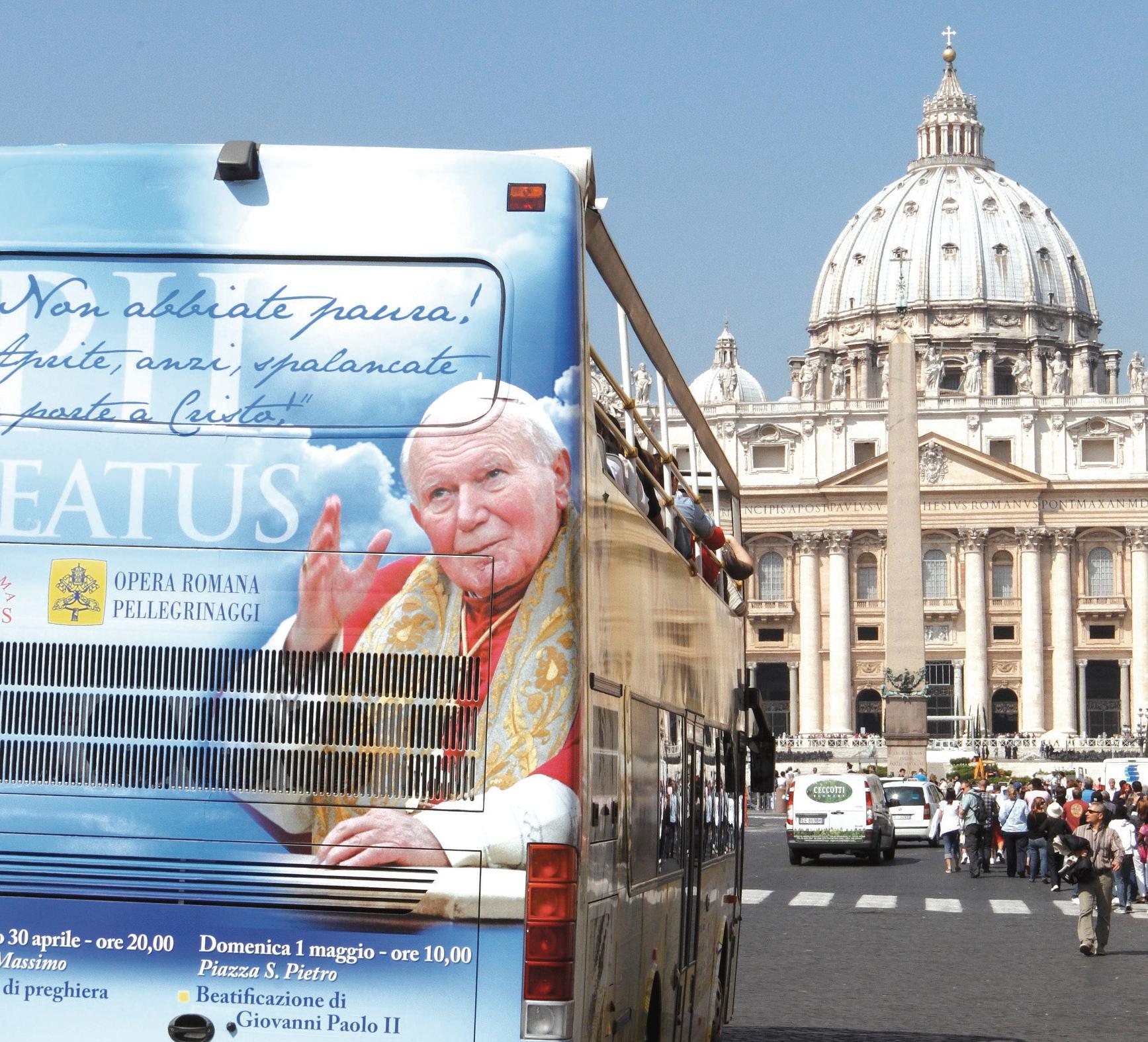
Church and asks that the candidate be declared a saint.
Even less visible, but more important, is the fact that “papal infallibility is involved” when a person is declared a saint, said Cardinal Agostino Vallini, the papal vicar of Rome.
Beatification is an “administra-
tive act” by which the Pope allows a candidate for sainthood to be venerated publicly in places closely associated with his or her life and ministry; the place may be as small as one city, although usually it is the diocese where the person lived or died.
In the case of Pope John Paul,
his 22 October feast day is entered automatically into the calendars of the Diocese of Rome and all the dioceses of his native Poland.
A canonisation, on the other hand, is a formal papal decree that the candidate was holy and is now in heaven with God; the decree allows public remembrance of the saint at liturgies throughout the Church.
It also means that churches can be dedicated to the person without special Vatican permission.
Beatifications only became common in the early 1600s after the Vatican centralised the sainthood process.
The centralised process meant dioceses could wait many years or decades to celebrate one of their own as a saint, so to acknowledge the local devotion to the candidate, the Popes would give the candidate the title blessed and allow limited devotion.
For hundreds of years, the most obvious difference between a canonisation and beatification was the fact that the Pope personally presided only at a canonisation Mass.
Those lines began to blur during the pontificate of Pope Paul VI, who decided to celebrate the beatification in 1971 of Polish Franciscan Fr Maximilian Kolbe, who was martyred in a Nazi concentration camp.
Pope John Paul II kept up the practice of personally presiding over both beatifications and can-
onisations - and he did so hundreds of times all over the world.
Pope Benedict XVI, responding to pleas from some Vatican officials, Bishops and theologians, tried to help people actually see the difference between a beatification and a canonisation by presiding personally only when a new saint was being proclaimed.
For more than five years, he maintained that practice. But in September, he led the beatification Mass in England for John Henry Newman. The second beatification of his pontificate was the proclamation of Blessed John Paul.
Procedurally, a miracle - literally - is needed for a blessed to be declared a saint.
For beatification, the Vatican requires proof of a miracle attributed to the candidate’s intercession, unless the candidate was martyred for his or her faith. The second miracle - the one needed for canonisation - must take place after the beatification ceremony and is seen as God’s final seal of approval on the Church’s proclamation.
“In addition to reassuring us that the servant of God lives in heaven in communion with God, miracles are the divine confirmation of the judgement expressed by Church authorities about the virtuous life” lived by the candidate, Pope Benedict said in a speech to members of the Congregation for Saints’ Causes in 2006.
An accessible saint and his love of mangos

For many, Pope John Paul’s humanity made him a more accessible saint
By John T havis Catholic News Service
VATICAN CITY - One of the most curious tributes in the run-up to Pope John Paul II’s beatification came from Mexico, where Church officials recalled the late Pope’s love for mangos.
During his first trip to Mexico in 1979, the Pope enthused about the Latin American fruit, and his Mexican hosts began preparing dishes that used the mango in every possible way. Afterward, they regularly sent boxes of mangos to the Vatican so there would always be some on the Pope’s table.
Even when Pope John Paul was
very ill toward the end of his life, the late Cardinal Ernesto Corripio Ahumada of Mexico City sent him mangos - and called the deputy secretary of state to make sure the Pope had received them.
The story, recounted by the Vatican missionary news agency Fides on 28 April, may seem marginal, but it offers insight into the ways Pope John Paul connected with people of every place and culture. His spiritual intensity may have made him a saint, but his humanity made him a saint to whom they could relate.
Throughout his 26-year pontificate, Pope John Paul paid attention not only to world leaders but also to the “little people” and what was on their minds. On his journeys outside the Vatican, he would chat with workers, visit the sick and make pilgrimage to even the most humble of local shrines.
More than once, he stepped off the official papal motorcade route
to drop in on families in Africa and Latin America. He sipped tea in their huts and once, after visiting a Brazilian shantytown, he took off his papal ring and left it to be sold for the benefit of the local residents. He opened a hostel for the poor inside the Vatican, and personally hosted the homeless for holiday dinners. In Rome, he visited the most out-of-the-way parishes and spent the better part of his Sundays with parishioners.
Everywhere he went, Pope John Paul seemed to imbibe the local culture and embrace its expressions. He did this in the simplest of gestures: donning a tribal headdress in Kenya, swinging a hockey stick in St Louis or drinking a pepperroot brew from a coconut shell in Fiji. He did it through words, routinely taking language lessons before his travels. In Tanzania in 1990, thanks to a cassette tape he dutifully toted en route, he was able
Ocean Reef marks beatification

OCEAN
Parish priest Fr Dariusz (Darek) Krzysztalowicz SDS is photograhed here at a prayer focus with a couple of parishioners.
There was also a movie night with a film celebrating the life of Pope John Paul II on the Sunday evening.
to charm and amaze his listeners in near-perfect Swahili.
During public ceremonies, Pope John Paul put people at their ease, often with a sense of humour. When he held hands and danced onstage with young people in Australia in 1986, one of the girls began to cry.
The smiling Pope hugged her and said simply, “Don’t worry.”
Carl Anderson, the supreme knight of the Knights of Columbus, was impressed with the way Pope John Paul patiently greeted the sick and disabled at his public events, chatting with them one by one and blessing them. He was not going through the motions; he was interested in them.
“These were small actions that were not necessary and not expected. It was something he was doing that was different, personal and made that person feel very special with the encounter,” Anderson said.
The late Pope routinely went outside the traditional boundaries
of the papacy, in things big and small. He was the first modern Pope to visit a synagogue, a fact that’s remembered with affection by the Jews in Rome’s ancient “ghetto” neighbourhood. Many of them keep a photo of the Polish Pope in their shops.
One of his favourite Christmas meetings was with Rome’s garbage collectors and street sweepers, who would welcome him to their nativity scene near the Vatican.
He never gave a speech, and instead joked with them about getting direct orders from God not to skip their annual encounter.
Pope John Paul was, of course, serious about evangelising. But he seemed to recognise that evangelisation was easier after building bridges with people in every walk of life. Sometimes he did it by giving a speech.
And sometimes he did it by slipping on a rock star’s sunglasses, or savouring a mango.
BLESSED POPE JOHN PAUL II SOUVENIR EDITION
An image of Pope John Paul II is seen on the back of a bus outside St Peter’s Square at the Vatican on 28 April. Pope John Paul was beatified on 1 May at the Vatican.
PHOTO: CNS/PAUL HARING
A woman holds a calendar with an image of the late Pope John Paul II during an event in Mexico City’s Azteca Stadium to mark the sixth anniversary of his death on 2 April.
PHOTO: CNS/JORGE DAN LOPEZ, REUTERS
Reef Parish in Perth organised a special prayer and Powerpoint presentation to mark Pope John Paul’s beatification on 1 May with a special Mass.
Agent of mercy gives answer to suffering
Apostle of Divine Mercy: Beatification date emphasises John Paul II’s legacy
BY JESÚS COLINA
ROME
(Zenit.org)
- Benedict XVI’s choice of 1 May for the beatification of his predecessor is itself one of the richest symbols in the celebrations.
This year’s feast of Divine Mercy - coinciding with the end of the Easter Octave - lands on 1 May, since Easter was so late this year. Thus, the feast falls on the first day of Mary’s month.
On various occasions, Cardinal Joseph Ratzinger, now Pope Benedict XVI, proposed that the fundamental element of Pope John Paul II’s legacy in the Church is his understanding of Divine Mercy as the factor limiting human evil.
Celebrating the Polish Pope’s funeral, Cardinal Ratzinger reflected that the Holy Father “interpreted for us the paschal mystery as a mystery of divine mercy.” In his last book, he wrote: The limit imposed upon evil ‘is ultimately Divine Mercy’ (Memory and Identity, pp 60-61).
Reflecting on the assassination attempt, he said: ‘In sacrificing himself for us all, Christ gave a new meaning to suffering, opening up a new dimension, a new order: the order of love ... It is this suffering which burns and consumes evil with the flame of love and draws forth even from sin a great flowering of good’ (pp 189-190).”
The Cardinal added: “Divine Mercy: the Holy Father found the purest reflection of God’s mercy in the Mother of God. He, who at an early age had lost his own mother, loved his divine mother all the more. He heard the words of the crucified Lord as addressed person-


only Son. We are the risk of God. But a risk that is overcome with the infinite power of Divine Mercy.
John Paul II prepared a message for Divine Mercy Sunday of 2005, which he never delivered, since on the eve of the feast he was called to the Father’s House.
The text was read at the end of the Mass celebrated that day for the repose of his soul.
ally to him: ‘Behold your Mother.’ And so he did as the beloved disciple did: ‘he took her into his own home’ (eis ta idia: Jn 19:27) –Totus tuus. And from the mother he learned to conform himself to Christ.”
Karol Wojtyła suffered the two totalitarian regimes of the 20th century, Communism and Nazism, and asked how God could permit such terrible atrocities.
But while many would point to these evils to deny God’s existence or negate his goodness, John Paul II used them to reflect on what God teaches by permitting man’s free will to bring about tragedy. And he
found an answer in Divine Mercy, as presented in the writings of the Polish mystic, St Faustina Kowalska (1905-1938).
St Augustine explains that God never causes evil, but permits it. In creating man with liberty, God accepted the existence of evil. Would it have been better for God not to create man? Or to create him without liberty?
No. But then, the Polish youth who would one day take St Peter’s throne asked himself: What can limit evil so that it doesn’t have the last word?
John Paul II understood that Divine Mercy is this limit to evil.
His mercy does not imply that everyone is saved automatically, thereby negating sin, but rather that God pardons every sinner who allows himself to be pardoned.
And if pardon is the limit to evil (how many lessons could be taken from this truth to overcome war), then liberty in a sense conditions Divine Mercy.
God in some way took a great risk in creating man with freedom.
He risked that His love would be rejected and that man would be able to negate the truth of his liberty and kill and abuse his brother.
But in answer, God paid the most terrible price: the sacrifice of His
No black mark on JPII by Legion
ROME (CNS) - At the door of the Pontifical Regina Apostolorum University, priests and seminarians prepared to welcome former Vatican officials and other important guests. Inside the auditorium, the rector checked the final details of the three hour long multimedia tribute to Pope John Paul II.
Onstage, 30 children from the order’s elementary school held white roses in front of a portrait of the late Pope and rehearsed in unison: “John Paul II, we love you!”
Like other Religious communities in Rome, the Legionaries of Christ joined in the joy and enthusiasm of Pope John Paul’s beatification.
They seemed untroubled by critics who view the sex abuse scandal of the Legionaries’ founder, the late Mexican Fr Marcial Maciel Degollado, as a black mark on Pope John Paul’s pontificate.
“The Vatican cleared all this up. The postulator (of Pope John Paul’s sainthood cause) cleared it up. They did an investigation and said that the Pope had nothing at all to do with this episode,” said Fr Pedro Barrajon, the rector of the Legionaries’ university.
Fr Barrajon said the fallout from the sex abuse revelations about Fr Maciel did not diminish the happiness felt by priests and seminarians at the late Pope’s beatification.
“At least for me, it’s not a problem,” he said.
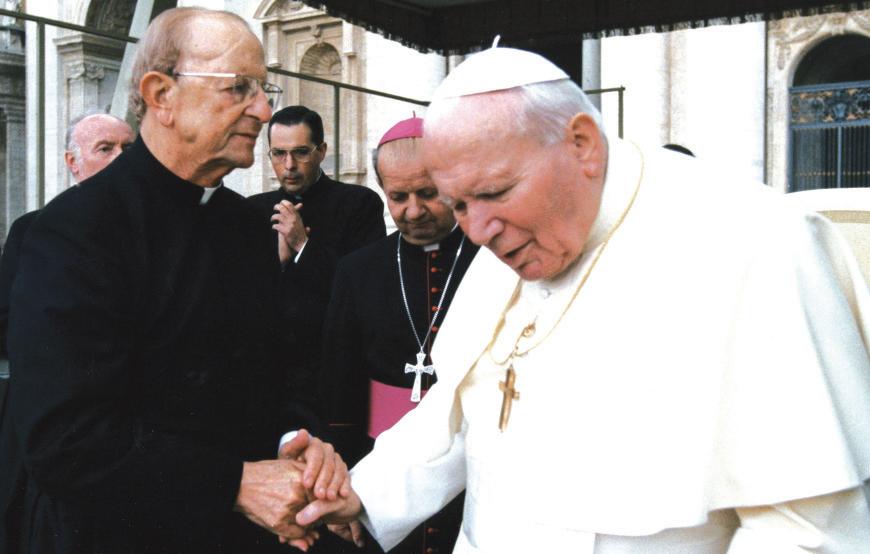
Pope John Paul was one of Fr Maciel’s biggest supporters. In 2004, at a Vatican encounter marking the 60th anniversary of Fr Maciel’s ordination, the Pope warmly greeted him and said the priest’s ministry had been “full of the gifts of the Holy Spirit.”
A year after Pope John Paul died, after investigating allegations that Fr Maciel had sexually abused young seminarians, the Vatican ordered the priest to stop practicing his ministry in public and to live a life of prayer and penitence.
After his death in 2008, the Legionaries revealed that Fr Maciel had fathered a daughter and later acknowledged that he had abused seminarians. George Weigel, the US biographer of Pope John Paul II, has said he believes the late Pope was, like many others, deceived by Fr Maciel. He said there’s not a shred of evidence to support the idea that Pope John Paul knew of the abuse and did nothing about it.
That view is shared by most officials at the Vatican, who believe that critics who have focused on
Fr Maciel are distorting Pope John Paul’s record as Pope and missing the point of his beatification.
A Legionary priest who attended the 29 April tribute to Pope John Paul agreed. While the revelations about Fr Maciel have been painful, he said, they haven’t affected the admiration and esteem people feel for Pope John Paul.
The priest, who asked not to be identified, acknowledged that spirits at the Legionaries’ headquarters were a bit “dampened” these days, as the Order undergoes a thorough investigation and reform ordered by Pope Benedict XVI. But as hard as it is for the Legionary priests and seminarians, he said, “maybe it had to happen this way.”
There was no sign or mention of Fr Maciel as the tribute to Pope John Paul got under way.
The founder’s photo has been removed from the walls of the seminary and university, and Legionary books and other publications were under review to make sure there is no “inappropriate reference” to Fr Maciel.
There was one minor exception at the 29 April event, probably unnoticed by the organisers. A Legionary booklet on Pope John Paul, printed in 2005 and available at the auditorium entrance, closed with a quotation from Fr Maciel extolling the spiritual qualities that made Pope John Paul a saint.
“As a gift to humanity, which sometimes seems bewildered and overwhelmed by the power of evil, selfishness and fear, the Risen Lord offers His love that pardons, reconciles and reopens hearts to love. It is a love that converts hearts and gives peace. How much the world needs to understand and accept Divine Mercy,” John Paul II had written.
Today’s beatification ceremony began with a remembrance of the Polish Pontiff’s devotion to God’s Mercy.
Thousands of pilgrims packed into St Peter’s Square and overflowing through the streets of Rome prayed the Chaplet of Divine Mercy, the devotion promoted by St Faustina.
The image of Divine Mercy was displayed in front of the Basilica until the beatification Mass began.
Poles protest JPII Basilica
RESIDENTS of Poland’s northern port city of Gdansk have staged protests against a new “Basilica of Blessed John Paul II” on a site newly dedicated by the local Archbishop. “There are already six churches in this district,” the group from Gdansk told Poland’s Gazeta Wyborcza daily on 21 April. “When we bought our apartments here, we checked the development plans and found there were to be much-needed social services here. We don’t understand how a decision was taken without our knowledge to hand this city land over to religious uses.”
The new basilica is to be modelled on St Peter’s Basilica in Rome. However, the complaints were dismissed by Archbishop Slawoj Glodz of Gdansk who blessed a cross on the land on 19 April to mark the start of construction. “They should be ashamed: this is a vote of thanksgiving to the Pope,” Archbishop Glodz told Radio Gdansk. “The city and its suburbs are expanding and public utility objects are being built, including churches. We live in a Catholic country, and I’ve received many positive opinions about this church.” -CNS
BLESSED POPE JOHN PAUL II SOUVENIR EDITION
Pope John Paul II lies injured in his jeep in St Peter’s Square after being shot by Turkish gunman Mehmet Ali Agca in this 13 May 1981 file photo. The late Pope used modern-day examples of evil such as Nazism and Communism to reflect on what God teaches by permitting man’s free will to bring about tragedy. The answer is found in Divine Mercy, as presented in the writings of Polish Mystic St Faustina Kowalska.
PHOTO: CNS
A scan of a badly deteriorated negative of Pope John Paul II meeting his would-be assassin, Mehmet Ali Agca, in a Rome prison on 27 December 1983.
PHOTO: CNS
Fr Marcial Maciel Degollado, founder of the Legionaries of Christ, greets Pope John Paul II in St Peter’s Square in this 2000 file photo. Pope Benedict XVI ordered an apostolic visitation of the institutions of the Legionaries of Christ following disclosures of sexual impropriety by Fr Maciel. PHOTO: CNS/CATHOLIC PRESS

Learn more about our
Blessed Pope John Paul II






Pope John Paul II
Memory & Identity
RRP $35.95
A truly historical document, Memory and Identity contains Pope John Paul II’s personal thoughts on some of the most challenging issues and events of his turbulent times. Pope for over 26 years, he was one of the world’s greatest communicators and this moving book provides a unique insight into his intellectual and spiritual journey and pastoral experience. Each chapter suggests the answer to a question which either exercised his mind or which he provoked in discussion with laymen and priests. Using the encounters at his summer residence of Castel Gandolfo where conversations took place with leading intellectuals - philosophers as well as theologians - Pope John Paul II addressed in his book many of the questions which arose from these discussions. Here, he leaves for posterity an intellectual and spiritual testament in an attempt to seek the answer to defining problems that vex our lives.
Rise, Let us be on our Way: John Paul II
RRP $29.95
Following the international bestseller Crossing the Threshold of Hope , Pope John Paul II provides the world with a glimpse into his past in Rise, Let Us Be On Our Way. Chronicling the years he spent as a Bishop and later, Archbishop, in Krakow, through to his election as the first Polish Pope in 1978, he recounts everything from Communist attempts to suppress the Church in Poland to his efforts to adopt a new and more open style of pastoral ministry. With recollections about his life as well as his thoughts on the issues facing the world now, Pope John Paul II offers words of wisdom in this book that will appeal to people of any faith looking to strengthen their spirituality.



Crossing the Threshold of Hope
His Holiness John Paul II
RRP $22.95
A great international bestseller, the book in which, on the eve of the millennium, Pope John Paul II brings to an accessible level the profoundest theological concerns of our lives. He goes to the heart of his personal beliefs and speaks with passion about the existence of God; about the dignity of man; about pain, suffering, and evil; about eternal life and the meaning of salvation; about hope; about the relationship of Christianity to other faiths and that of Catholicism to other branches of the Christian faith.With the humility and generosity of spirit for which he is known, John Paul II speaks directly and forthrightly to all people. His message: Be not afraid!

The End and the Beginning
George Weigel
RRP $40.95
World-renowned author and NBC Vatican analyst George Weigel begins his long-awaited sequel to the international bestseller Witness to Hope: The Biography of Pope John Paul II
More than ten years in the making, The End and the Beginning: Pope John Paul II - The Victory of Freedom, the Last Years, the Legacy tells the dramatic story of the Pope’s battle with Communism in light of new and recently disclosed information and brings to a close Weigel’s landmark portrait of a man who not only left an indelible mark on the Catholic Church, but also changed the course of world history.



Theology OF THE BODY for Teens
Jason and Crystalina Evert and Brian Butler RRP $42.95
Young Catholics are surrounded by influences that challenge their faith and morals every day. These challenges call for more than a “do this, don’t do that” approach to catechesis. Teens desire truth and understanding about who they are, their purpose in life, and what will ultimately bring them happiness.
Theology of the Body for Teens presents the two hottest topics on the planet - God and sex - and “marries” them through Pope John Paul II’s compelling vision for love and life.

BLESSED POPE JOHN PAUL II
Record Bookshop
The
Telephone: 9220 5901 Email: bookshop@therecord.com.au Address: 21 Victoria Square, Perth 6000 BIBIANA KWARAMBA Bookshop Manager
 BLESSED POPE JOHN PAUL II SOUVENIR EDITION
BLESSED POPE JOHN PAUL II SOUVENIR EDITION



 By Anthony BArich
By Anthony BArich































































































































 BY BRIDGET SPINKS
BY BRIDGET SPINKS




















 By Bernard Toutounji
By Bernard Toutounji
























 BY ANTHONY BARICH
BY ANTHONY BARICH




 BY ANTHONY COYTE AND GERARD O’SHEA
BY ANTHONY COYTE AND GERARD O’SHEA
















